THREE ARTISTS
PUSHKIN COLLECTION
THE AVANT GARDE OF POSTWAR RUSSIAN ART


THE AVANT GARDE OF POSTWAR RUSSIAN ART

Kenneth Pushkin first traveled to Russia in early 1992, just after the borders imposed during the cold war had been opened. Arriving in Moscow, he was embraced by Admiral Alexander Sergeevich Pushkin, namesake of the great poet and leading figure of the noble Pushkin family in Russia.
The Admiral guided Kenneth in establishing the bilateral (Russia / U.S.) non-profit Pushkin Fund. The Pushkin Fund raised charitable monies for a range of causes through high visibility events, including the Stanford University Pushkin Conference, gala ballet and theatre performances, and the annual Pushkin Golden Autumn Ball at Catherine’s Palace in St. Petersburg. Engaging in cultural diplomacy, Kenneth interfaced with the Russian and U.S. Ambassadors to organize diplomatic Pushkin tribute events at their respective residences. The goodwill of these efforts opened doors to the highest levels of Russian culture and importantly to leading museum directors.
The years from the mid-1990s through the early 2000s, presented a window of openness to the West and a flourishing cultural exchange. It was in this time frame that Kenneth, with the help the State Russian Museum, was uniquely positioned to take advantage of a once-in-a-lifetime opportunity to acquire and export this extraordinary and extensive body of work. With the support of the Russian Ministry of Culture, the notoriously difficult process of exportation was waived, and express permission was granted to ship the collected works to the U.S. in a series of large tranches over a period of years. Such is the history of the acquisition of these works in Russia and the valuable provenance of the collection.
To present the works to the public, the Pushkin Gallery was opened in the cultural center of Santa Fe, New Mexico, and quickly became an internationally recognized must-see destination, with its outstanding and unique collection of Postwar Russian art.
On the cusp of the pandemic, the Pushkin Gallery closed its doors, and the collection was relocated to a customized fine art repository in Albuquerque, New Mexico for continued research and development.
Now, as the years go by, the oeuvres of these historic artists are increasingly appreciated internationally for their important, rare, and beautiful contribution to the canon of Modern Art.
NIKOLAI TIMKOV
Цветущие болота (Flowering Wetlands)
Oil on Panel,1959, 24 × 20 inches (60 cm × 50 cm)
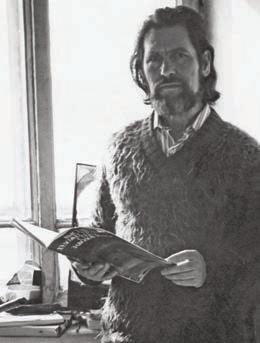
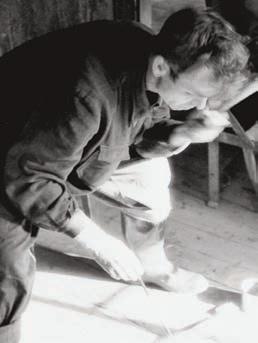
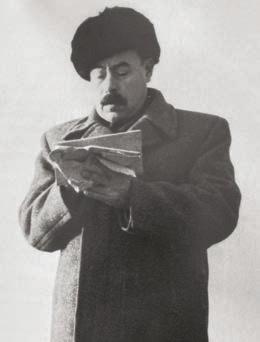
From Chetkov’s 2009 autobiography, “And where will it lead me? Where will the painting end up? If I stop and hesitate or start thinking too much, I tell myself: What am I afraid of? This is not for an international jury or something! So, my inner voice responds and says, go ahead, put audacity in your painting! Your painting must be your labor of love.”
At a certain stage, Golubev called directly upon the experience of Symbolism, seeking a deeper level of consciousness: dreamy, meditative, and hypnotic, painting works in which color was dematerialized and forms were broken, presenting a certain quality of being out-of-time, divorced from the situations and ties motivated by life itself.
Timkov’s lively faux color palette and innovative compositions placed him outside of the harsh Soviet mandate regarding artistic expression. His resistance and reluctance to paint ‘for the state’, led him to avoid the cultural centers, traveling and painting his plein air works in remote locations from the Urals to the southern steppes of Russia.
The three artists highlighted in the Pushkin Collection were each identified by senior researchers at the State Russian Museum (St. Petersburg), in the late 1990s, as exceptional and unique postwar painters. At that time, and in consideration for his charitable efforts within the Russian cultural community, Kenneth Pushkin accepted an offer to exclusively acquire these three life bodies of work.
The offer was facilitated by the Director of State Russian Museum, during the period from the mid-1990s the through the early 2000s, who introduced Kenneth to the representatives of the artists’ estates (or in the case of Chetkov, directly to the artist) with the understanding that Kenneth would promote the artists and publish a series of first quality, hard cover publications authored by State Russian Museum appointed art historians and scholars. These are listed in the back of this publication.
Such an invitation was especially captivating to Kenneth, as these were artists trained at the highest level of academic discipline, groomed to produce Soviet propaganda art, who defied the system that raised them, and broke the mold at great peril. These freespirited painters followed their visions well beyond the constraints of state sanctioned Social Realism.
It was clear to Kenneth from the start that there were complimentary commonalities between the three artists, creating a dynamic synergy. Each was from St. Petersburg and all were survived by extensive life bodies of work with well-documented and compelling life stories. They all emerged as stand-alone individualists in the 1950s and 1960s, well before the ‘Nonconformist’ trend of the 1970s. Even while being pressured and persecuted, each of these artists stayed focused on intellect and beauty, without political angst or bias. They were progenitors in their time and place within recognized genres; Nikolai Timkov, Impressionist; Vasily Golubev, Expressionist; and Boris Chetkov, Abstract Expressionist.
Their commitment to the pursuit of individual paths, apart from Social Realism, cast them as ‘Outsiders’ to the official Union of Soviet Artists and the broader ‘accepted’ cultural community. Their status of being shunned remained in place until the collapse of the USSR in 1991, at which time the harsh mandate of Soviet Realism was abandoned, ushering in a two-decade era of free expression in Russia accompanied by a new and deep appreciation and respect for these brave, groundbreaking postwar artists.
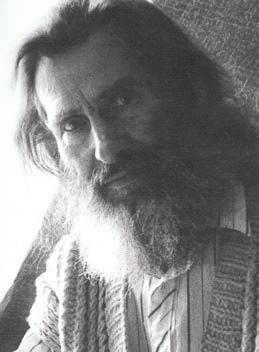
Born October 27, 1926, to a family of successful peasant farmers in the small town of Novaya Lyalya in the Northern Urals, Boris Chetkov enjoyed a sunny early childhood. There the peasant world dominated, and Chetkov’s memories, warm and clear, are colored by the peasant way of life imbuing his paintings with a simple power.
Boris’s teen years were turbulent, reflecting the dramatic social and economic changes that came with the advent of Josef Stalin. At 13, he was unjustly arrested and served a sentence as a logger within the infamous Gulag Archipelago before being assigned to the front lines of WWII as part of a ‘penal’ battalion from which few survived.
Despite the chaos of his life, Chetkov’s inner drive towards creativity was insurmountable. An accomplished, academically trained painter, Chetkov’s early works in the late ‘40s and early ‘50s were still lifes and landscapes. A student of the Leningrad Art College and a graduate of Sverdlovsk Art College he very soon moved to abstraction. At great risk to himself during this very restrictive period in Soviet Russia, Boris unwittingly became a pioneering artist. Never part of any trend or group, his special intellect and fondness for abstract painting cast him as an outsider.
Throughout the 1960s Chetkov carved out a path of his own, laying down several lines of work reflecting his emerging philosophy. Invoking classical, mythological and biblical themes, he channeled his spiritual and emotional energy into myriad subjects including genre scenes, musicians, horses, portraits, still lifes, landscapes and pure abstract expressionism. These lines raised their voices throughout his whole career.
The 1970s saw his expressionism bloom most powerfully and he continued to paint without boundaries. He became a mystic and a hypnotist with color, drawing the viewer into the emotion of his paintings. Energy flows and texture played a major role in his work. Chetkov simply painted what he breathed, that which formed the very substance of his being. As the years went by he became extremely prolific and his work flowed out in a powerful, passionate and inspired stream.
Boris Chetkov passed in September, 2010, but not before he was honored with the first one man exhibit at the Presidential Palace in Konstantinovsky. He had come full circle and had never compromised his integrity. It wasn’t in his nature. In spite of the hardship and artistic isolation that life had delivered, he stayed his course with a remarkably positive attitude, as is evident when viewing his compellingly beautiful and fascinating works.
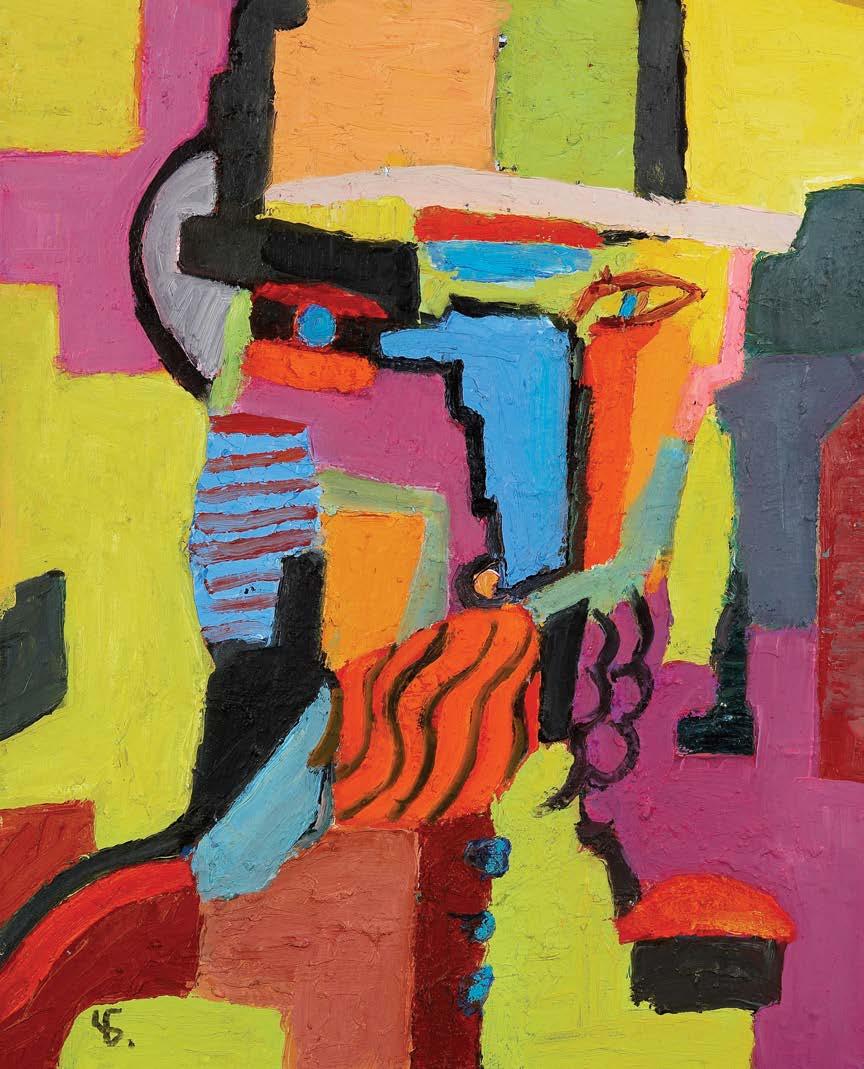
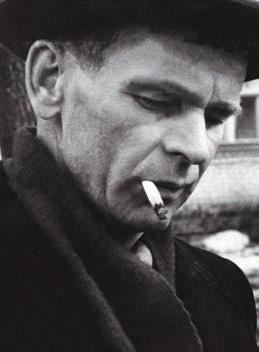
Modest, focused within himself, introverted, preferring to spend his time in the open air, Vasily Golubev had no interest in self-representation or any of the social and political manifestations which were obligatory in official art. Thus, it was that official art saw him as an outsider, as something alien: He was seen, in the best Russian tradition, as someone not of this world. If he had been part of the cultural elite this brilliant exponent of Expressionism would have been seen as Western-oriented, a cosmopolitan in itself a dangerous category but he was instead a man of simple peasant roots, a man “of the earth”, and could hardly be suspected of such Western leanings. He learned the lessons of Post-Impressionism and Expressionism independently and they made their appearance as the fruit of his own development. In the face of this incontrovertible fact, the powers-that-be preferred simply to ignore his work.
Golubev was born in 1925 in Medvezhe, a village in the Soligalich Area of Kostroma Region, in the very heart of Northern Russia. A desire to study and learn brought the village boy to Leningrad, but his studies at Leningrad Art School were broken off by the war: he graduated only in 1951.
Throughout the 1950s and 1960s he developed along the lines of classical Russian Realism, gradually mastering the emotional potential of plein air painting. Finding his way towards a Post-Impressionist understanding of color, Golubev’s landscapes becoming more painterly, with a manner in which color came to play an active, central role, and eventually became symbolic. From the late 1960s, Golubev was entirely dedicated to the principles of Expressionism, of which he had created his own, original Russian version. His energetic impasto, the free and open brushstrokes, the disturbing color harmonies gave the traditionally intimate central Russian landscape drama and a new, penetrating content.
Golubev lived at a time of isolation in terms of the information available. During his time as a student, it was impossible to gain normal objective information about all the latest trends in art. Despite this fact, he came to his own artistic conclusions independently, and thanks to his independent nature, his development was far removed from any repetition of the past. As he made his way along the historical path already traveled in art, he found his own energy, his own inimitable intonation.
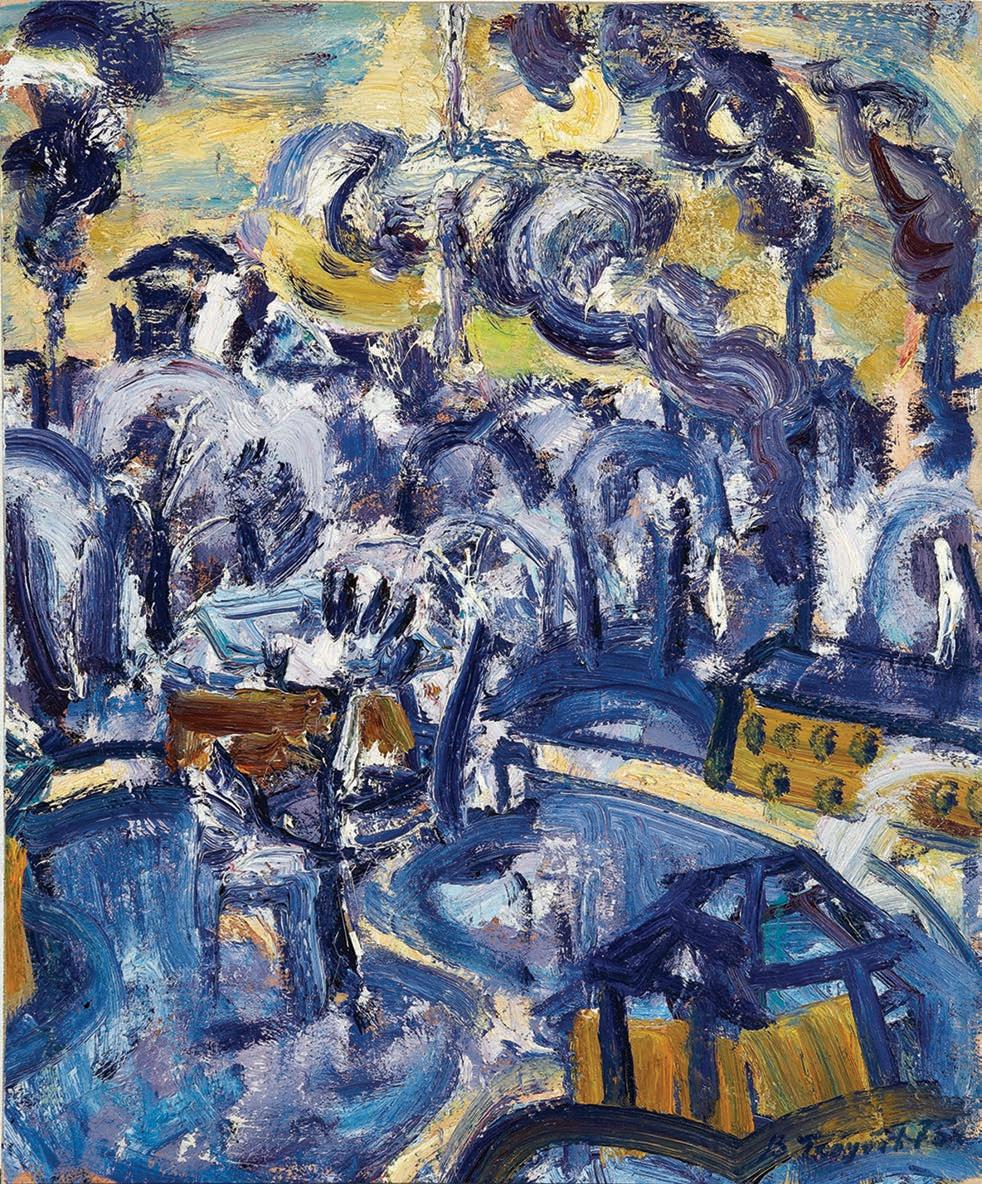 Зима в городе ( Winter in the City) Oil on Masonite, 1975, 22 × 18 inches (55 cm × 45 cm)
Зима в городе ( Winter in the City) Oil on Masonite, 1975, 22 × 18 inches (55 cm × 45 cm)
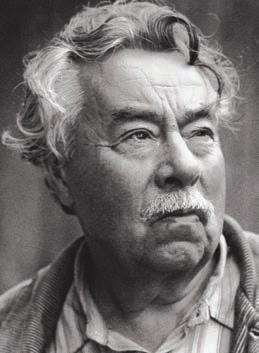
At his 1993 exhibition, the year of his passing, Nikolai Timkov revealed himself as a deeply sympathetic artist a composer arranging colors whose sounds vividly echo symphonies by Kalinnikov and Borodin. This last show was the monumental summation of an honored painter. The public in attendance was shaken with the integrity and wholeness of his artistic outlook, his perceptions, and his consummate spiritual awareness. It signified the emergence of a classic artist whose works are now considered part of the canon of important Russian landscape paintings.
Born in 1912 on the steppes of temperate southern Russia, his natural gift as an aspiring art student led him to Moscow in the early 1930s, where he became acquainted with the treasures of the museums and the artistic life of the capital. It was there he met his mentor, the philosopher-landscape painter, Mikhail Nesterov, known as the Coryphaeus of Russian painting. Nesterov inspired the emerging painter with the words, “One has got to paint with reason and sense, not for effects or beautiful brush strokes, but for a deep and sincere expression of human feelings.” This would become the credo of all Timkov’s future endeavors.
In 1938, he was invited to the Academy of Arts in St. Petersburg by its director, the renowned academician and painter, Isaac Brodsky, who focused on the young Timkov as his favored student. Brodsky’s influence bound him to the best traditions of Russian art of the late 19th and early 20th Centuries.
Graduating from the Academy of Arts, he served throughout WWII as a documentary artist for the Russian Navy where he worked until 1946.
With the war behind him, Timkov’s career was highlighted by several major one-man exhibitions. These shows marked extended periods of his artistic work and became important stages of his growth both spiritually and artistically. Throughout this time, he formed his unique approach to landscape painting, which has become known as the ‘Timkov style’, distinguishable at first glimpse by noting the compositional peculiarities, the artistic solutions, and the characteristic brush work.
Preeminent art historian, Nina A. Dmitriyeva, observed that, “the scale and resolve of Timkov’s landscapes is remarkable, even in the smallest works, but his genius finds its full expression in his panoramic vistas with their cosmic grip on space, painting in layers of ‘local’ colors, which enhance the fields, the flow of rivers, the woods, distances, hues, shadows and tints particular to the season.”
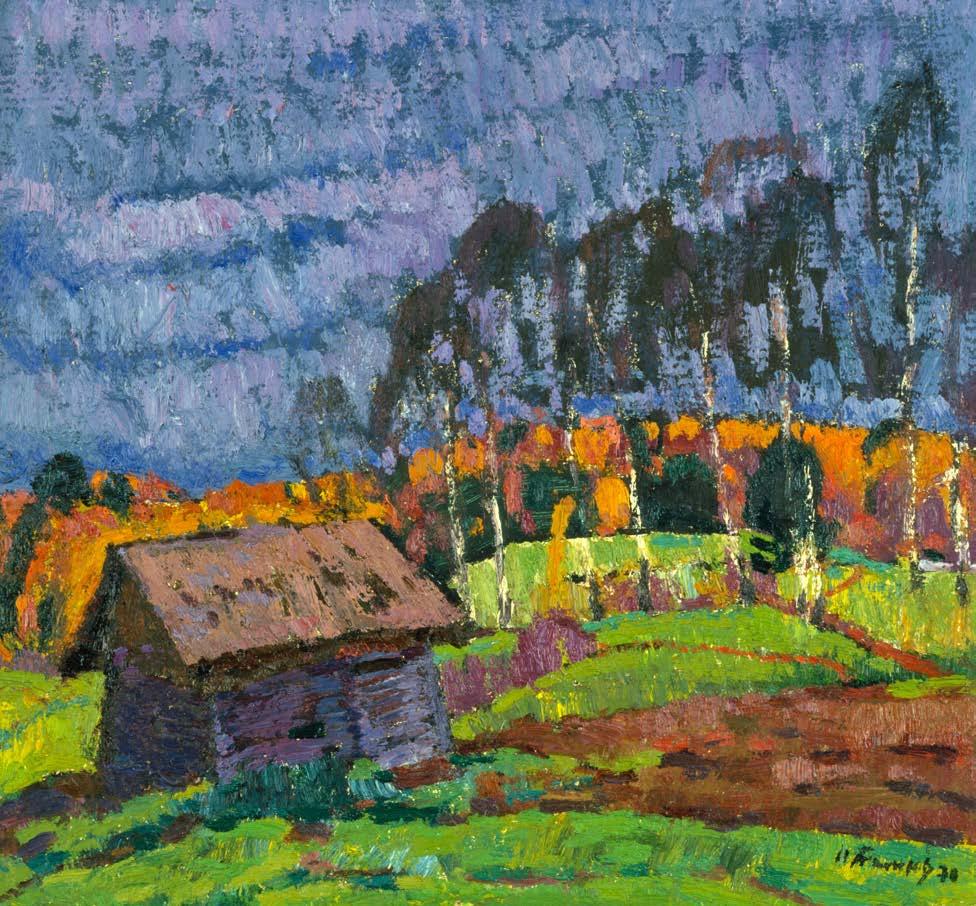 Дух осени (Autumn Spirit) Oil on Panel,1994, 10 × 10 inches (25 cm × 25 cm)
Дух осени (Autumn Spirit) Oil on Panel,1994, 10 × 10 inches (25 cm × 25 cm)
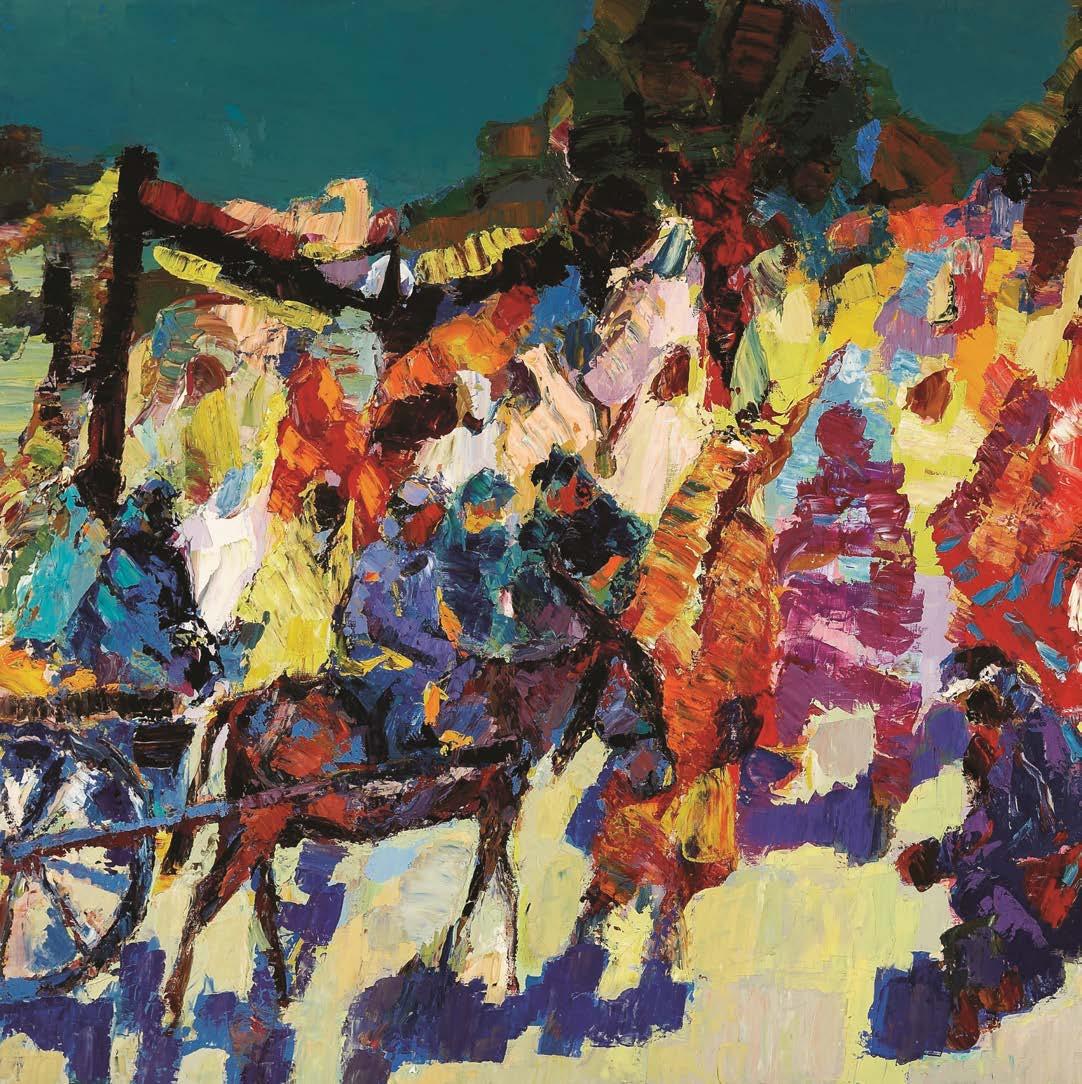
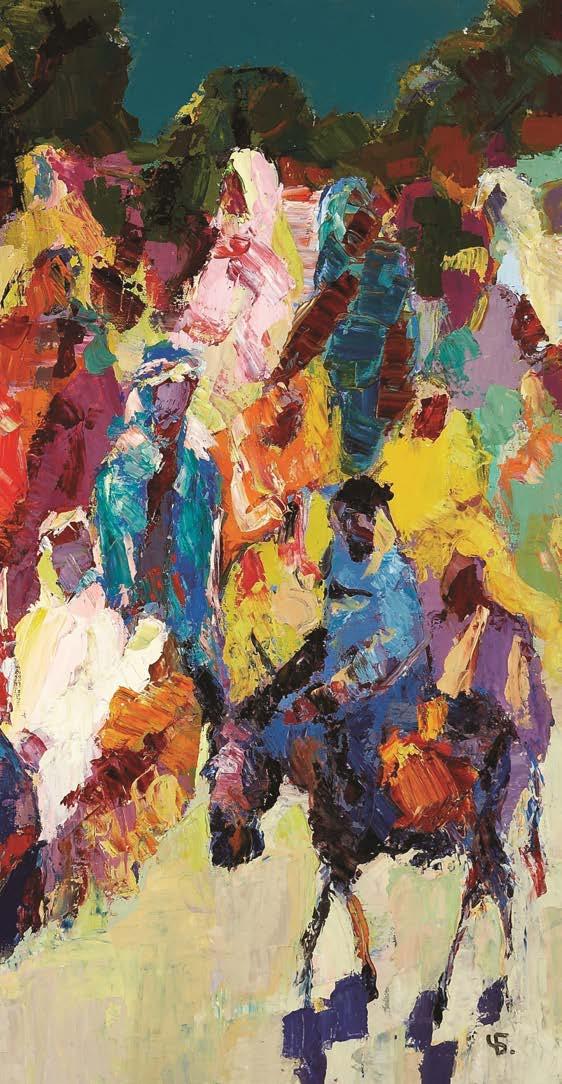
BORIS CHETKOV
Базар в Самарканде (Bazaar in Samarkand)
Acrylic on Panel,1994, 32 × 40 inches (80 cm × 100 cm)
Our family moved to Kazakhstan in the spring of 1941. Narrow streets, camels, exotic sounds and vibrant colours all around, noisy markets with plenty of bric-a-brac on sale. I was enchanted by this world, and spent all my time at the market, drawing everything I saw around me.
Boris Chetkov
In My Own Words (Autobiography)
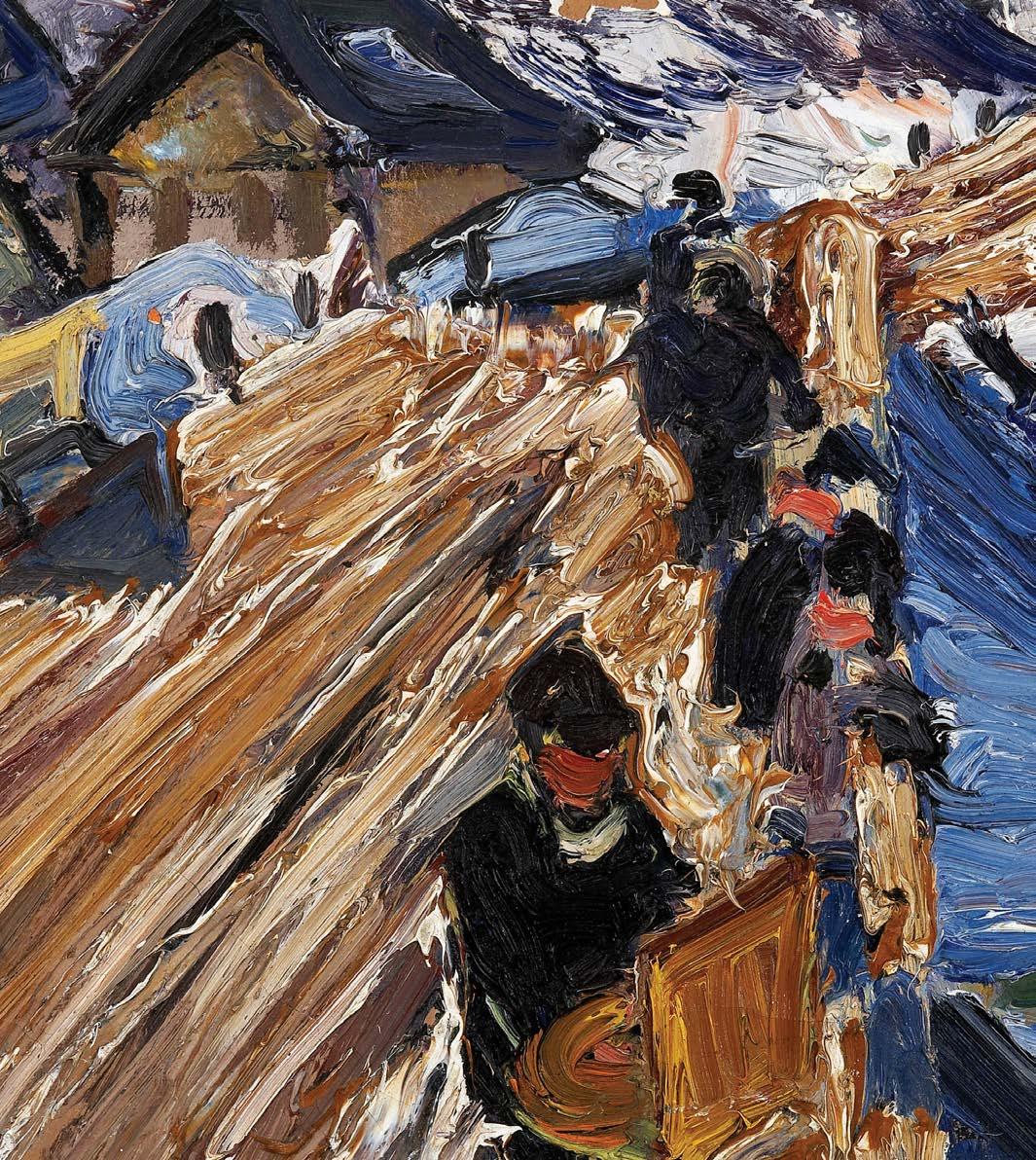
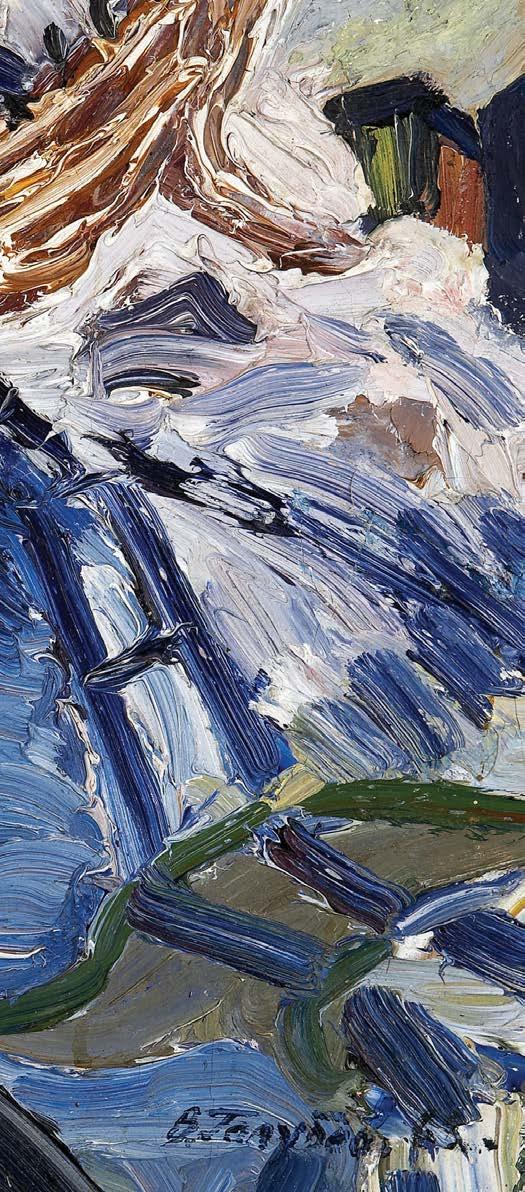
Художники на плотине (Artists at the Dam)
Oil on Panel, 1962, 13 × 19 inches (33 cm × 48 cm)
Golubev is not simply painting nature, but as it were competing with her in the creation of form. The brush literally molds the mass, impasto color builds relief rhythmic, textured, even volumetric. His personal version of Expressionism was independent of any connection to or
knowledge of the artistic trends of the West. Yet, curiously, he reached many of the same conclusions as such major Expressionists as Edvard Munch and Raoul Dufy.
Dr. Albert Kostenevich
Keeper of Impressionist Paintings
State Hermitage Museum, St. Petersburg
NIKOLAI TIMKOV
Золотая Рожь (Golden Rye)
Oil on Panel, 1960, 31 × 39 inches (78 cm × 98 cm)
Timkov sought to re-visualize nature freshly, with more spontaneity. Using faux color and textured impasto to establish forms, he conveys a vivid impression of something actually seen or felt in nature.
Nina A. Dmitriyeva
Preeminent Art Historian
The Pushkin State Museum of Fine Arts, Moscow
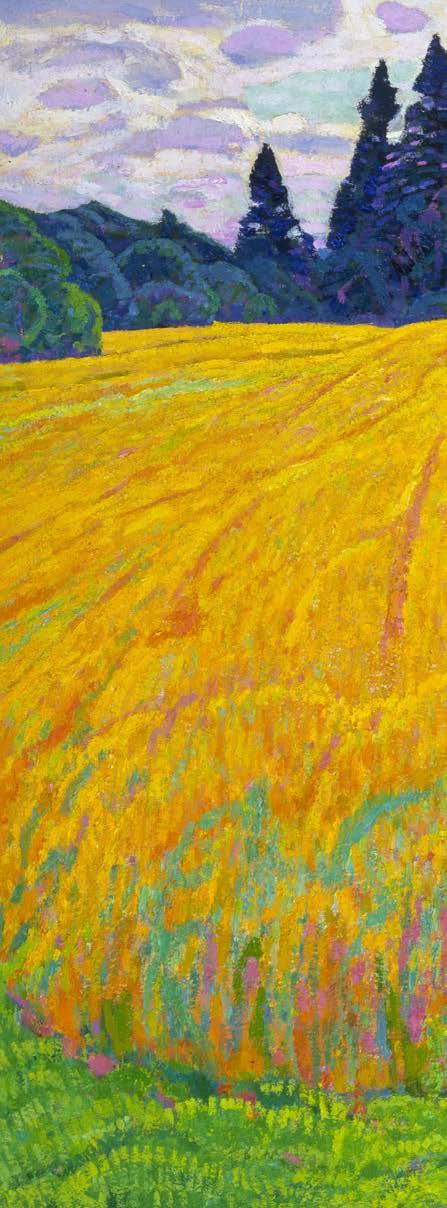
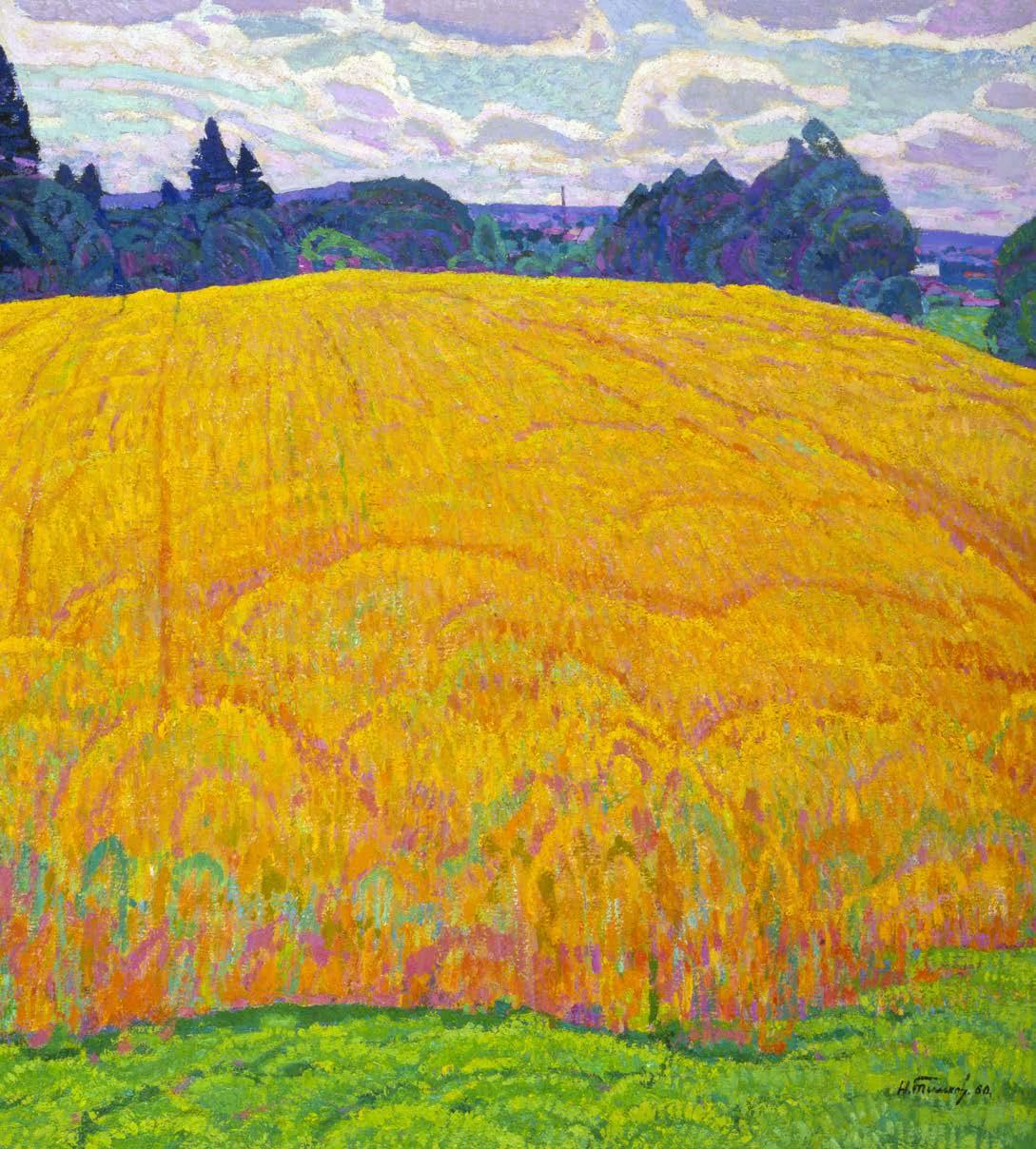
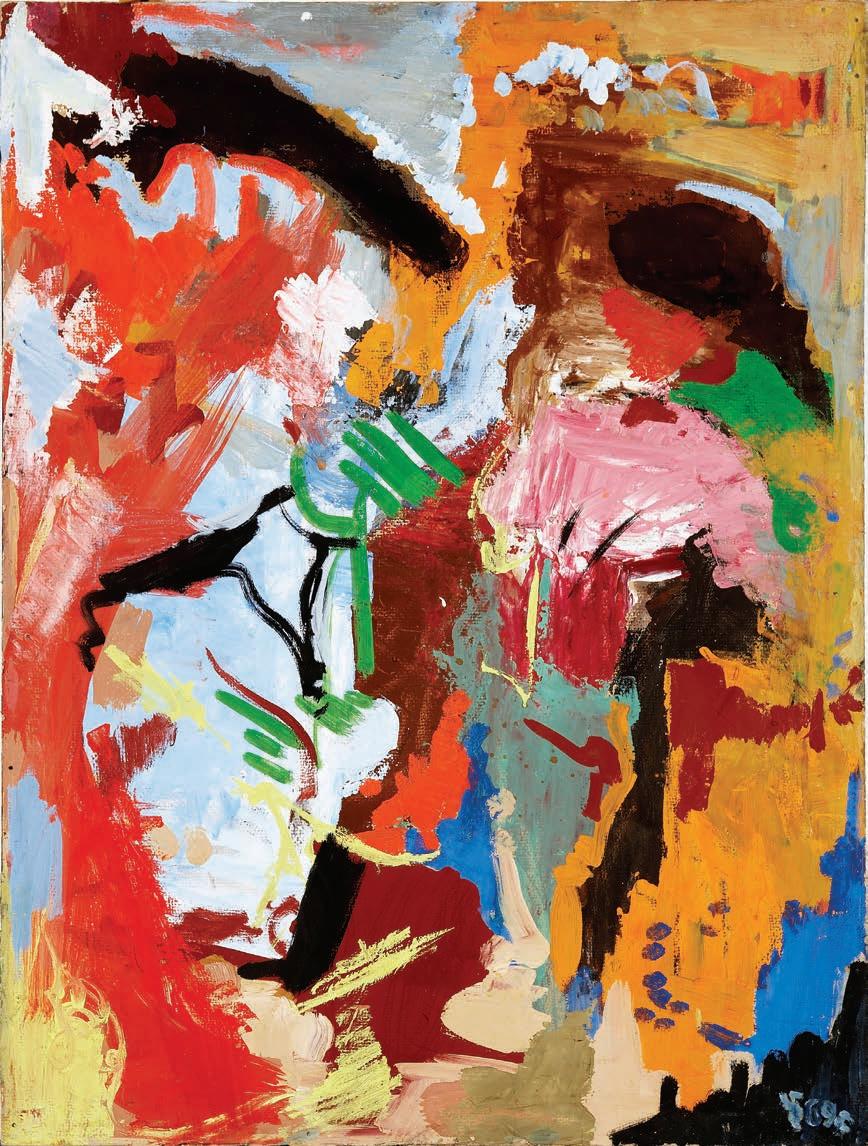
Consider the Soviet Union in the mid-50s through the 1960s Nikita Khrushchev and Leonid Brezhnev, a deep cold war with the west, and a harsh totalitarian regime within its own borders. Art was governed by and produced strictly for the State to espouse the ‘virtues’ of the Soviet system. Artwork created outside these parameters was a violation of the law.
It was in this environment that the young artist, Boris Chetkov, a survivor of the gulag and WWII, set forth on his own defiant quest, channeling his psychic energy into a stream of highly emotive, abstract action paintings full of originality, bravado, and color.
Chetkov, stood alone as an early pioneer of abstract expressionism in Soviet Russia. In isolation, behind a cultural iron wall, he somehow arrived at many of the same conclusions as his celebrated western contemporaries, Willem de Kooning and Frank Auerbach, among others.
Мужской портрет (Male Portrait)
Oil on Panel, 1969, 32 × 24 inches (80 cm × 60 cm)
Портрет Шостаковича ( Portrait of Shostakovich)
Oil on Canvas, 1955, 26 × 19 inches (65 cm × 48 cm)
In the portraits of musicians the artist constructs visual characterization of his sitters through analogy with music. He perceives the sitter’s music as a drama of extreme emotional tensions.”
Dr. Alexander Borovsky
Chief Curator of Contemporary Art
State Russian Museum, St. Petersburg
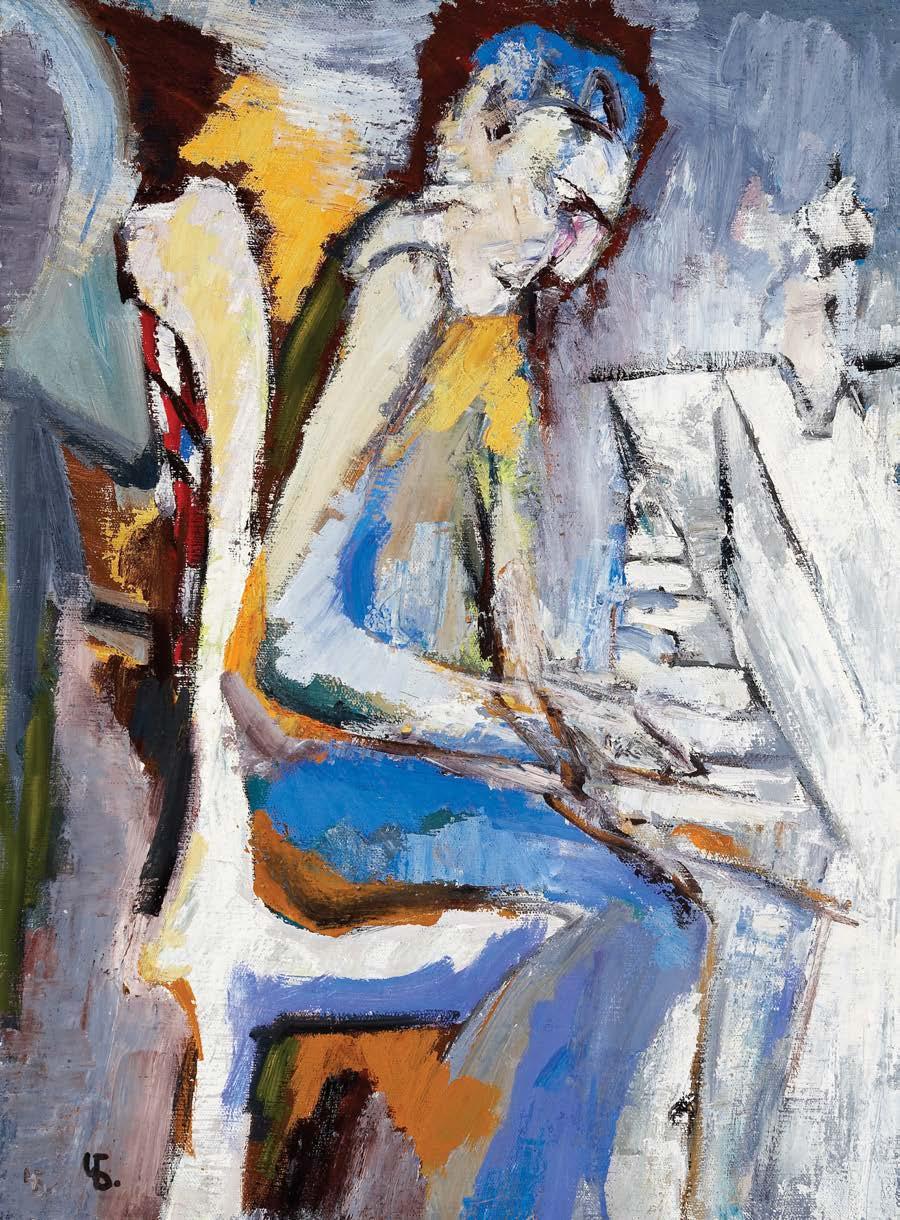
Мальчик (Portrait of a Boy)
Oil on Paper, 1956,12 × 8.5 inches (30 cm × 22 cm)
The immediacy, confidence and color sense of Chetkov’s early works in the mid 1950s distinguish him as a harbinger of action painting and postwar Expressionism.
Dr. Albert Kostenevich
Keeper of Impressionist Paintings
State Hermitage Museum, St. Petersburg

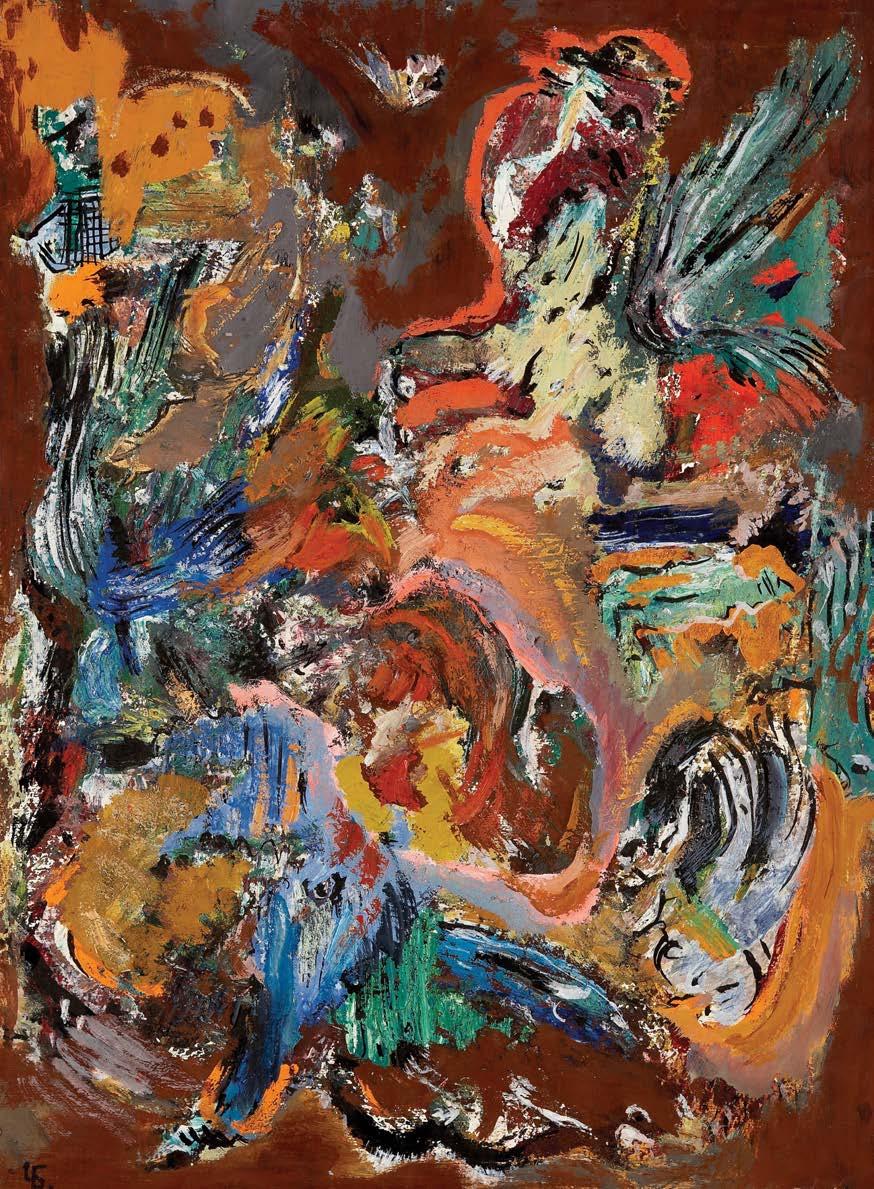
Петухи дерутся (Roosters Fight)
Oil on Panel, 1959, 28 × 20 inches (50 cm × 70 cm)
The recurring theme of animals in Chetkov’s pictures serves to remind us of the significance of his upbringing in a small farming village in the Northern Ural Mountains. In one of his earliest collected works entitled, Roosters Fight, the chaos of the raging birds is delivered with a swirling dynamism, as the violently splayed feathers fly in rhythmic brushstrokes and colors upon a rich, earthy ochre background. When Chetkov painted this in 1959, he may have been reflecting on the sudden, dramatic events and turmoil of his childhood in the early 1930s, when Stalin’s collectivization transformed his secure farm life into one of chaos and constant movement.
Kenneth Pushkin Russian Postwar Researcher and Collector
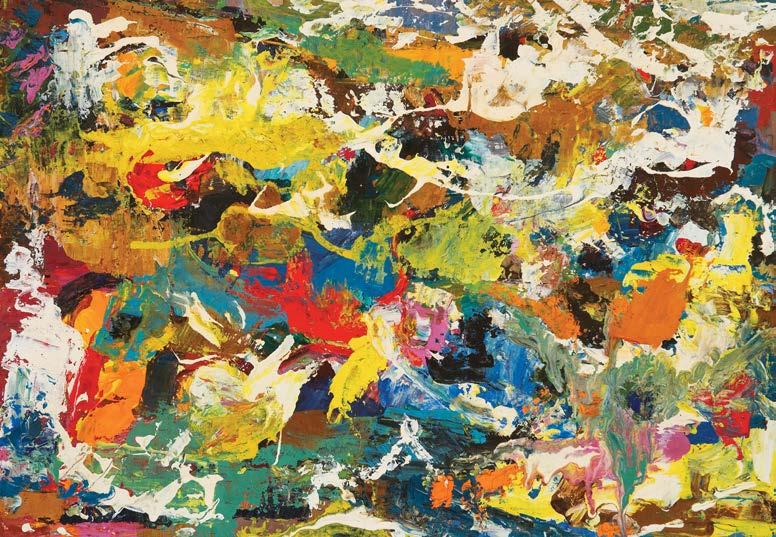
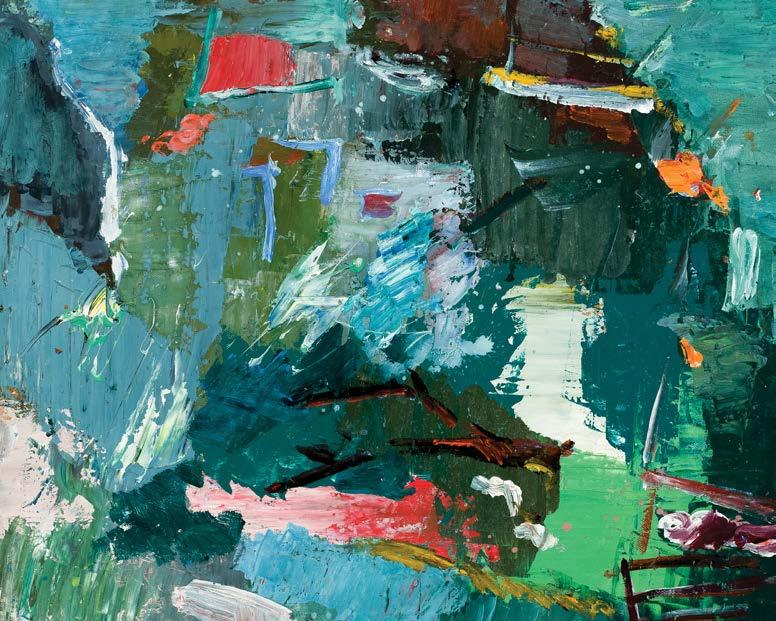
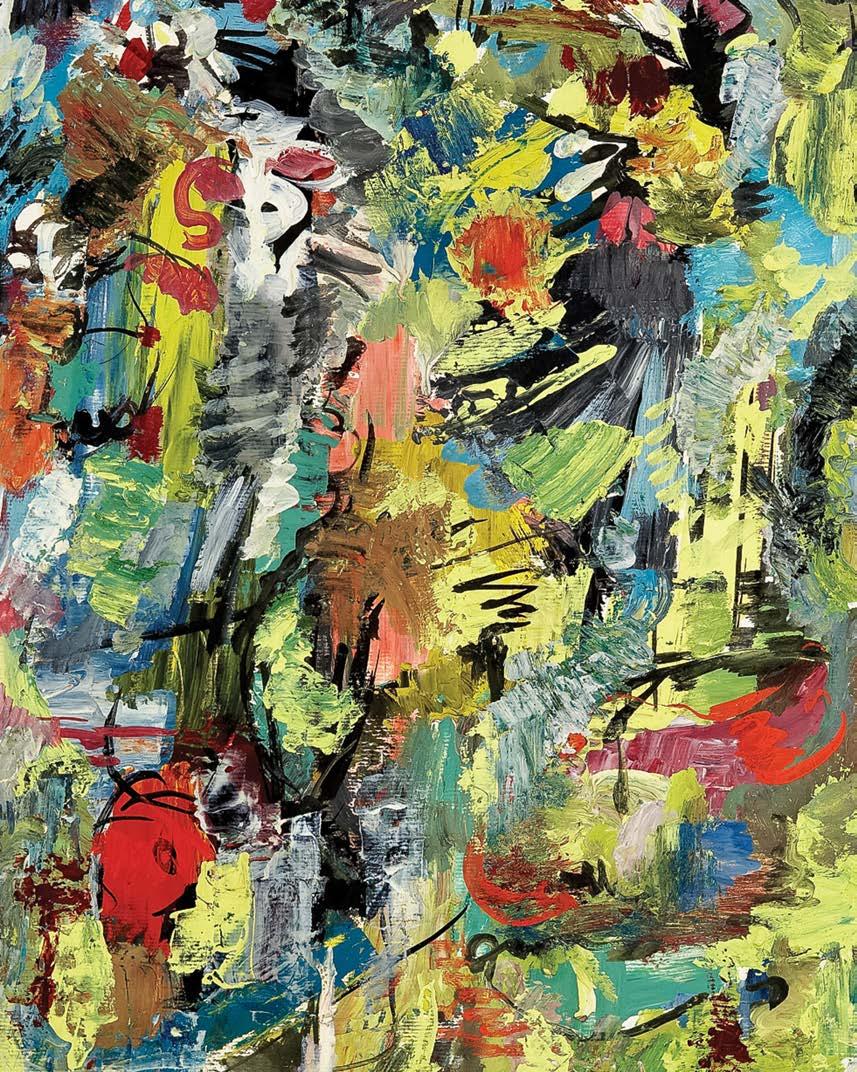
Композиции (Composition) Oil on Panel, 1965, 14 × 20 inches (35 cm × 50 cm)
Пейзаж (Landscape) Oil on Panel, 1964, 14 × 17 inches (35 cm × 43 cm)
Пейзаж (Landscape) Oil on Panel, 1960, 12 × 18 inches (30 cm × 45 cm)
Натюрморт с ирисами (Still life with Irises)
Acrylic on Canvas 1969, 24 × 20 inches (60 cm × 50 cm)
The richly saturated color anchored by the eye-smacking blues and highlighted by splashes of brilliant whites and jewel tones creates the full range of effects depth as well as flatness, contours as well as planes, the substantive as well as the illusory evoking a visceral sense of joy.
Dr. Alexander Borovsky
Chief Curator of Contemporary Art State Russian Museum, St. Petersburg
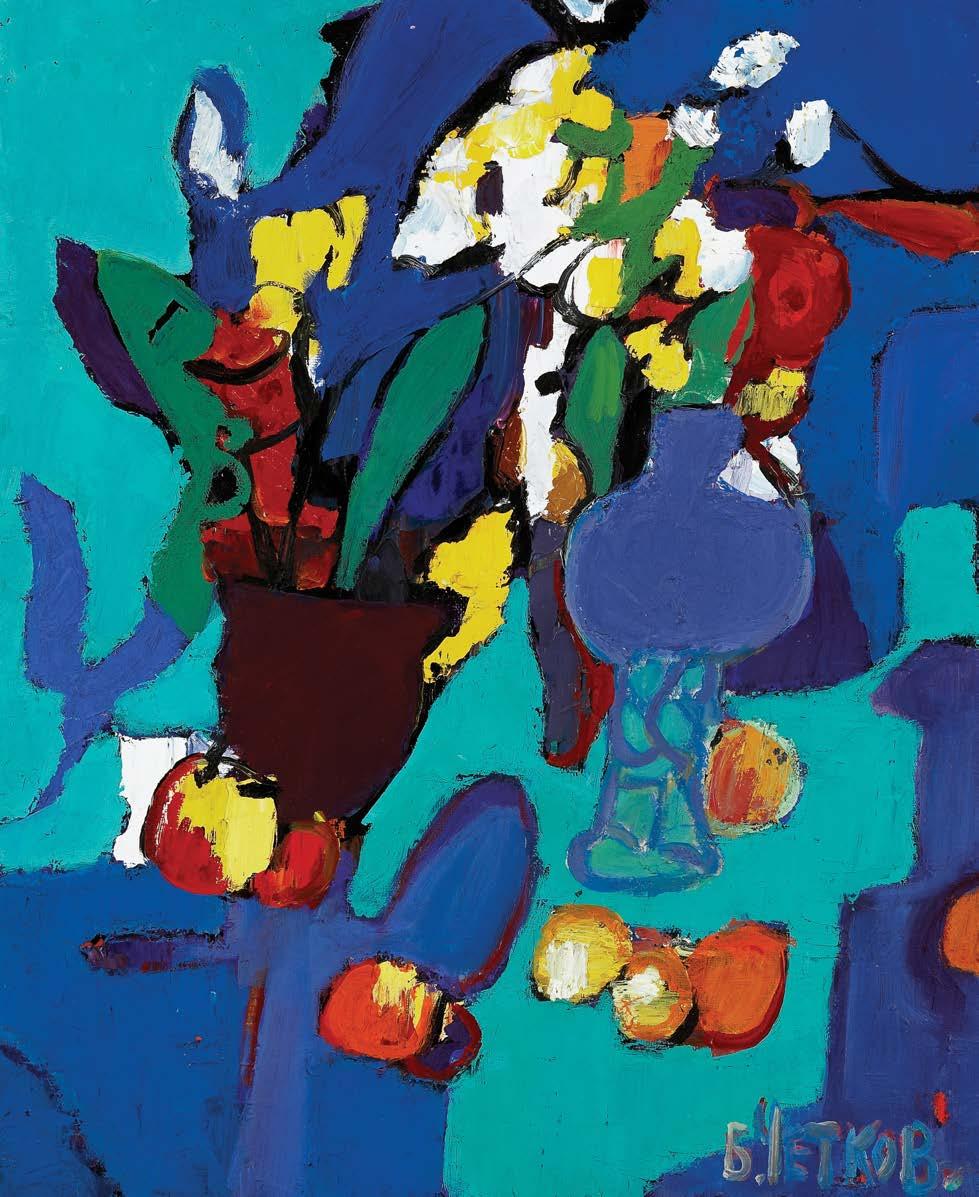
Зеленый луг с цветами (Green Meadow with Flowers)
Oil on Panel, 1969, 12 × 12 inches (30 cm × 30 cm)
Chetkov grew up in rural Russia, far away from the major urban centers. As a child, he was exposed to the peasant art of the ex-serf population who would hand paint dolls, embroider linen and create religious imagery for local churches. Expressions of his early life are encapsulated in works such as Green Meadow with Flowers , in which the artist approaches his rural, pastoral vision with raw emotion and spontaneous action.
Theodora Clarke
Russian Art Scholar
The Courtauld Institute of Art, London
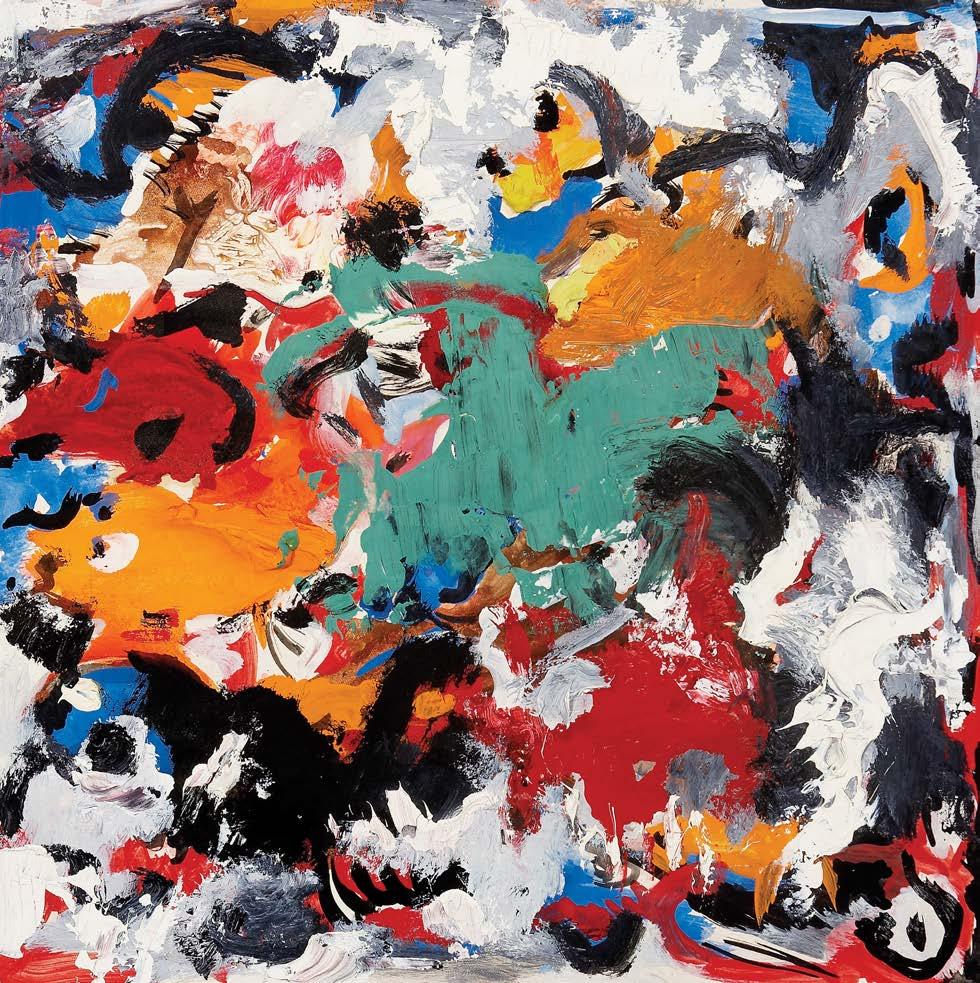
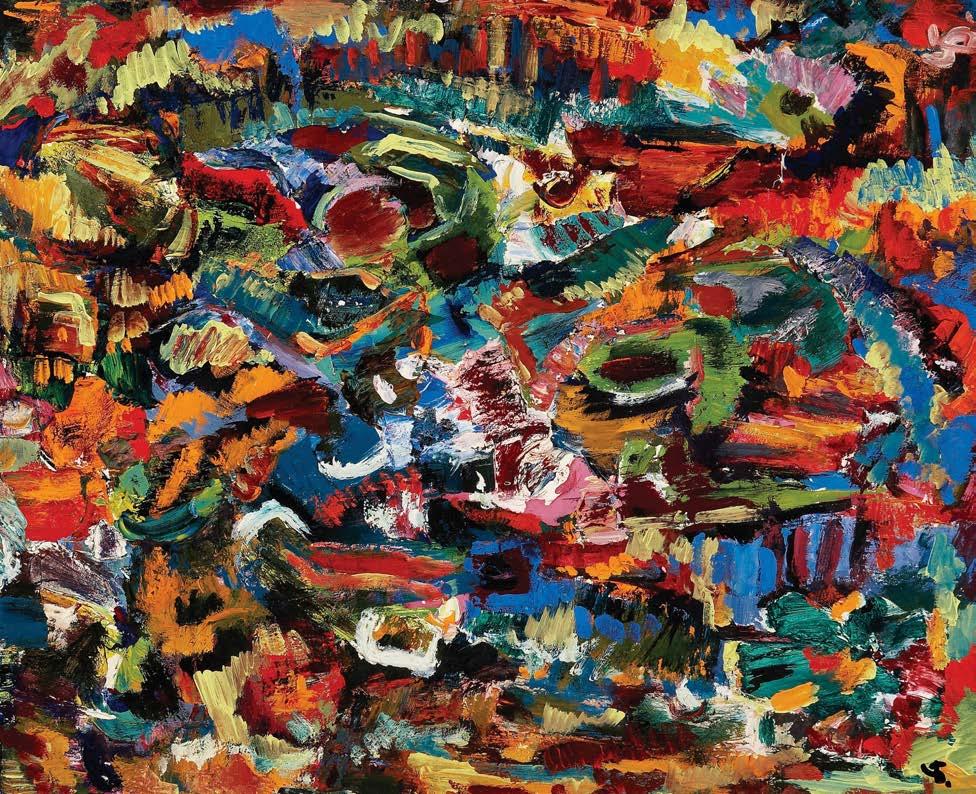
Все в желтом (Everything in Yellow)
Oil on Panel, 1969, 14 × 20 inches (35 cm × 50 cm)
A key theme throughout Chetkov’s work is his raw and emotional response to the natural and physical world. Chetkov strives to capture the emotional and dynamic essence of his subject. He engages with the environment on a conscious and subconscious level and once said, “…I think that the artist must feel nature, not copy nature.” In his autobiography Chetkov does not cite any specific artists or movements as a direct influence on his work. Nevertheless, we can see visual parallels between his work and that of his predecessors. His art is imbued with their spirit as we have seen with icons, folk art and the Russian avant-garde.
Kenneth Pushkin
Russian Postwar Researcher and Collector
Белое облако цветущей яблони (White Cloud of Apple Blossoms) Oil on Canvas, 1969, 32 × 36 inches (80 cm × 90 cm)
Chetkov creates fantastical colourscapes, where the natural world is depicted as constructed patches of colours, ignoring conventional perspective. White Cloud of Apple Blossoms, is exemplary of this process, conveying the warm woodland homestead enveloped in richly textured blues and greens, setting the stage for the main event an explosion of brilliant pink apple blossoms in the center, imbuing the work with a distinct lyricism and mood.
Theodora Clarke
Russian Art Scholar
The Courtauld Institute of Art, London
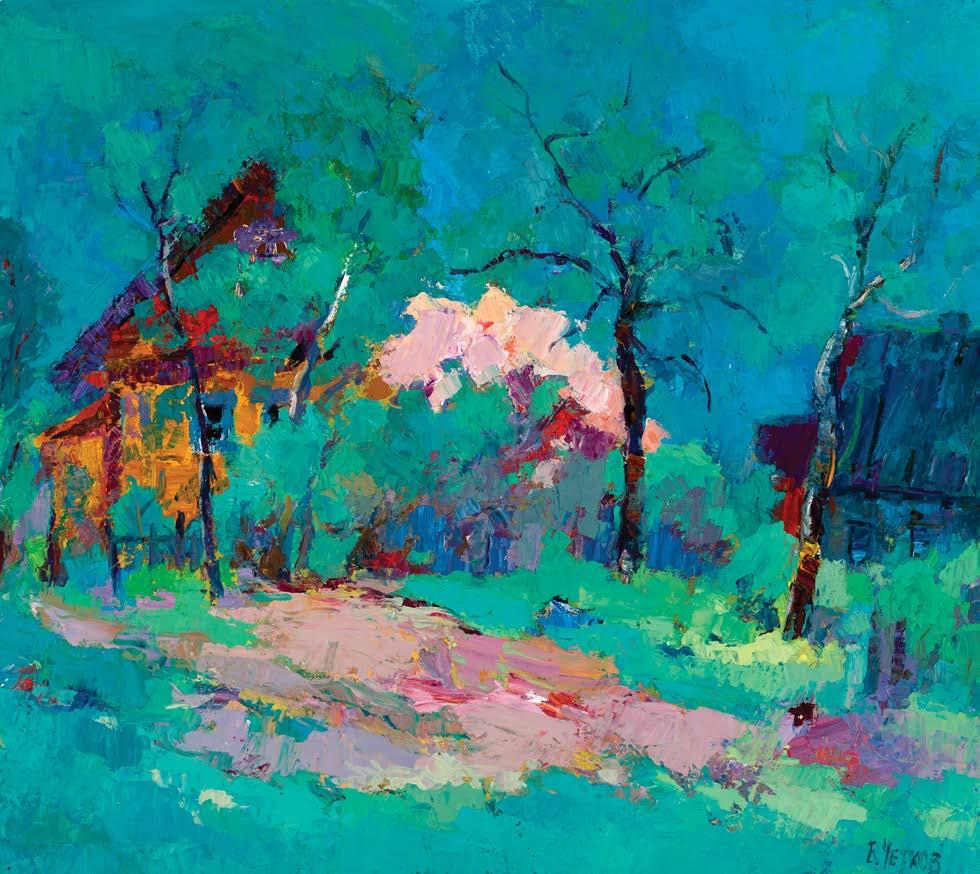

Игра черных шаров (Game of Black Balls)
Oil on Paper, 1969, 28 × 20 inches (70 cm × 50 cm)
Throughout Chetkov’s oeuvre he returns to games of chance, to the possibilities of the unknown, reflecting on his own creative, risk taking process.
Dr. Alexander Borovsky
Chief Curator of Contemporary Art State Russian Museum, St. Petersburg
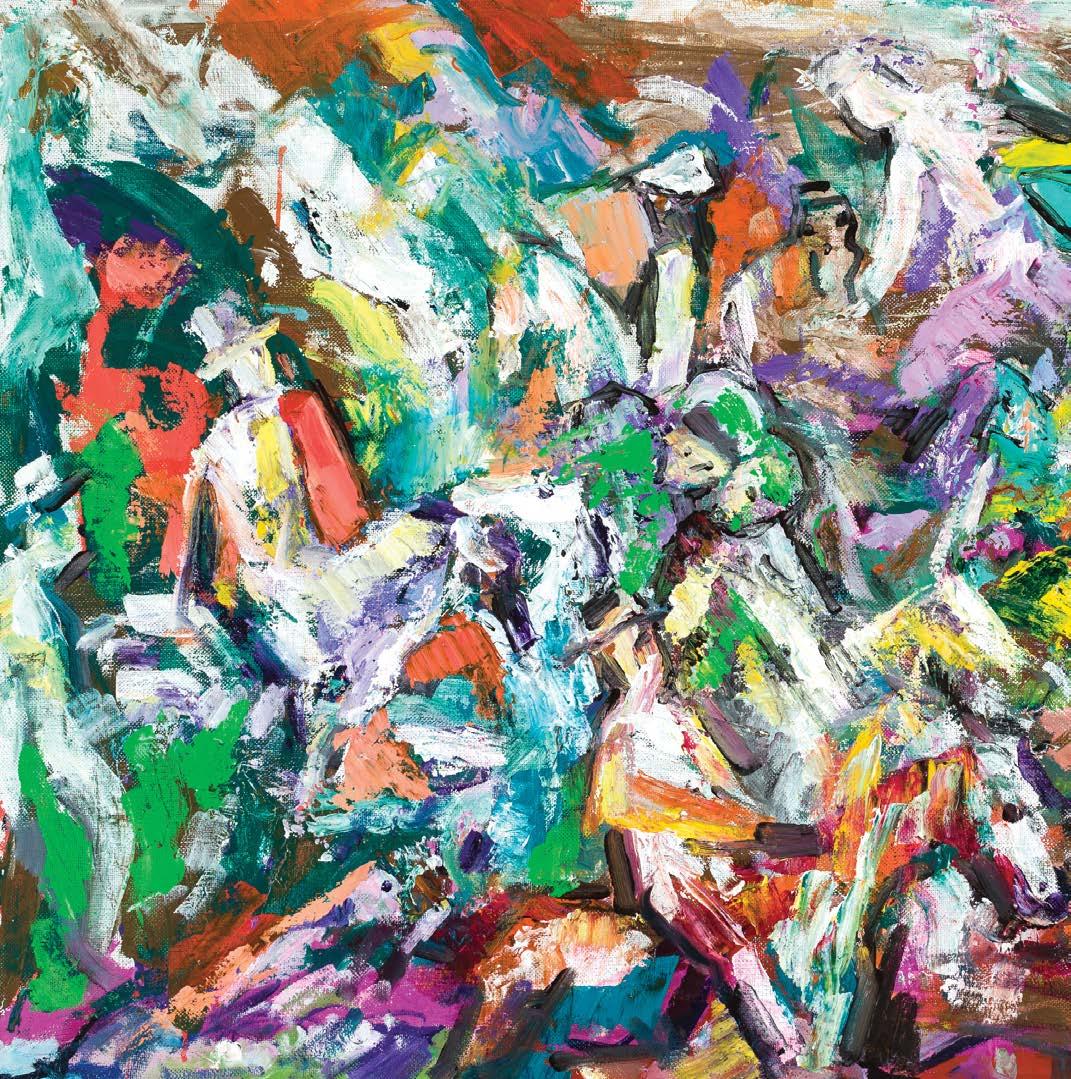
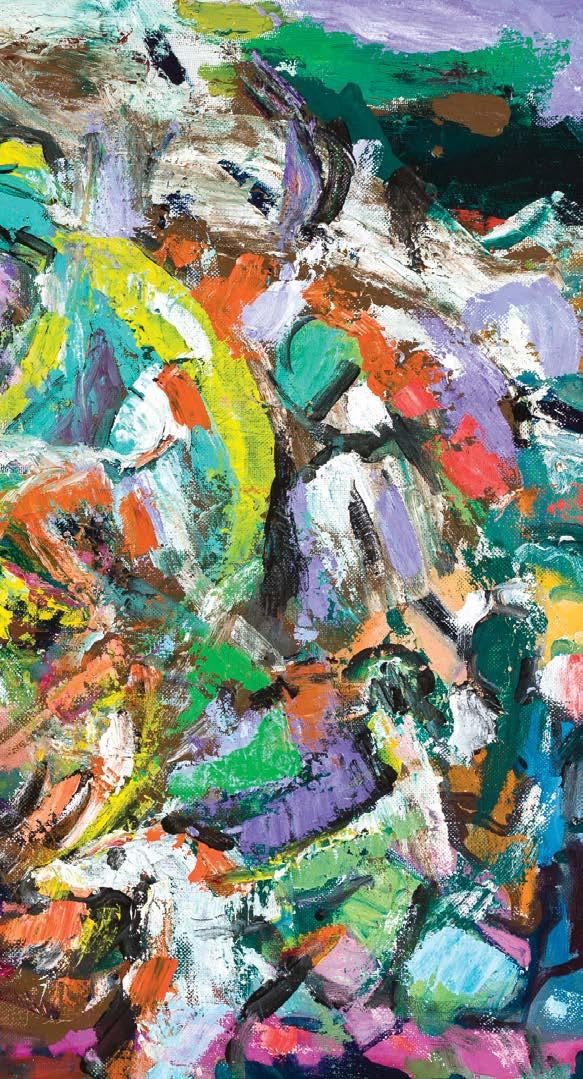
Прогулка (Stroll) Oil on Canvas, 1969
31.5 × 48 inches (80 cm × 120 cm)
The horse plays a prominent role in Chetkov’s oeuvre, symbolizing youth, freedom and the flight of time, always conveying a sense of energy and animation. He related closely with Kandinsky who famously noted, “Colour is the keyboard, the eyes are the hammers, the soul is the piano with many strings. The artist is the hand that plays, touching one key or another purposely, to cause vibrations to the soul.”
Theodora Clarke
Russian Art Scholar
The Courtauld Institute of Art, London
Черная луна над городом (Black Moon Above the City)
Oil on Panel, 1970, 14 × 20 inches (35 cm × 50 cm)
With a haunting and penetrating stare, this mysterious 1970 work caters to the imagination with its demanding presence and sense of intrigue. The immediacy and action of Chetkov’s paintings reflect his emotions and subconscious influences at any given moment.
Kenneth Pushkin
Russian Postwar Researcher and Collector
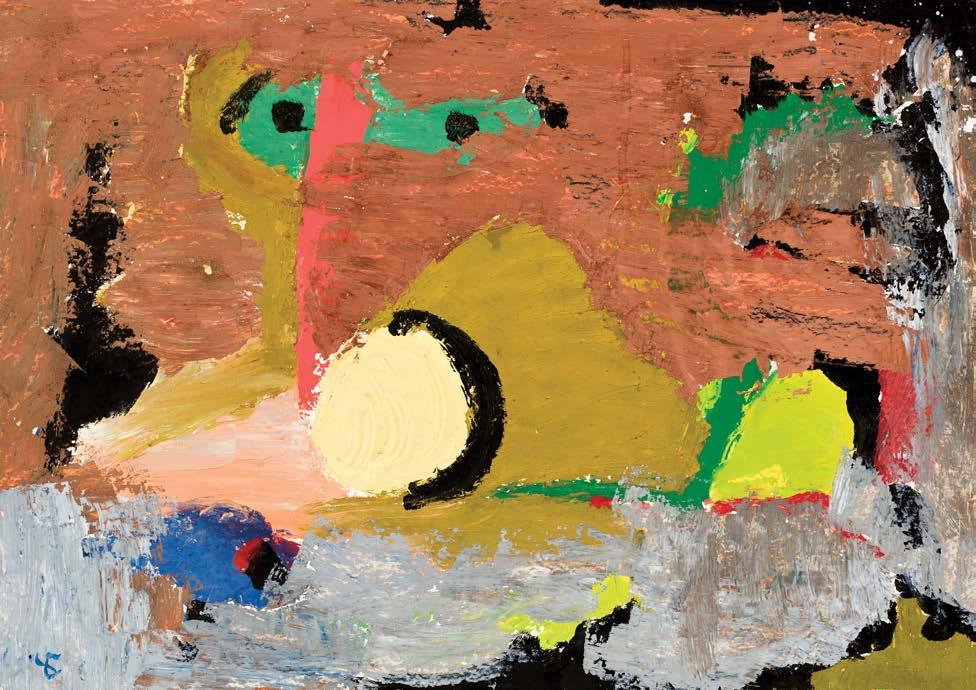
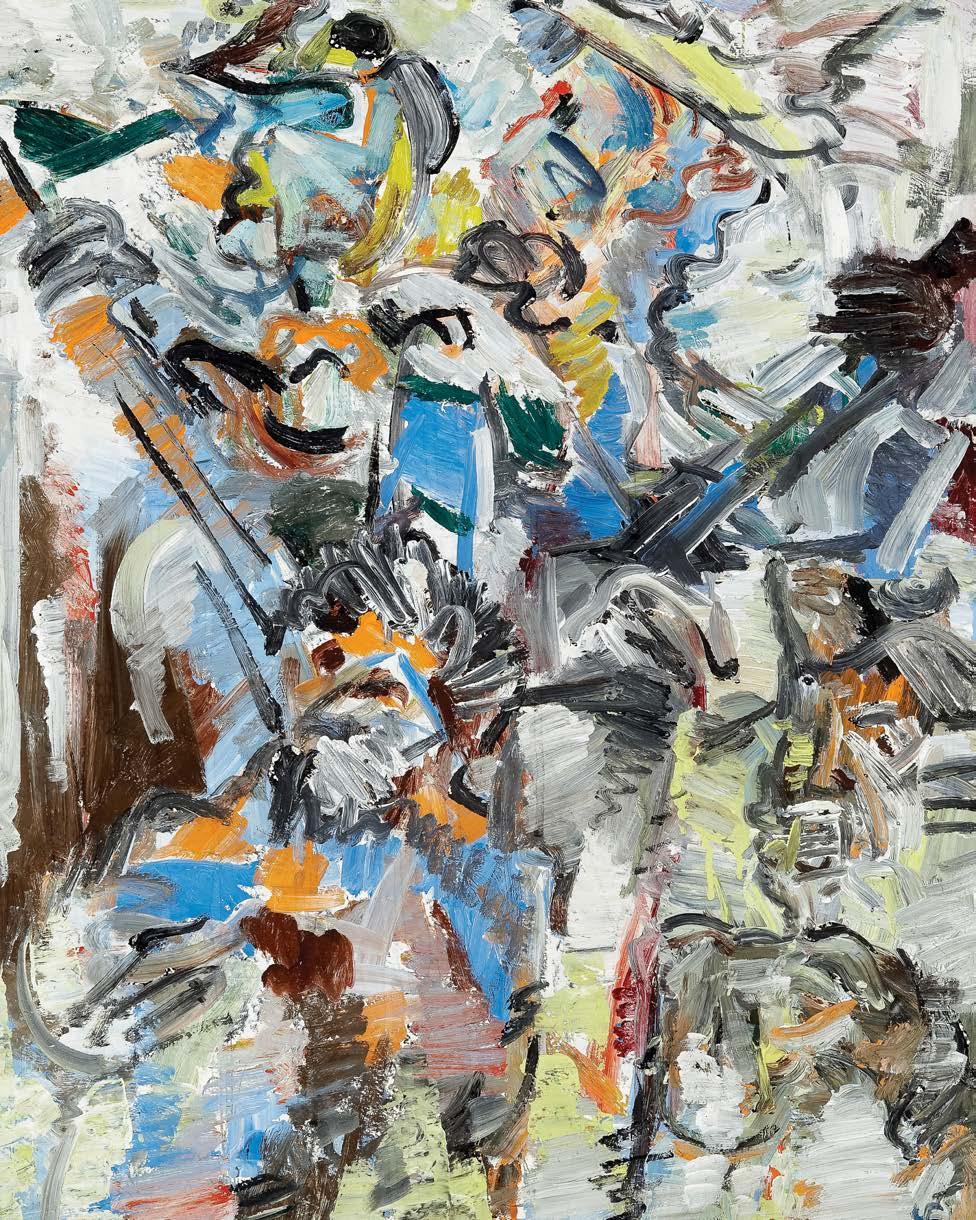
The period of Glasnost (Openness) initiated by Mikhail Gorbachev in the late 1980s, heralded the end of the Soviet Era, and along with it the repressive oversight of artistic freedom. Seventy years of strict totalitarian rule crumbled, giving way to a sense of liberation among the creative and intellectual community.
Boris Chetkov was among those inspired by this refreshing gust of hope.
Under the Soviet regime he had suffered a life of displacement, imprisonment, and war. As an abstract artist and free thinker, he had been ostracized by his peers and was denied honorable status by the Official Union of Soviet Artists.
Now, he would celebrate!
In one of the most prolific periods of his long career, Chetkov, in his 60s and going strong, painted with an unfettered level of energy and confidence. With adventurous color palettes and larger surfaces allowing for more movement, he subconsciously created a parallel narrative to the unfolding events and social changes with titles such as Sea of Gold, Fantasy Island, Picnic, Wild Horses and the like.
Throughout his life, Chetkov viewed his paintings as a spontaneous channel of consciousness to capture and release his emotions, which, as seen during the fall of the USSR, were inherently reflective of the world around him.
Мужской портрет (Male Portrait ) Oil on Panel, 1989, 32 × 24 inches (80 cm × 60 cm)
Композиция (Composition)
Oil on Canvas, 1989, 40 × 51inches (100 cm × 128 cm)
The speed with which Chetkov executed his action paintings, the hot improvisational rush of the strokes, marks and drips instantly register as coherent and intelligible when they encounter the canvas surface.
Dr. Alexander Borovsky
Chief Curator of Contemporary Art State Russian Museum, St. Petersburg
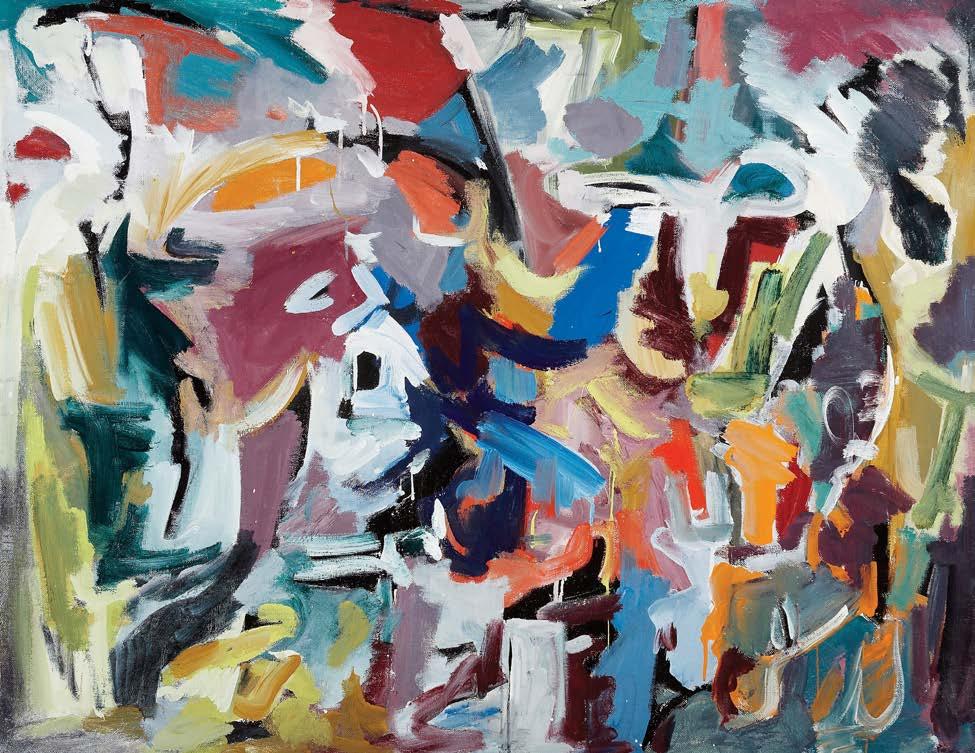
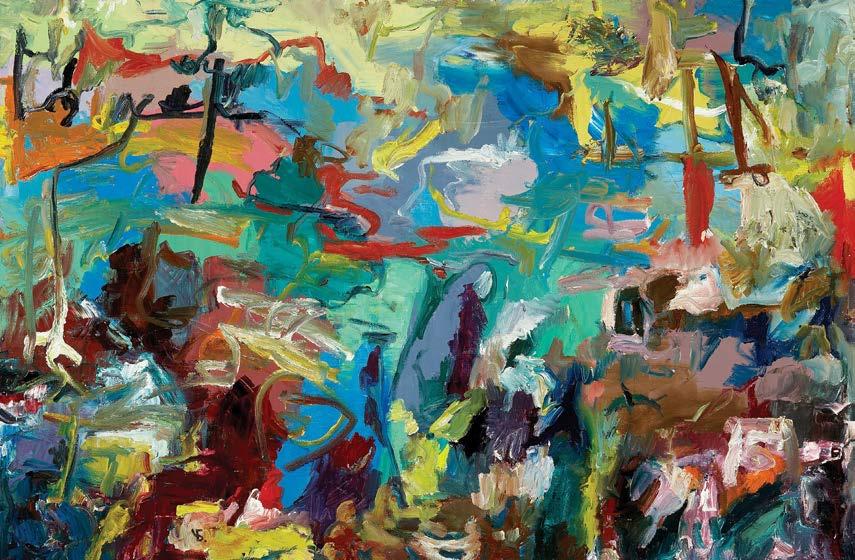
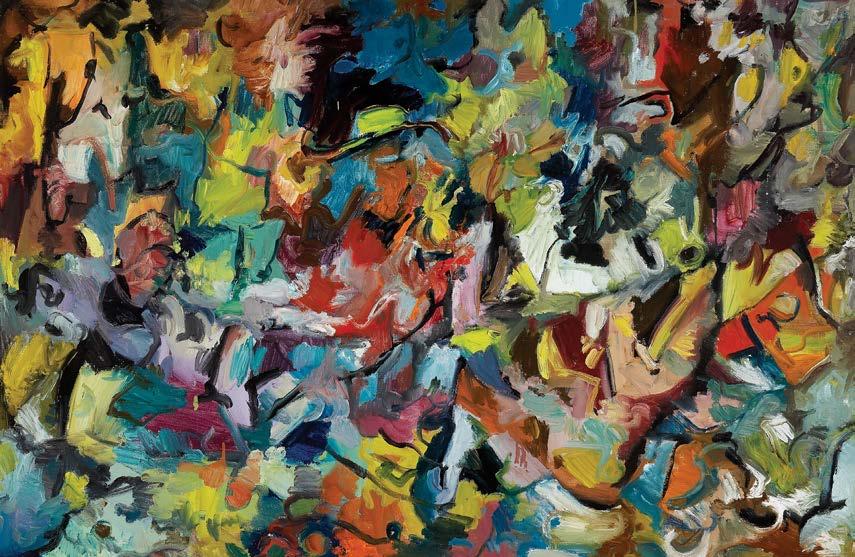
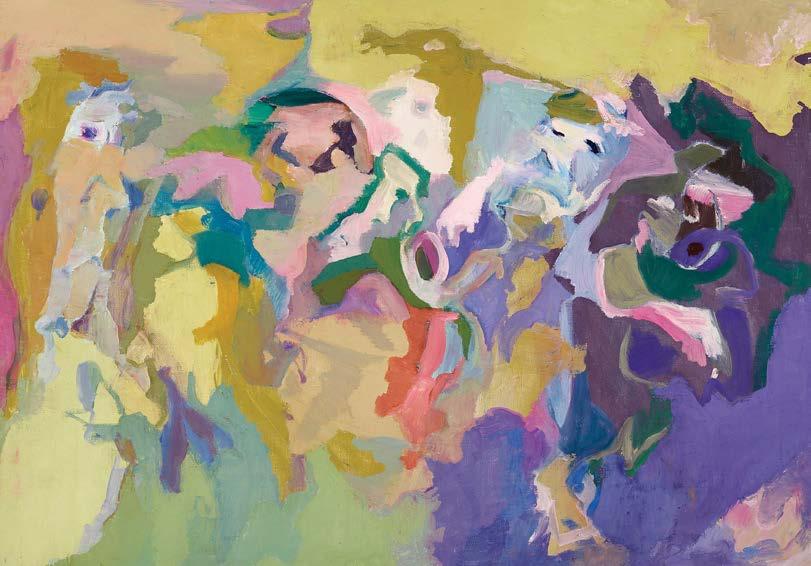
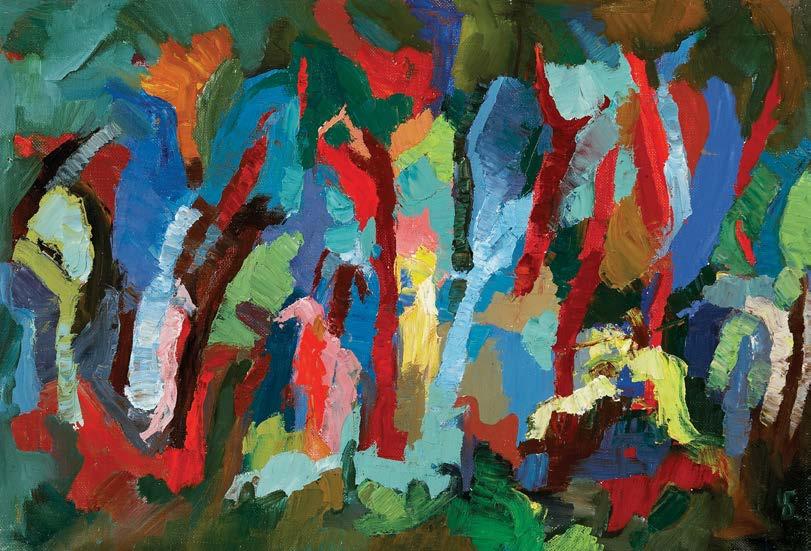
Встреча ( The Meeting ) Acrylic on Canvas, 1990, 28 × 39 inches (70 cm × 98 cm)
Сумасшедшие (Lunatics) Acrylic on Canvas, 1990, 20 × 30 inches (50 cm × 75 cm)
Коррида (Corrida)
Acrylic on Canvas, 1990, 24 × 32 inches (60 cm × 80 cm)
Overall, Chetkov’s manner tends to have an emblematical quality and optical discipline. Then suddenly, the logic of form seems to collapse, to deconstruct, taking on an unforeseen volume, swelling up to a baroque physical mass, shaped by lines. The lines become almost physical and three-dimensional in the quality of their relief, possessing a tension of material mastery that seems more characteristic of a woodcut. This effect of deconstruction appears conscious, for it creates the inner sense of conflict necessary to bring out Chetkov’s subliminal theme of political violence
Dr. Alexander Borovsky
Chief Curator of Contemporary Art State Russian Museum, St. Petersburg
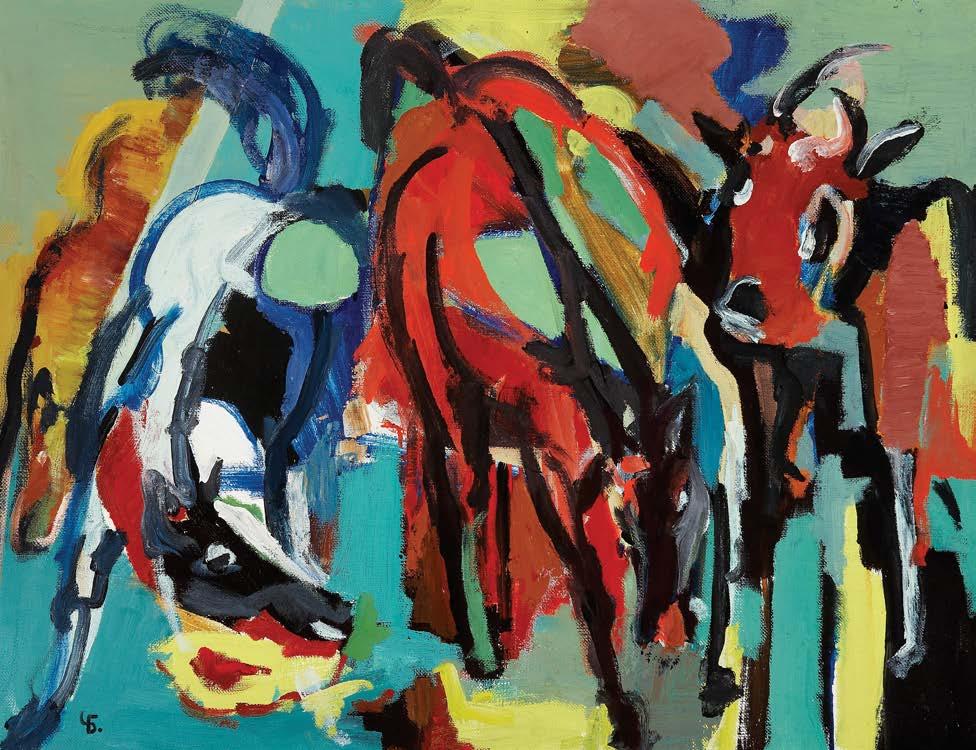
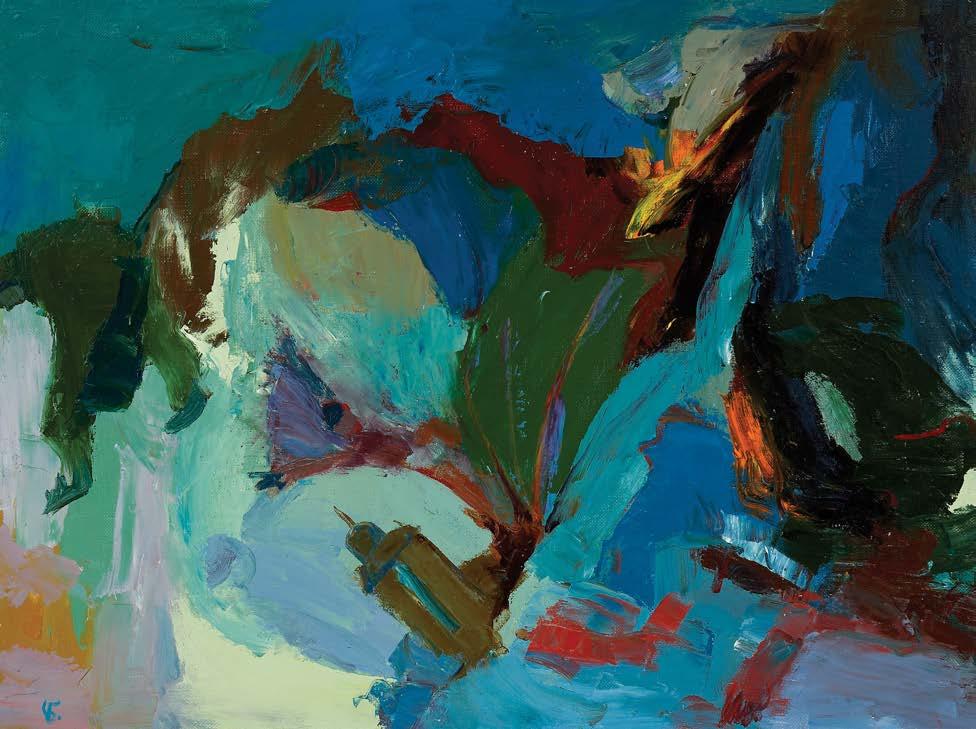
Acrylic on Canvas, 1991, 24 × 32 inches (60 cm × 80 cm)
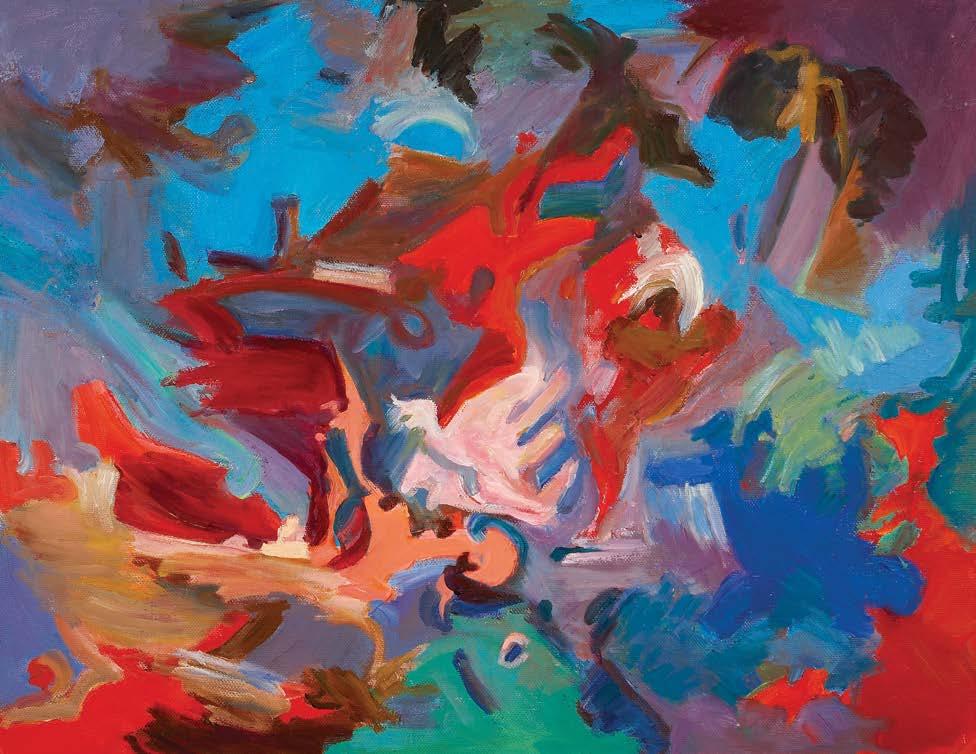
Брачный призыв (Mating Call)
Acrylic on Canvas, 1990, 28 × 35 inches (70 cm × 88 cm)
Influenced by the discoveries of avant-garde music of the early 20th century, Chetkov mentally lays out a musically inspired network of color in Mating Call, signifying the prototype for a canon, for a working model, creating a color complex-rhythm on the canvas whipped and swirled, clamped and stapled, with no top and no bottom.
Dr. Alexander Borovsky
Chief Curator of Contemporary Art State Russian Museum, St. Petersburg
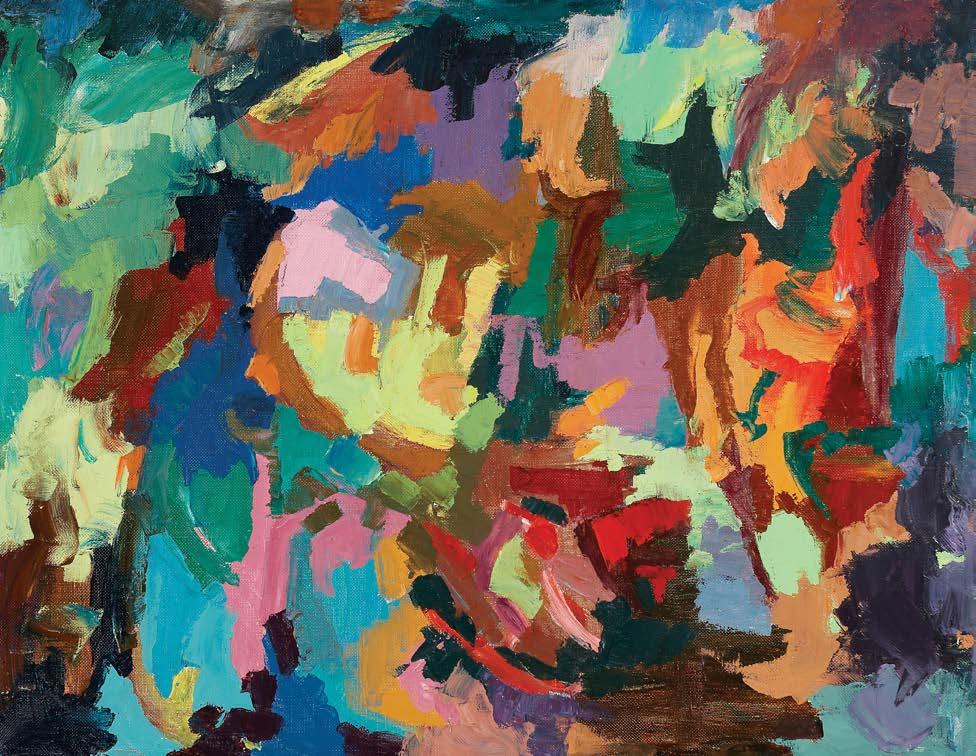
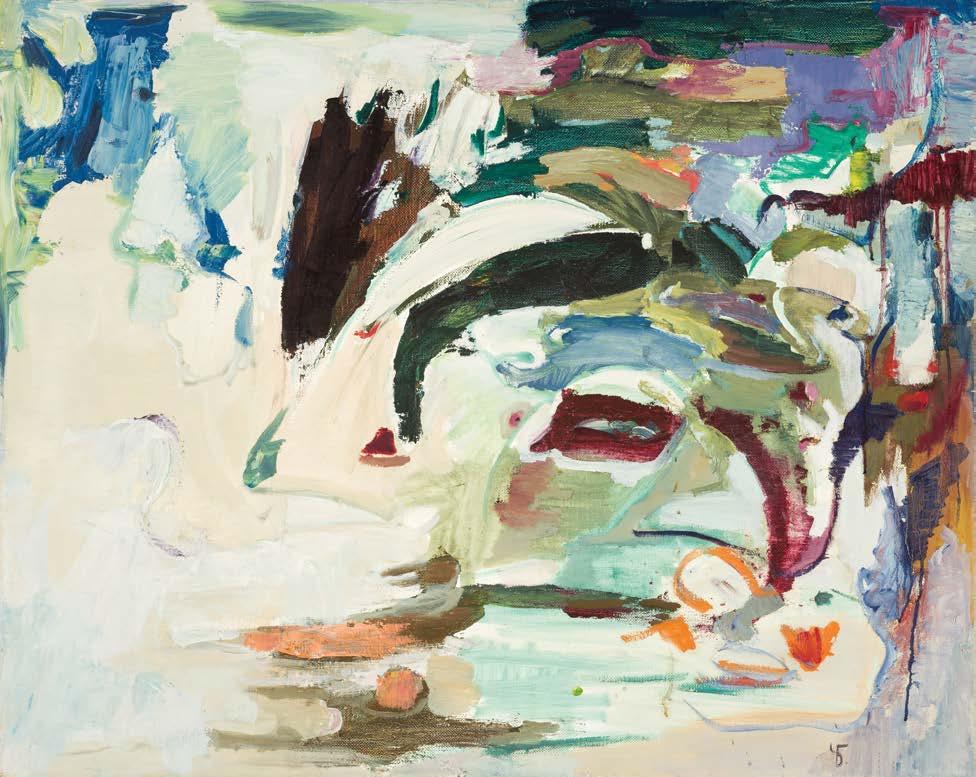
Падение Фаэтона (Fall of Phaeton)
Oil on Canvas, 1990, 32 × 39.5 inches (80 cm × 100 cm)
Миграция пингвинов (Penguin Migration) >
Acrylic on Canvas, 1991, 32 × 40 inches (80 cm × 100 cm)
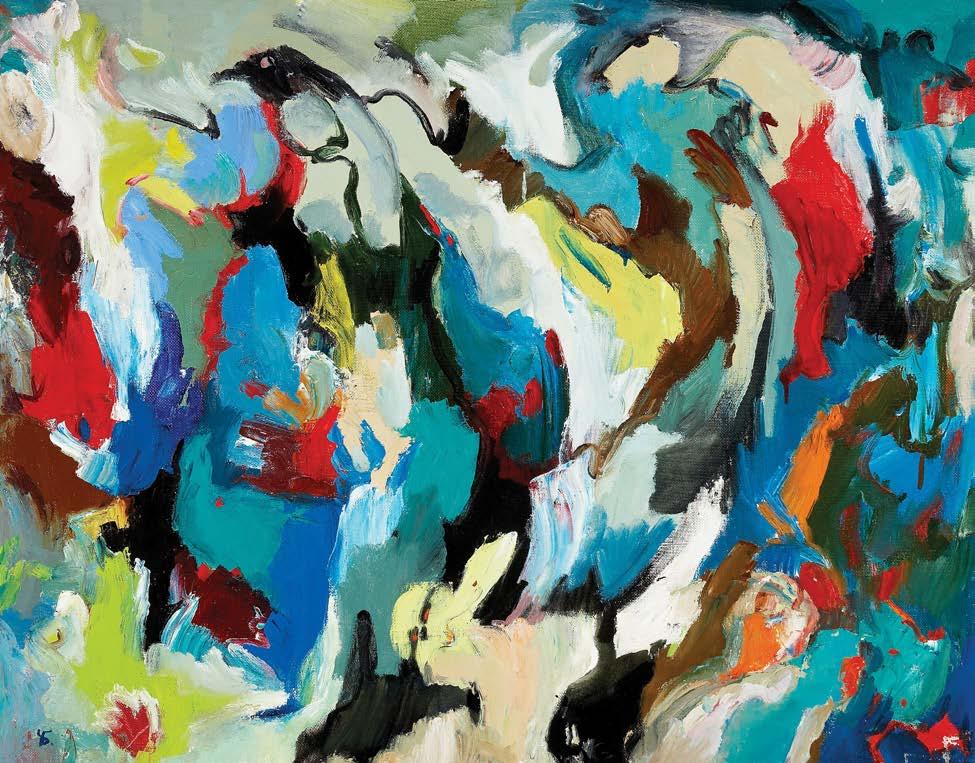
In a tribute to this enigmatic sojourner, Chetkov portrays the arduous trek with simultaneous brushstrokes, juxtaposed contrasting colors and his familiar counterclockwise rhythm, creating drama around a journey that he could personally relate to.
Kenneth Pushkin Russian Postwar Researcher and Collector
Фантастический остров (Fantasy Island)
Acrylic on Canvas, 1991, 32 × 32 inches (80 cm × 80 cm)
Рождество (Christmas) >
Acrylic on Canvas, 1989, 39 × 32 inches (98 cm × 80 cm)
Boris Chetkov, the stand-alone pioneer of Abstract Expressionism in Russia, living behind a cultural iron curtain, somehow came to the same conclusions as his celebrated western contemporaries, Willem de Kooning and Frank Auerbach, among others.
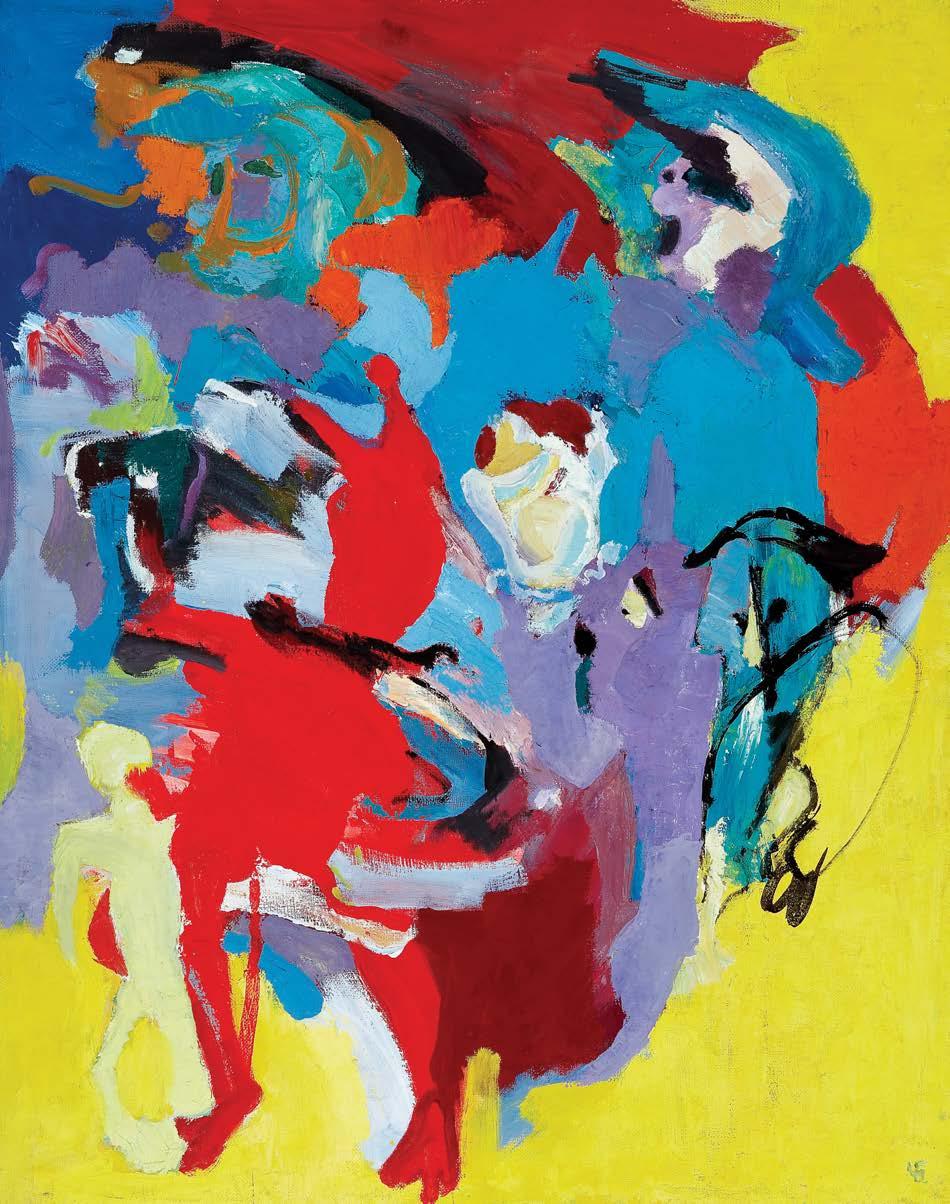
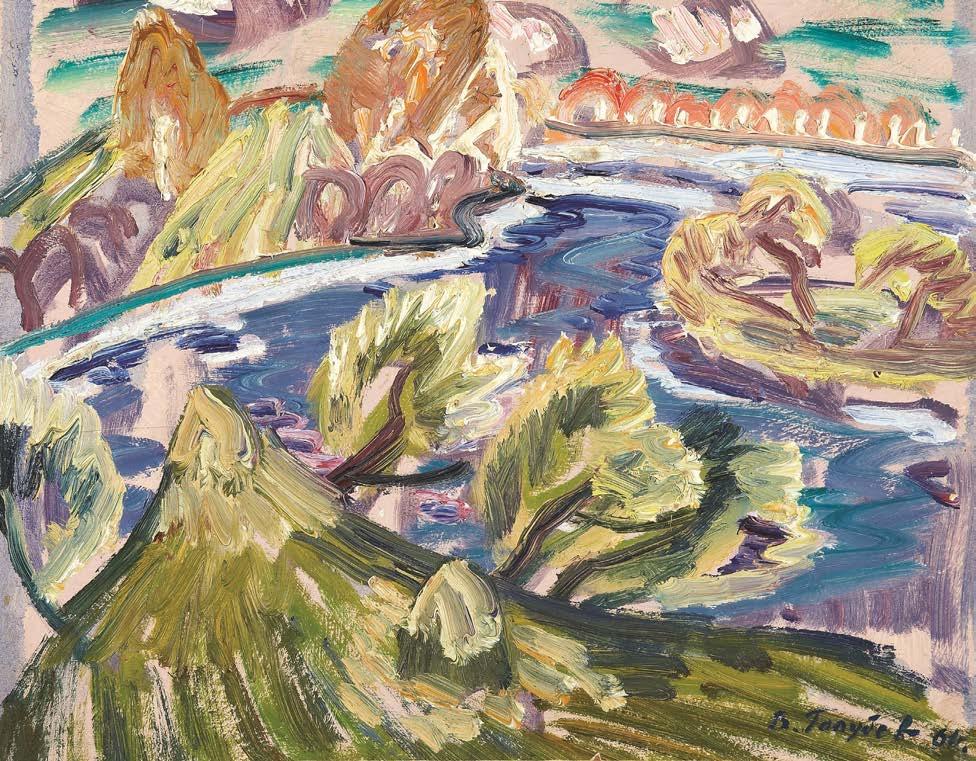
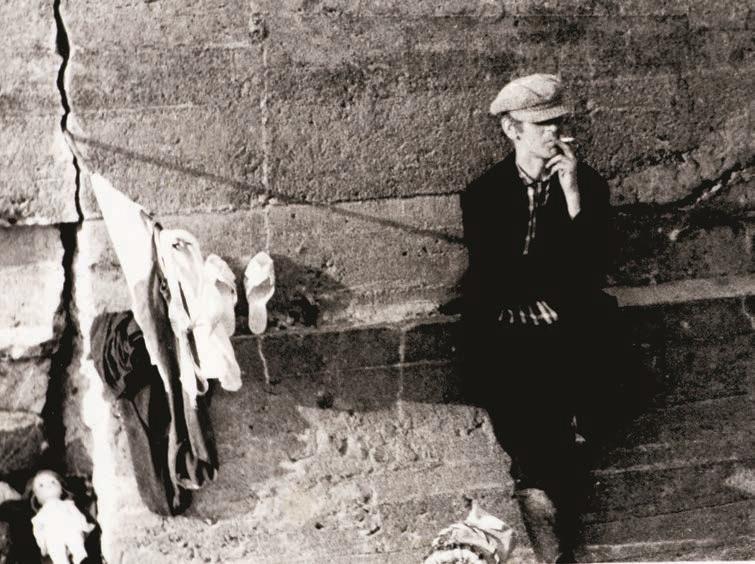
During the postwar period in the USSR, when Golubev received his education, art was simply dangerous. Deviation from the mandated norm of Social Realism was considered ideologically slanted and an anti-government activity.
Yet, even in the face of totalitarian oppression, Golubev found optimism and the courage to express what was in his heart engaging in the forbidden art of Expressionism.
While his personal version of Expressionism was independent of any connection to or knowledge of the artistic trends of the West, he reached many of the same conclusions as Edvard Munch and Raoul Dufy, among others.
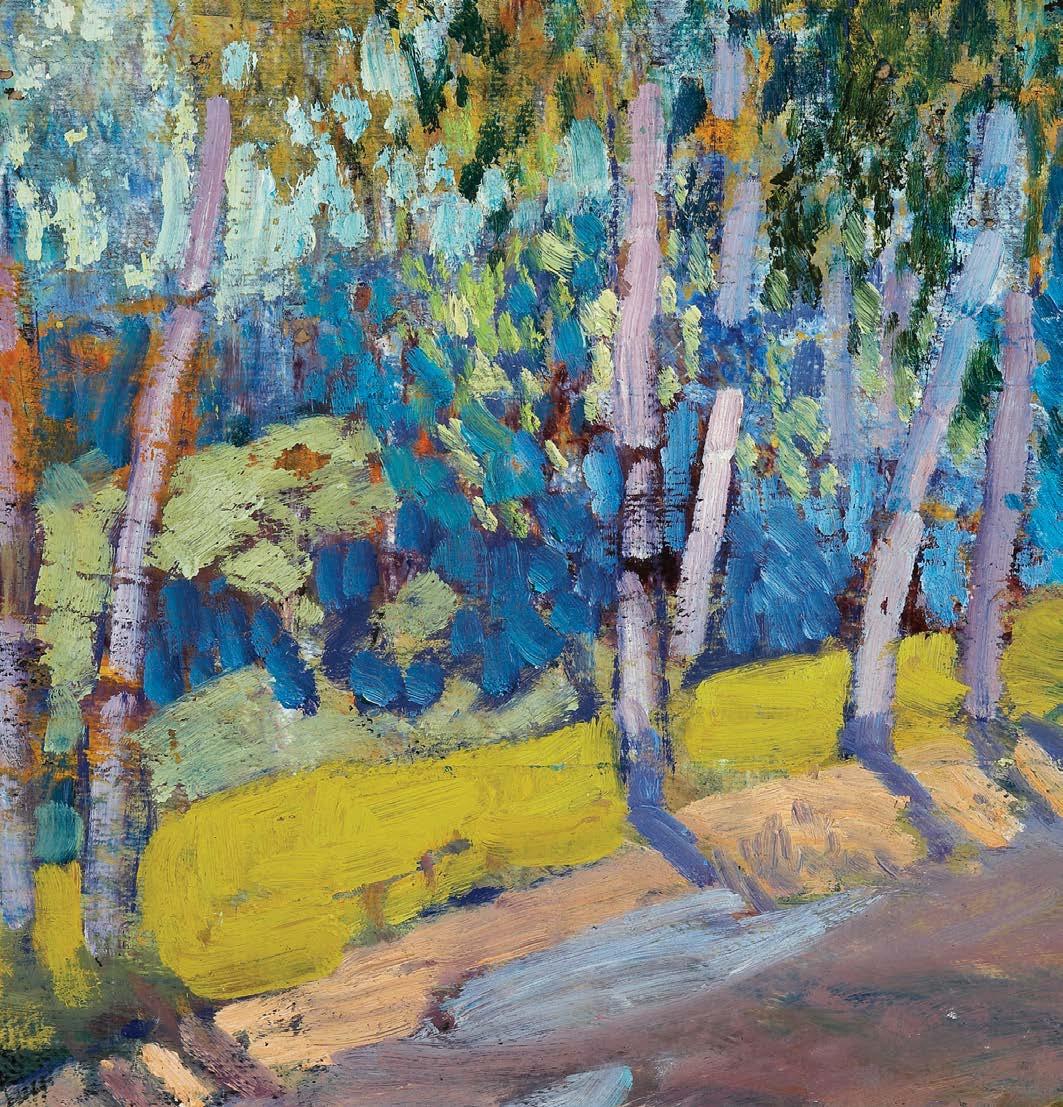
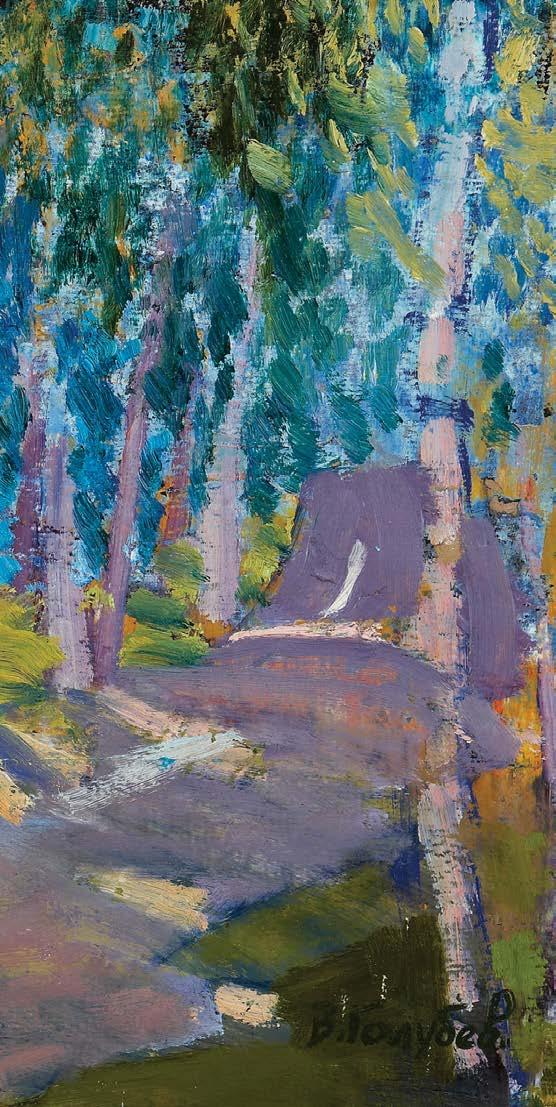
Солнечный свет сквозь деревья (Sunlight Through the Trees)
Oil on Masonite, 1957, 13 × 18 inches (33 cm × 45 cm)
Golubev combined a naïve, folksy view of the world with his personal suffering, delivering an intense, contemporary statement with an unassuming painterly approach.
Dr. Albert Kostenevich
Keeper of Impressionist Paintings
State Hermitage Museum, St. Petersburg
VASILY GOLUBEV: THE FORBIDDEN ART OF EXPRESSIONISM
Мартовские хлопоты (March Chores)
Oil on Masonite, 1959, 27.5 × 29.5 inches (70 cm × 75 cm)

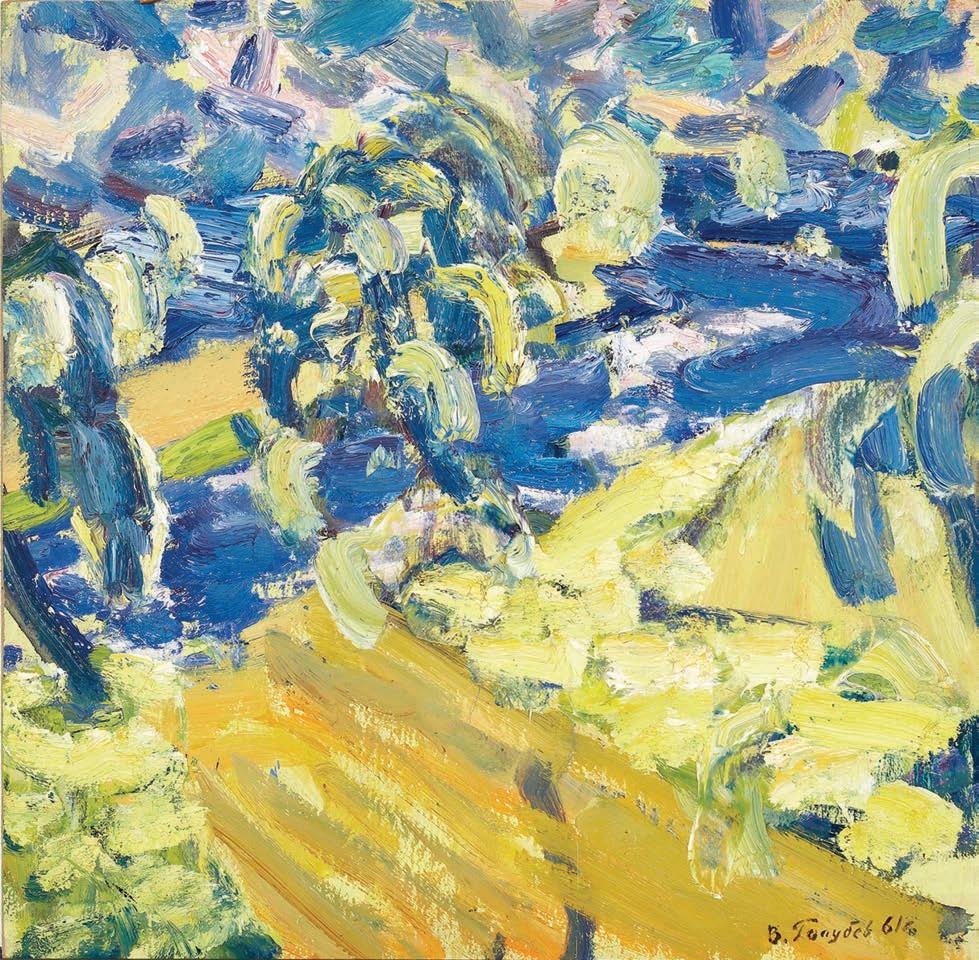
Синий апрель (Blue April)
Oil on Masonite, 1961, 23 × 23 inches (58 cm × 58 cm)
In Blue April, Golubev works with states of consciousness with richly painted, blinding streams of melted golds and blues, a mirage in which he transforms the modest coloring of the northern steppe landscape into heavy splashes of color, creating a unique and distinctive lyrical journey.
Dr. Alexander Borovsky
Chief Curator of Contemporary Art
State Russian Museum, St. Petersburg
VASILY GOLUBEV: THE FORBIDDEN ART OF EXPRESSIONISM
Кухонная скамейка (Kitchen Bench)
Oil on Masonite, 1961, 26 × 34 inches (65 cm × 85 cm)
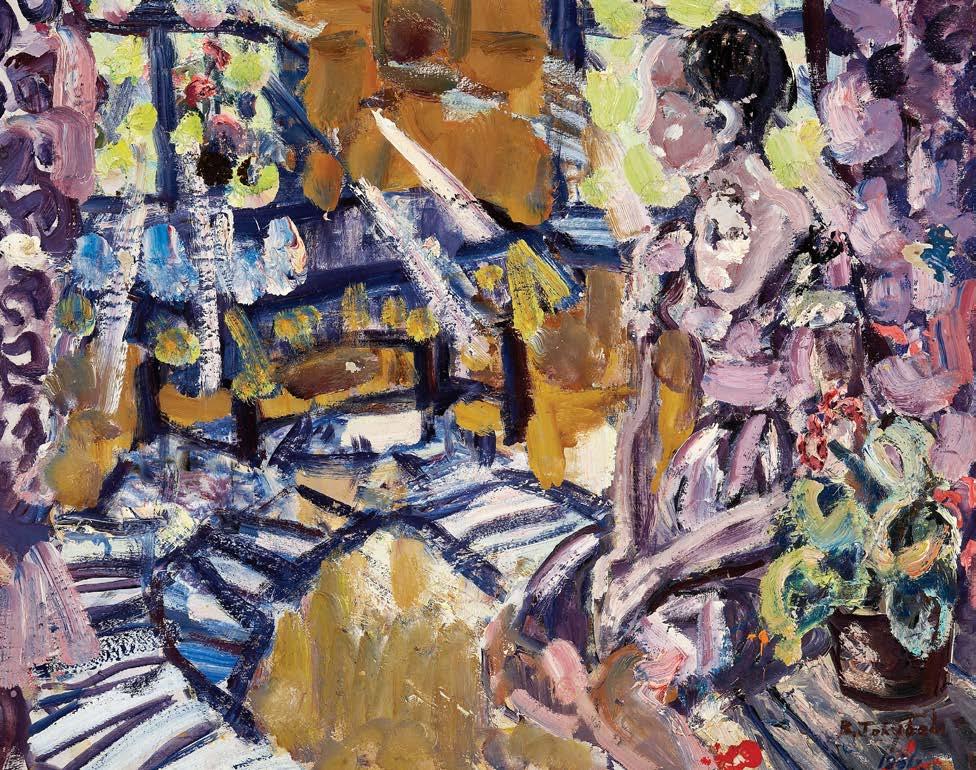
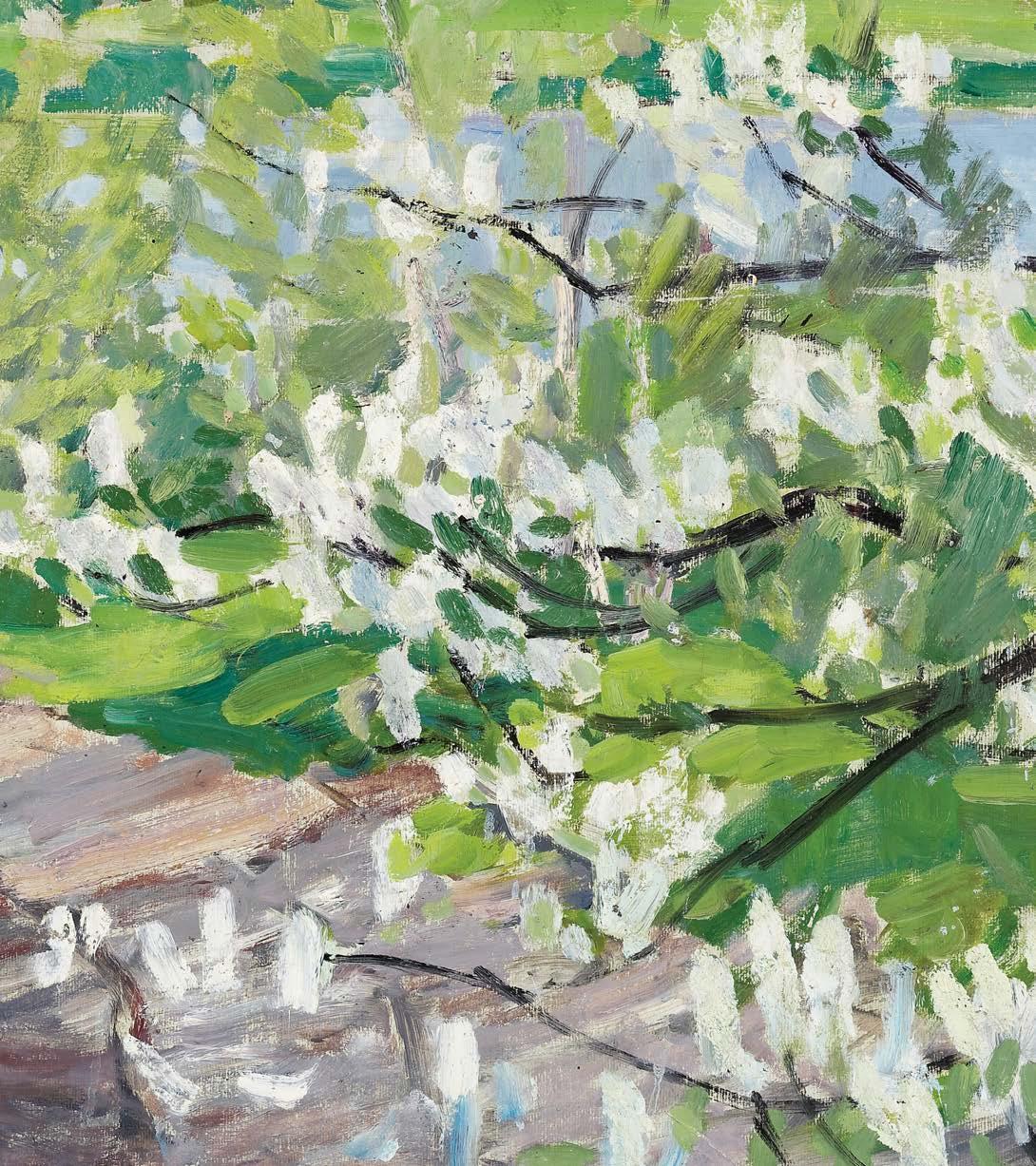
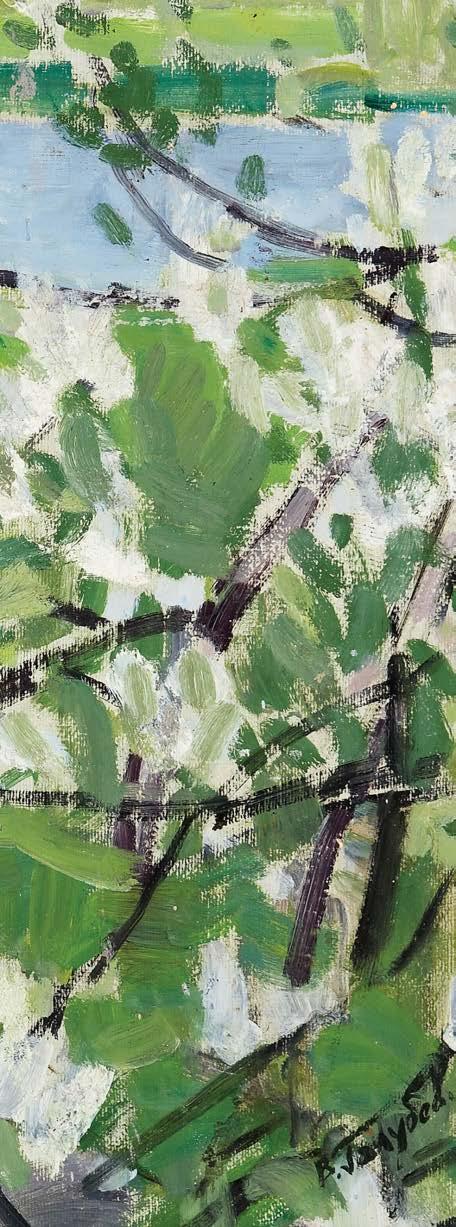
Весенние цветы (Spring Blossoms)
Oil on Panel, 1962, 21 × 33 inches (53 cm × 83 cm)
In the works of the Expressionist trend there are undoubted victories, above all in the plasticity, the molding and formation of the painted surface: it is dynamic, tense with energy, preserving to use Yuri Tynyanov’s term “rude strength.” Yet there is a flipside to this attacking, aggressive expression, in the sense of a certain unfinished quality in the painterly composition. Golubev felt all these contradictions and sought to resolve them.
Dr. Alexander Borovsky
Chief Curator of Contemporary Art State Russian Museum, St. Petersburg
Цвета леса (Colors of the Forest)
Oil on Masonite, 1968, Triptych, 60 × 62 inches (150 cm × 155 cm)
Golubev appeared as a quiet, introverted man estranged from the tenets and rigid standards of the Soviet art world. During the Postwar period, when he received his education, art was simply dangerous. Deviation from the mandated norm of Social Realism was considered an anti-government activity. Yet, even in the face of totalitarian oppression, Golubev found optimism and the courage to express what was in his heart engaging in the forbiden art form of Expressionism.
Dr. Albert Kostenevich
Keeper of Impressionist Paintings
State Hermitage Museum, St. Petersburg
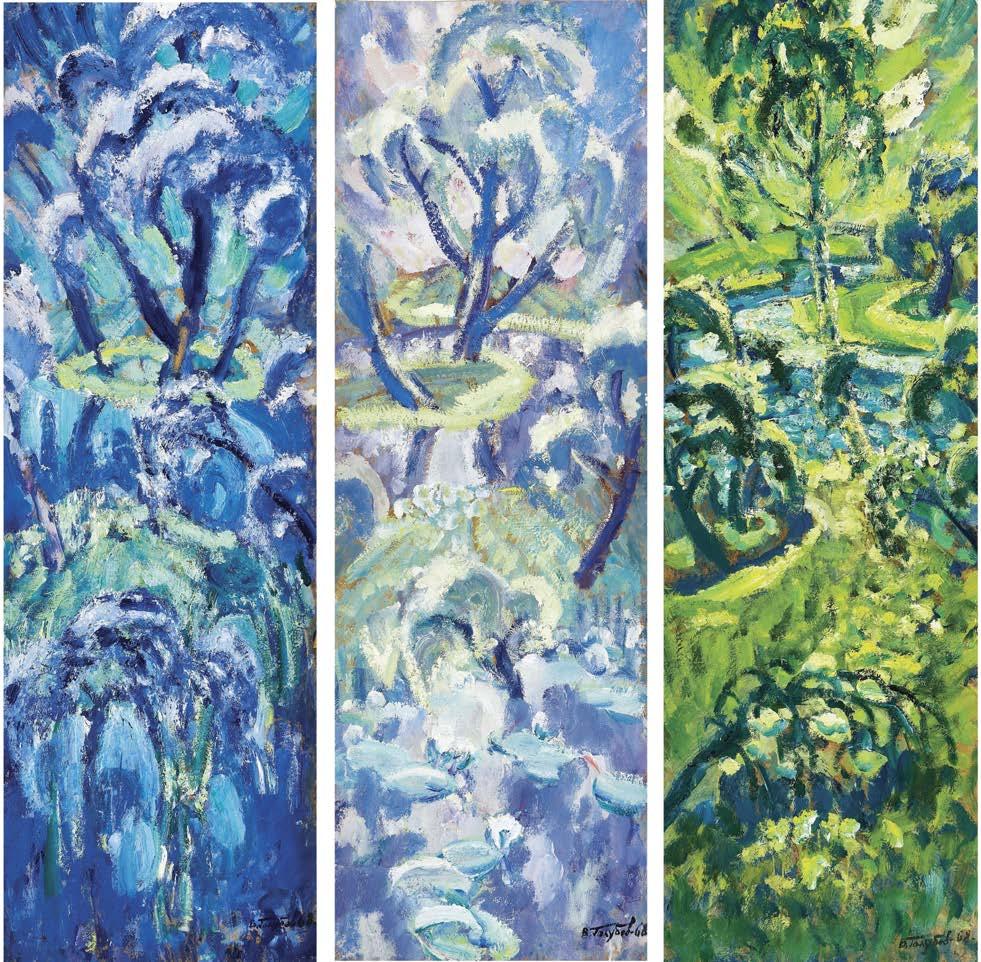
Полдень (Afternoon)
Oil on Masonite, 1969, 17 × 20 inches (43 cm × 50 cm)
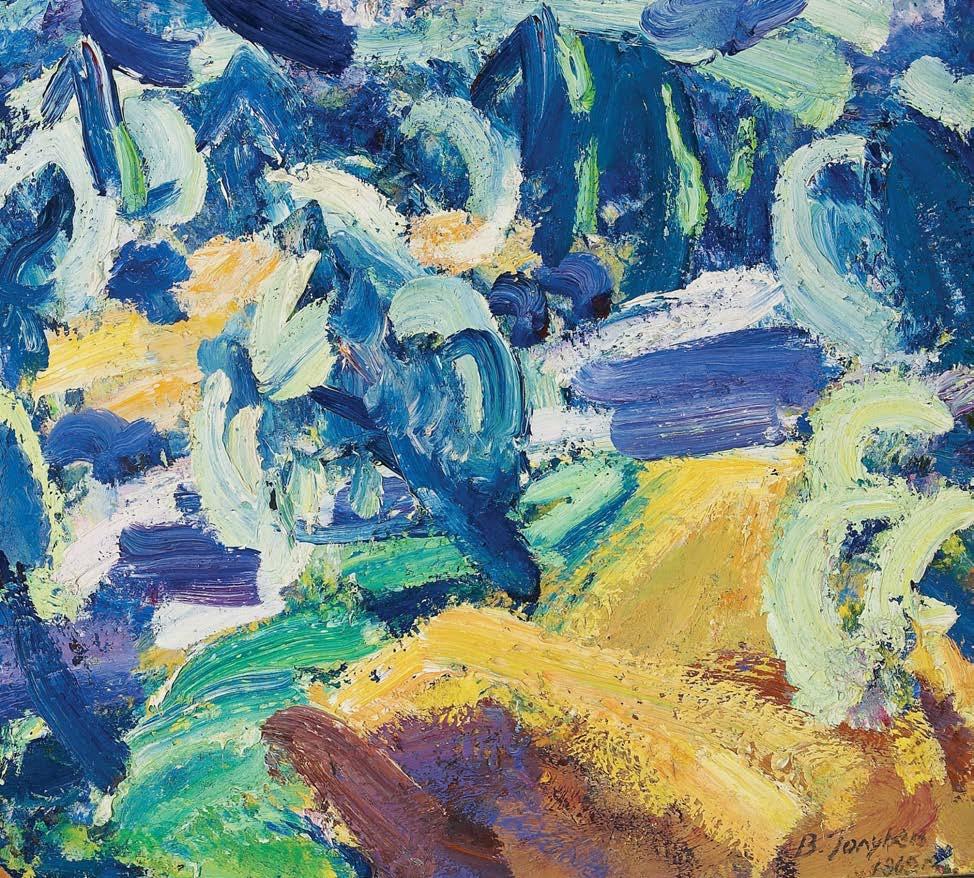
Весенние бризы (Spring Breezes)
Oil on Masonite, 1969, 28 × 31inches (70 cm × 78 cm)
We feel here the bombast of the demiurge, a would be creator, albeit somewhat naïve and simple: Golubev is not simply painting nature but, as it were, competing with her in the creation of form.
Dr. Albert Kostenevich
Keeper of Impressionist Paintings
State Hermitage Museum, St. Petersburg
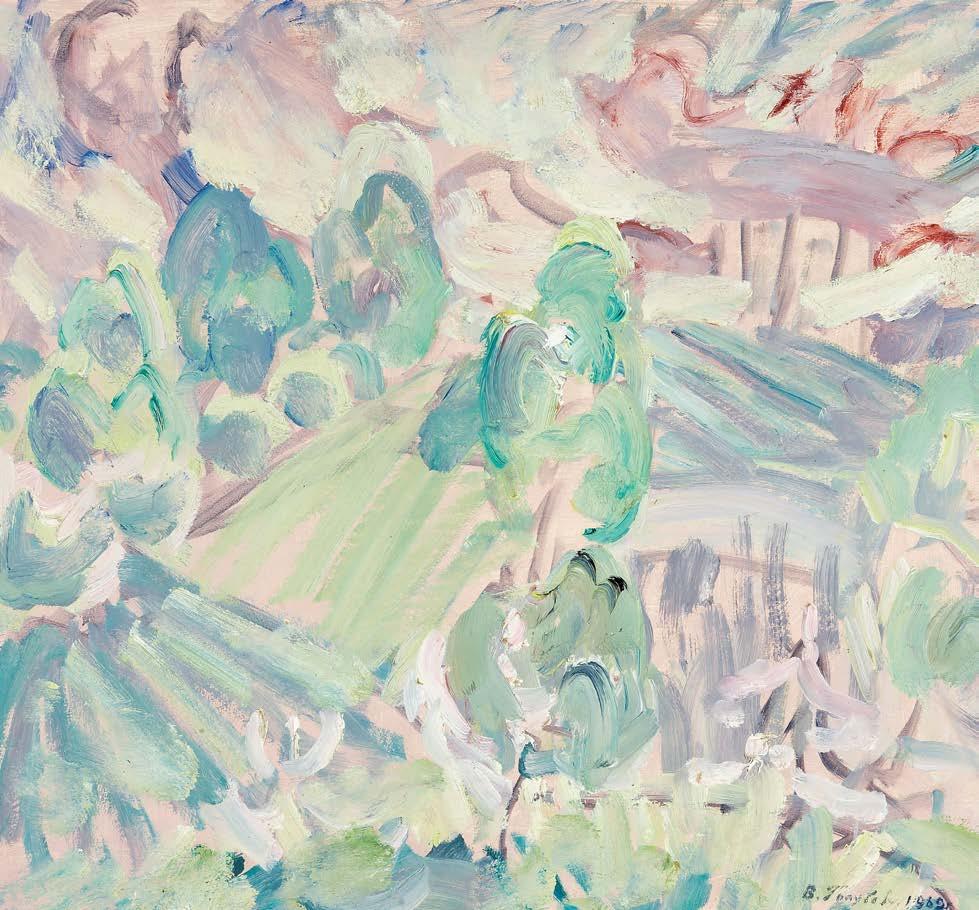
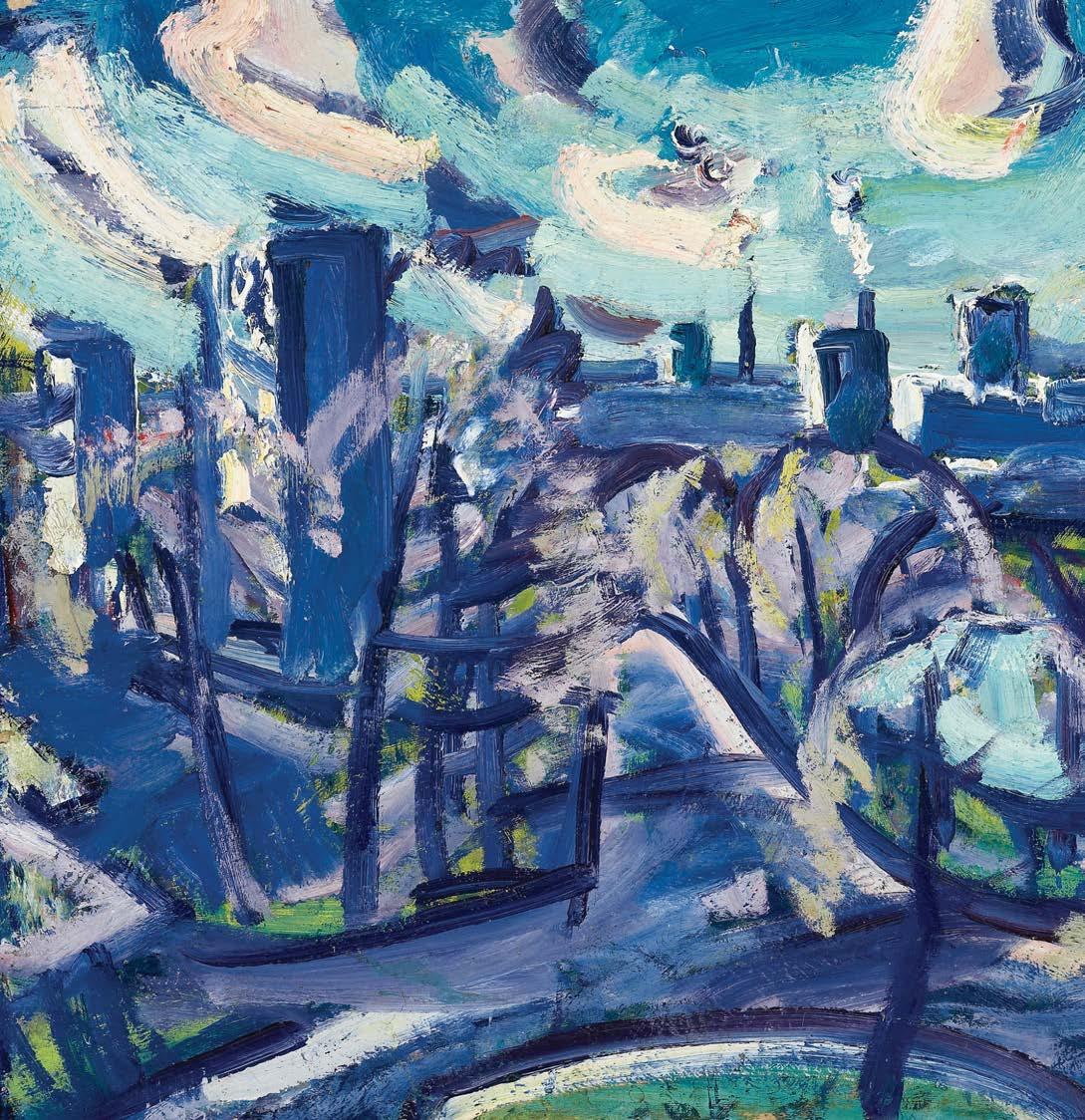
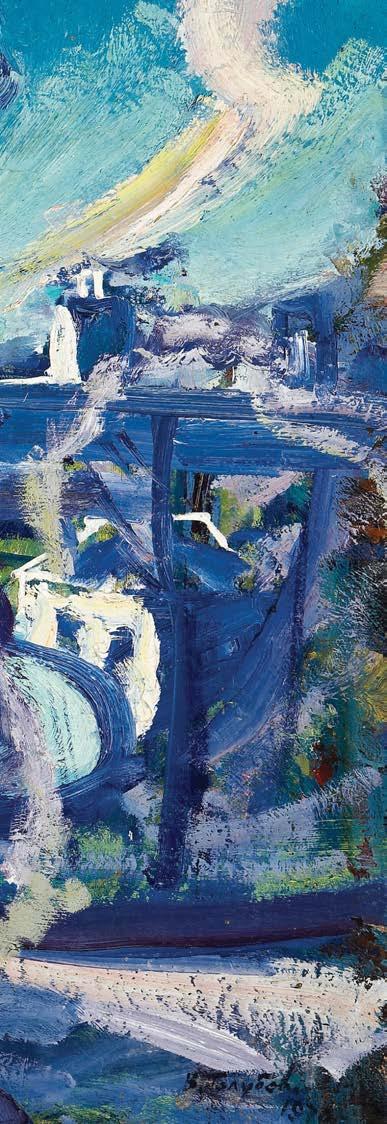
Зимний городской пейзаж (Winter Cityscape)
Oil on Masonite, 1970, 27 × 36 inches (68 cm × 90 cm)
Рабочие ( The Workers)
Oil on Masonite, 1970
13 × 18 inches (33 cm × 45 cm)
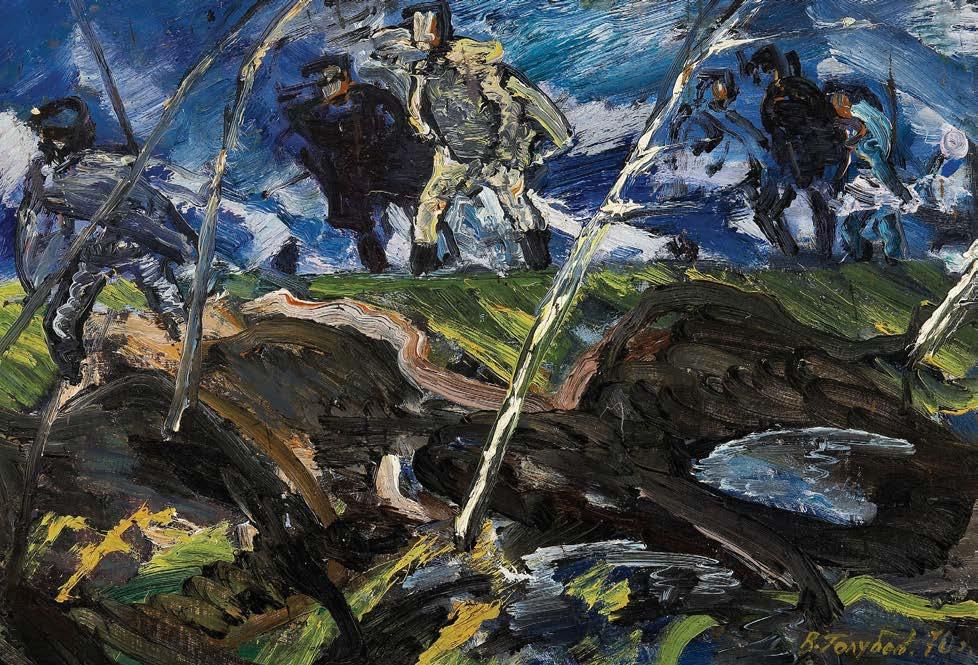
Таня (Tanya)
Oil on Masonite, 1973, 38 × 30 inches (95 cm × 75 cm)
Golubev is precise and selective in his choice of the natural situation in relationship to the figure. In Tanya he integrates the figure into a swirling palette of color and texture, organically placing the subject within spatial context. If the first function of the figure is architectural, the second is to warm and humanize the image.
Dr. Alexander Borovsky
Chief Curator of Contemporary Art
State Russian Museum, St.Petersburg
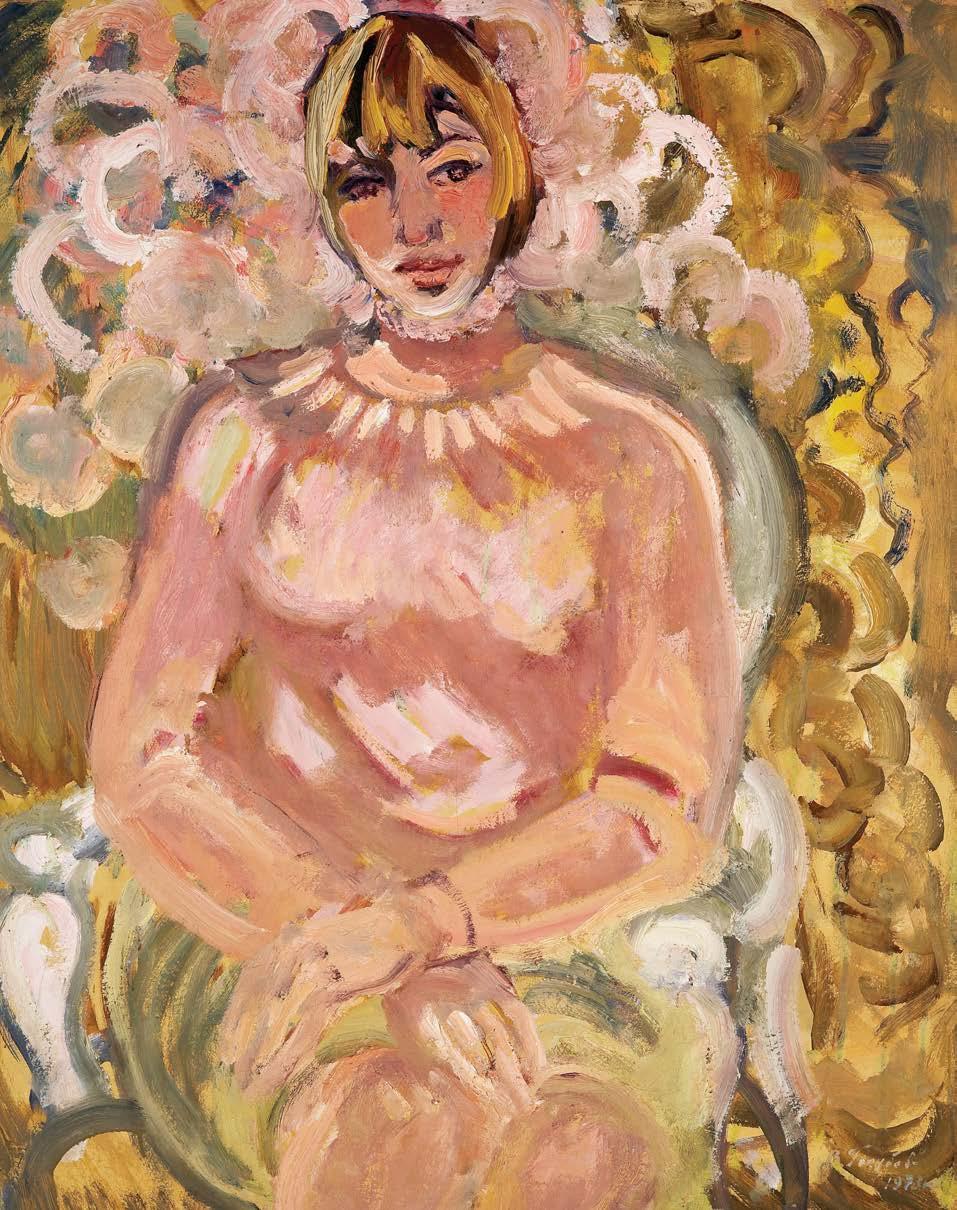
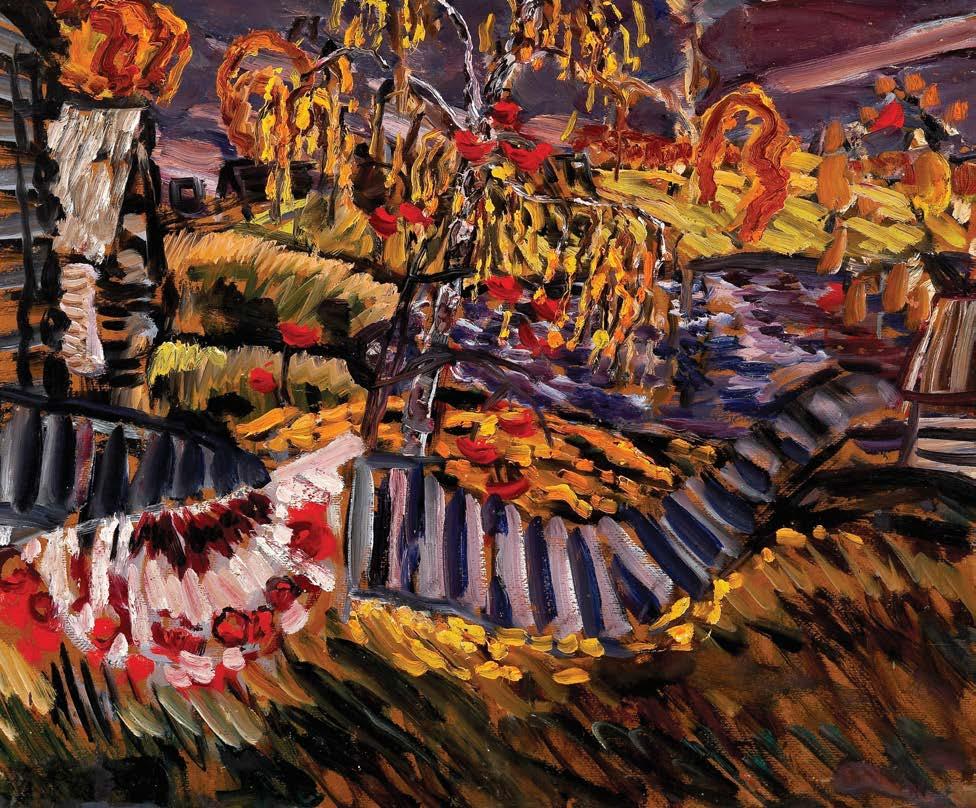
Ступеньки к бане (Steps to the Banya)
Oil on Masonite,1973, 30 × 35 inches ( 75 cm × 93 cm)
In Steps to the Banya, Golubev works with states of consciousness: blinding streams of melted color, a mirage into which he transforms an everyday staircase and turns it into a lyrical journey to the bathhouse ... a dreamer and visionary, a meditator.
Dr. Albert Kostenevich
Keeper of Impressionist Paintings
State Hermitage Museum, St. Petersburg
VASILY GOLUBEV: THE FORBIDDEN ART OF EXPRESSIONISM
Аромат весны (The Scent of Spring)
Oil on Masonite, 1973, 35 × 25 inches (88 × 63 cm)
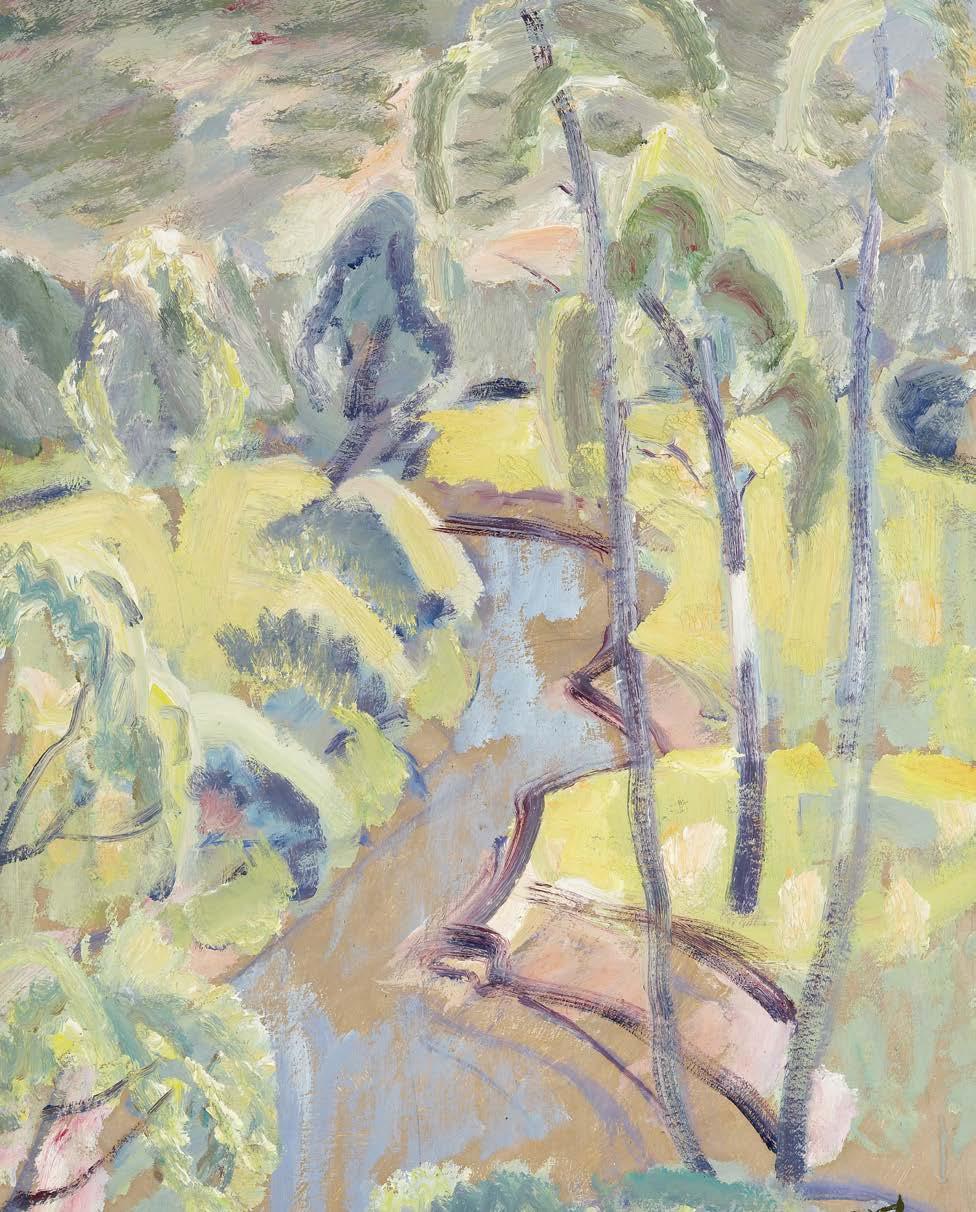
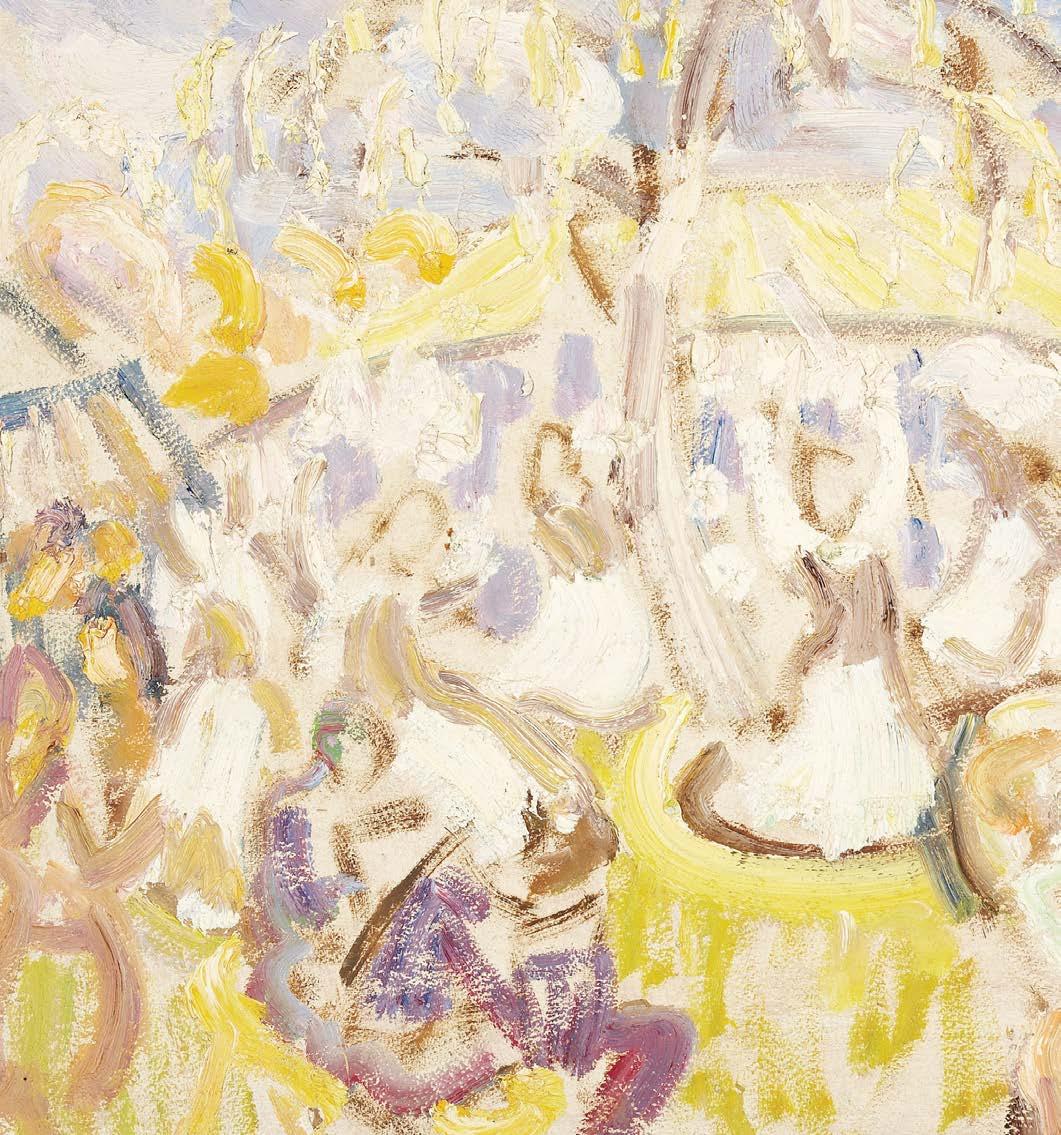
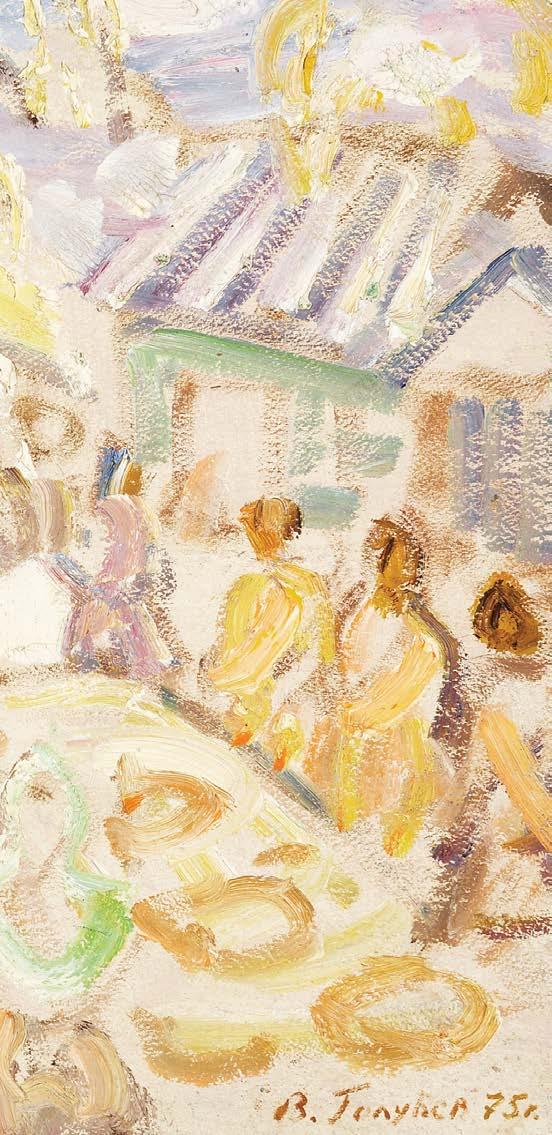
Деревенский Празник (Village Banquet)
Oil on Masonite,1975, 20 × 28 inches (50 cm × 70 cm)
The cultural historian Alexander Etkind wrote: ”Symbolism had already turned deep levels and altered states of consciousness, states which previously remained as if outside culture dreamy, meditative, hypnotic and so on into the material of creativity.”
Golubev’s Village Banquet embodies this notion. The soft colors are dematerialized creating a subtle sense of light from the center and with the impasto painted silhouettes, it overall conveys a certain quality of being ‘out of time’, divorced from situations and ties of life itself.
Dr. Albert Kostenevich
Keeper of Impressionist Paintings State Hermitage Museum, St. Petersburg
Летняя буря (Summer Storm)
Oil on Masonite, 1978, 22 × 22 inches (55 cm × 55 cm)
During the post-war period, when Golubev received his education, art was simply dangerous. Deviation from the mandated norm of social realism was considered ideologically slanted and an antigovernment activity. Yet, even in the face of totalitarian oppression, Golubev found optimism and the courage to express what was in his heart engaging in the forbidden art form of Expressionism.”
Dr. Albert Kostenevich
Keeper of Impressionist Paintings
State Hermitage Museum, St. Petersburg
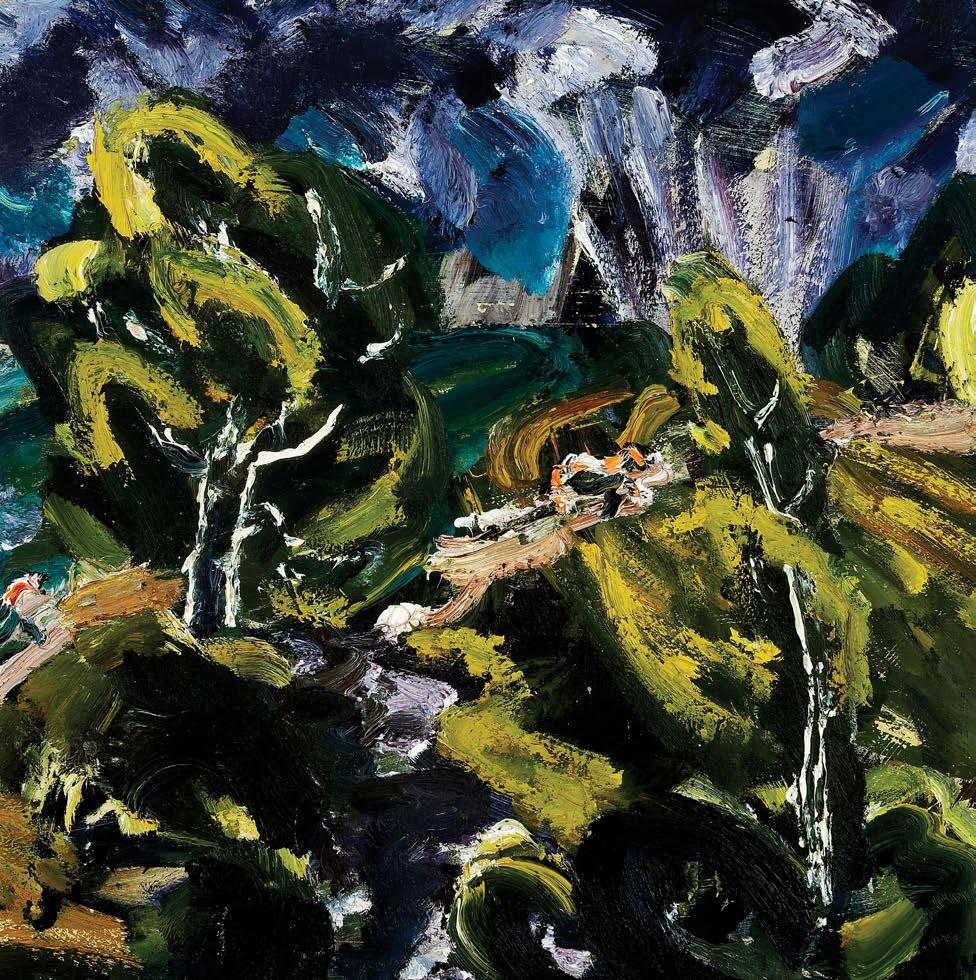
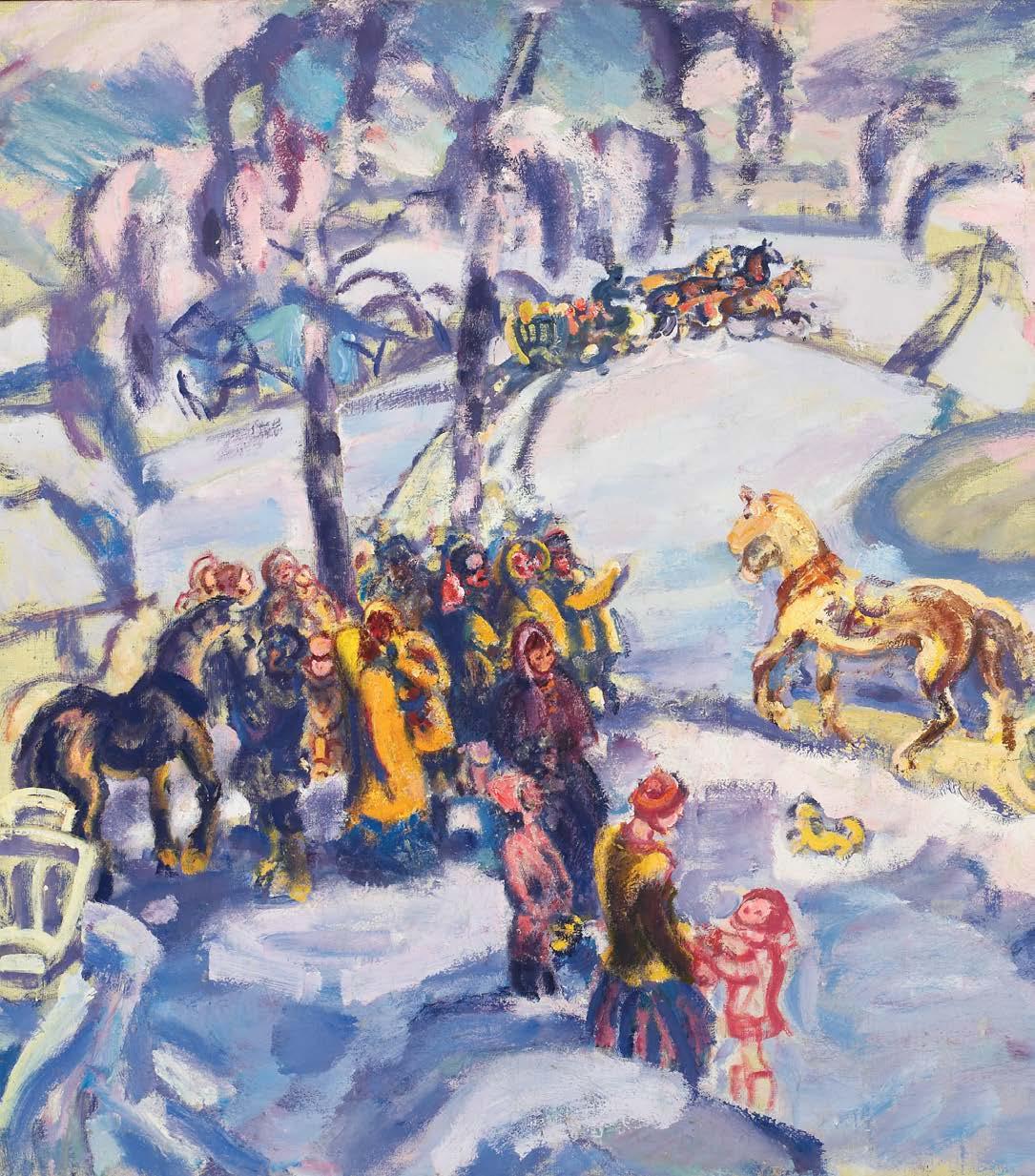
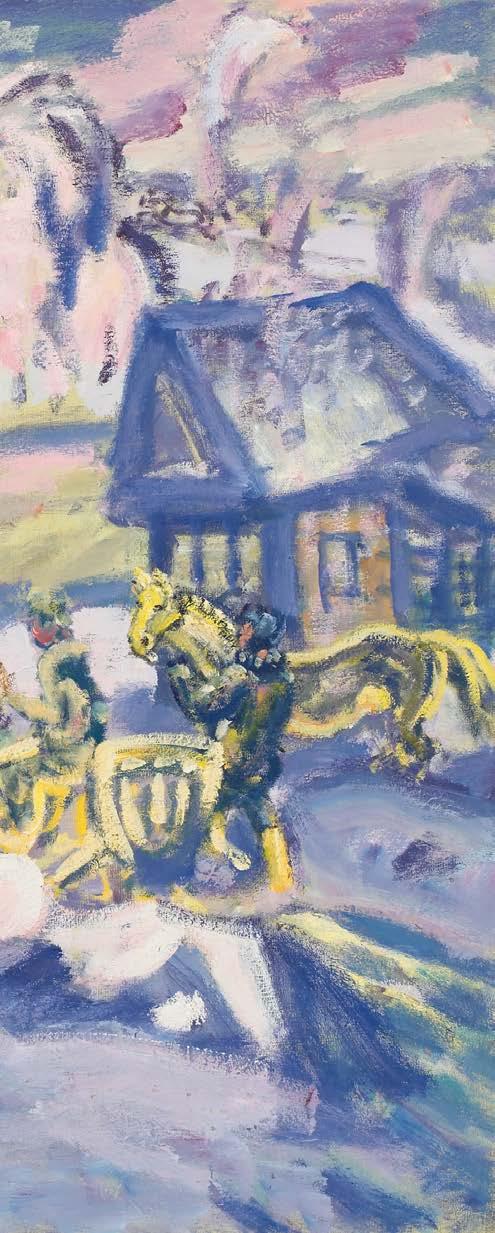
Масленица (Shrovetide)
Oil on Canvas, 1981, 55 × 70 inches (138 cm × 175 cm)
Golubev produced workingman’s genre paintings on certain occasions for instance, when the Union of Artists commissioned theme paintings for big anniversary exhibitions. These were quintessential genre paintings with ritualized content, and their production was the sole means of escaping from the extremely meager guaranteed wage, and could even be equivalent to several years’ wages. Golubev naturally dreamed of such commissions, which would allow him to get on with landscape painting independently and freely. Several times, the ‘powers that be’ met him half way, giving him commissions for large genre paintings such as Shrovetide But he was not a narrator of “correct” stories with their obligatory socially useful content. This painting appeared as parody on the 1930s iconography of Soviet Collective Farm celebrations (life in the Soviet village was hellishly difficult), while such canvases, without exception, depicted scenes overflowing with abundance: optimistic, merry, daringly and attractively painted.
Dr. Alexander Borovsky
Chief Curator of Contemporary Art State Russian Museum, St.Petersburg
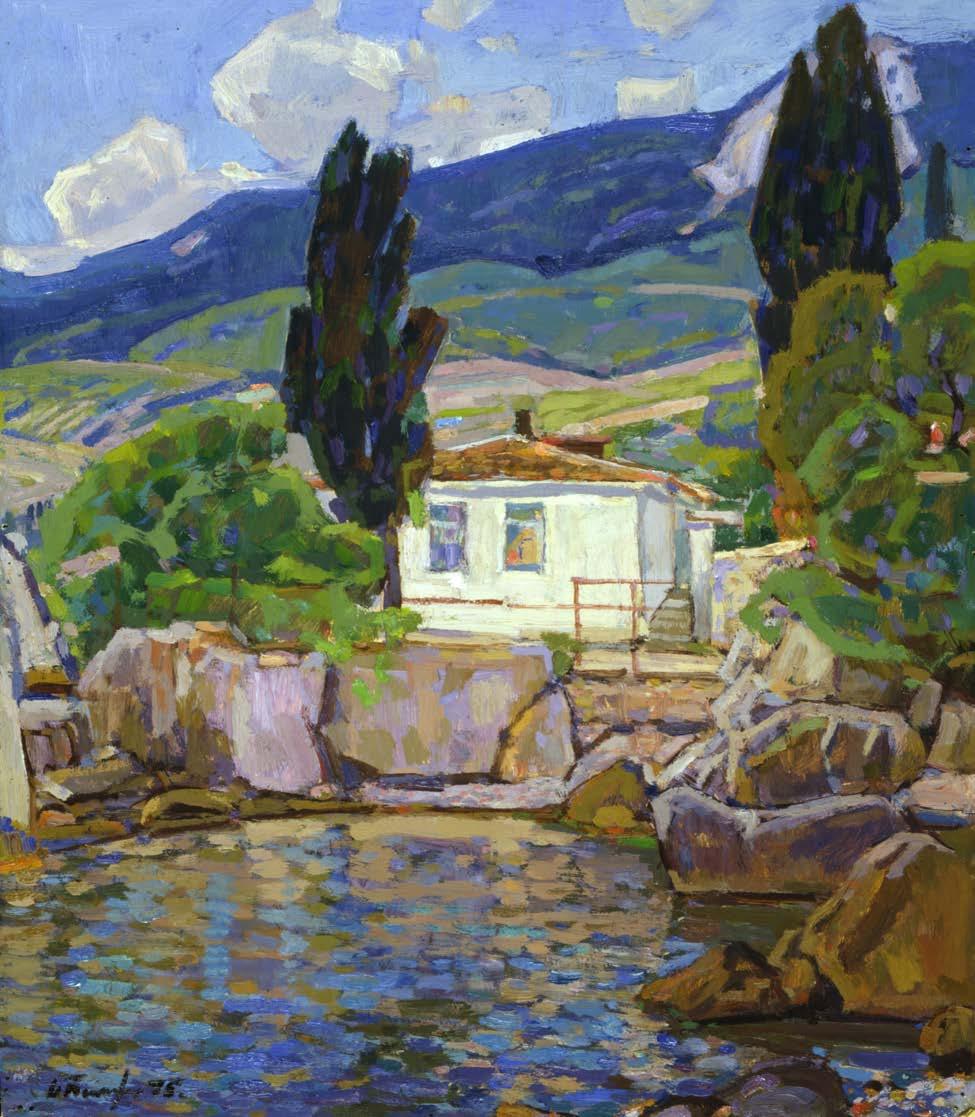
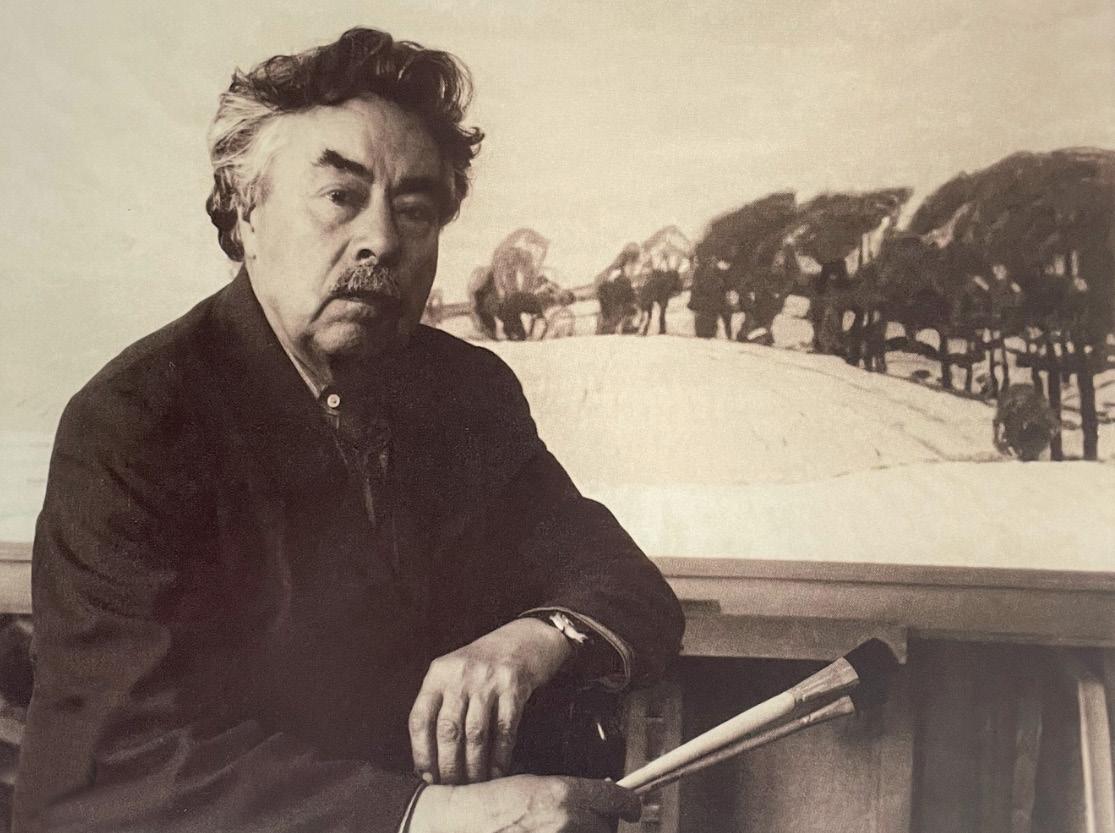
The renowned philosopher / painter, Mikhail Nesterov, mentor to the young Nikolai Timkov, once said, “Art is not just a profession, it is the high duty of an artist, of a man. Never try to deceive nature but go to it with all the love you have. Only then will it open its soul to you.”
Timkov took these words to heart, and through six decades of dedicated painting en plein-air, through every season, captured countless moments in time, in light, in stroke none the same, each work exploring new challenges in color, technique and perspective.
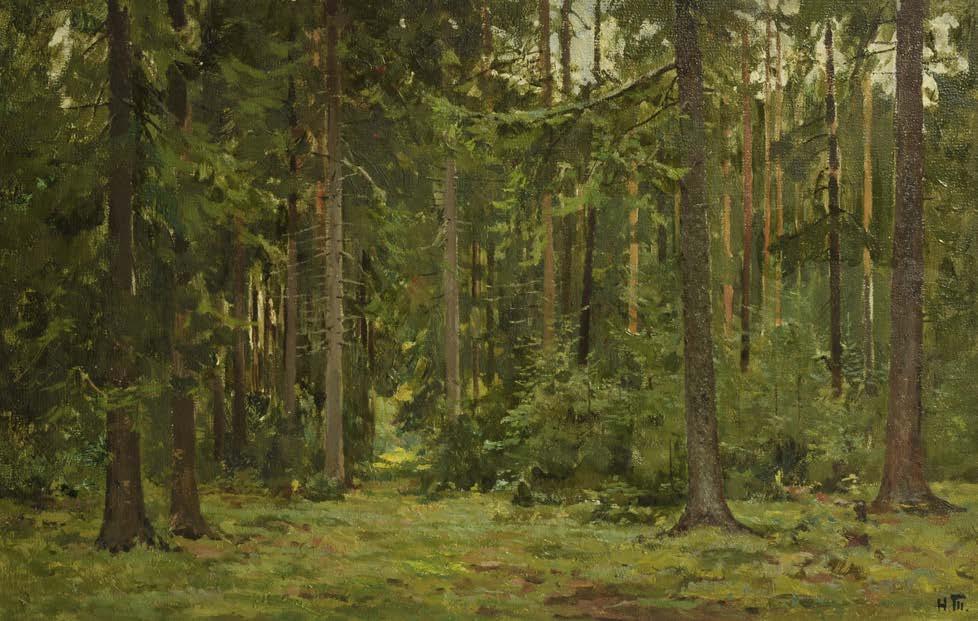
Лесная поляна (Forest Clearing)
Acrylic on Canvas, 1953, 9 × 14 inches (23 cm × 35 cm)
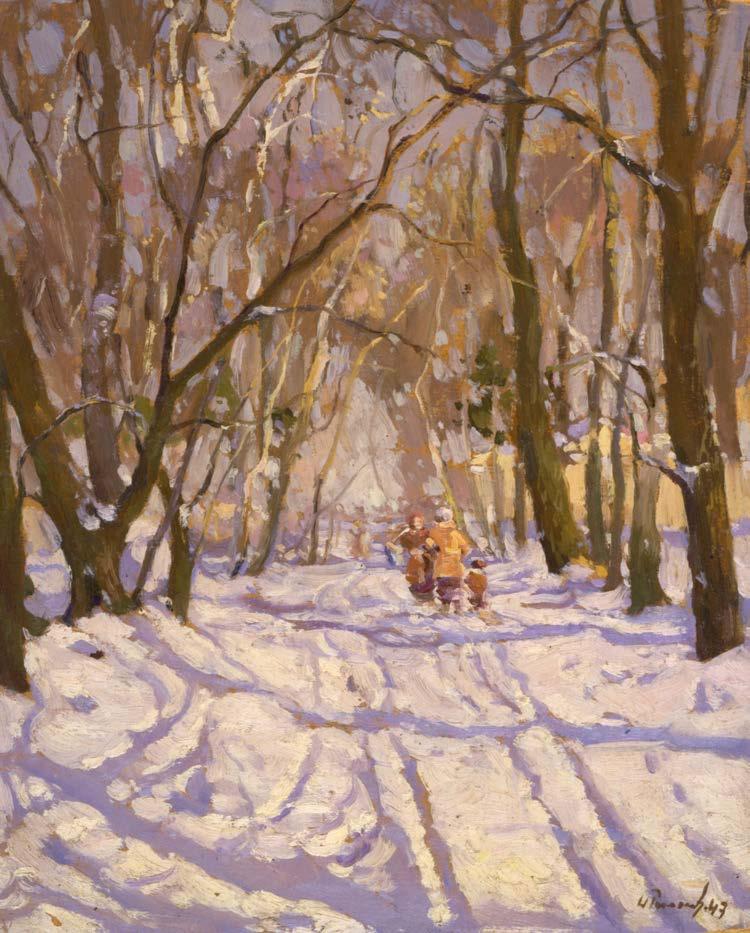
Oil on Panel, 1947, 12 × 9 inches (30 cm × 23 cm)
Зимняя прогулка ( Winter Walk)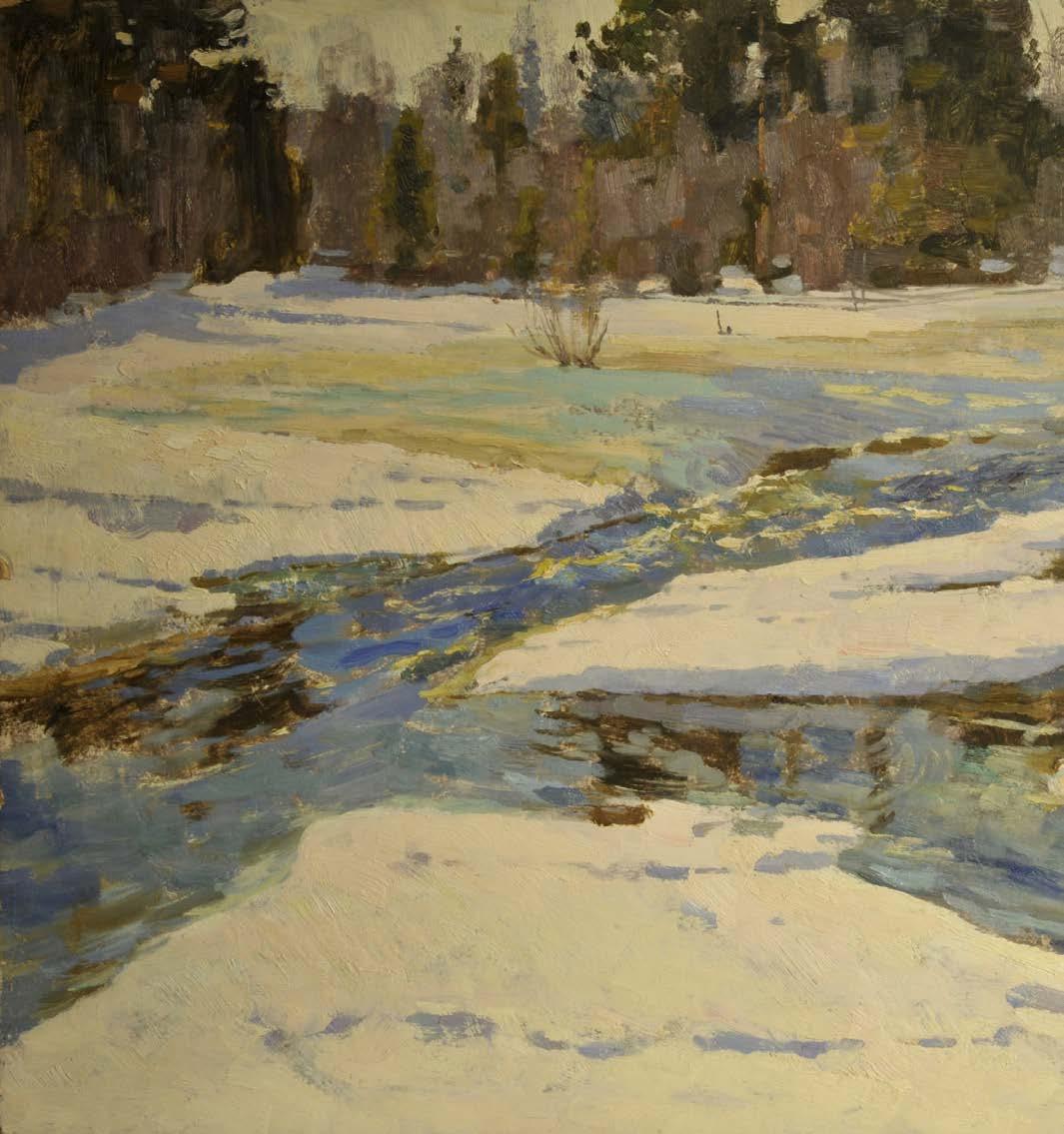
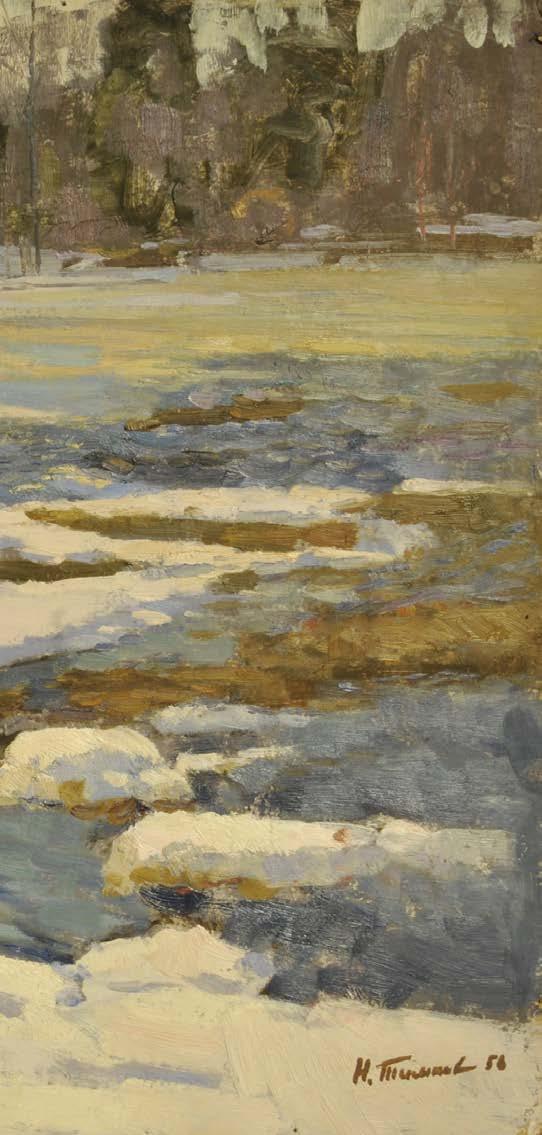
Апрель на реке (April on the River)
Oil on Panel, 1956, 20 × 28 inches (50 cm × 70 cm)
Timkov’s ‘academic’ works from the 1940s and 1950s reflect the influence of his mentor and renowned Social Realist, Isaak Brodsky (1883–1939), while hinting at the daring compositions, brushwork and palette that would become a distinguishing feature of his paintings in the years that followed.
Nina A. Dmitriyeva
Preeminent Art Historian
The Pushkin State Museum of Fine Arts, Moscow
Timkov’s small early works demonstrate a tremendous sense of scale, each work fully resolved. These paintings would hold up beautifully if they were magnified ten times larger. Indeed, not mere studies, but fully resolved compositions reflecting the high level of academic discipline acquired from his mentors, Isaac Brodsky and Mikhail Nesterov.
Nina A. Dmitriyeva
Preeminent Art Historian
The Pushkin State Museum of Fine Arts, Moscow
Вырский пейзаж (Vyra Landscape)
Oil on Panel, 1955, 7 × 16 inches (18 cm × 40 cm)
Ржаные поля в Выре (Rye Fields in Vyra)
Oil on Panel, 1956, 4 × 10 inches (10 cm × 25 cm)
Море в Горзуфе (Sea at Gorzuf )
Oil on Panel, 1956, 4 × 12 inches (10 cm × 30 cm)
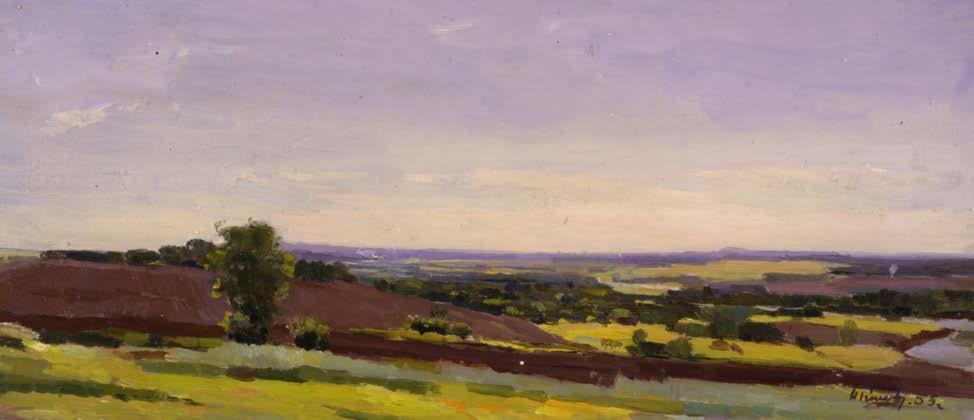
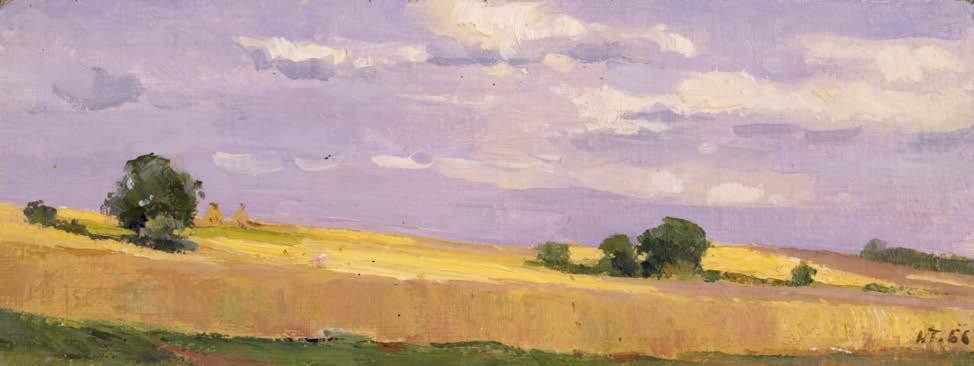

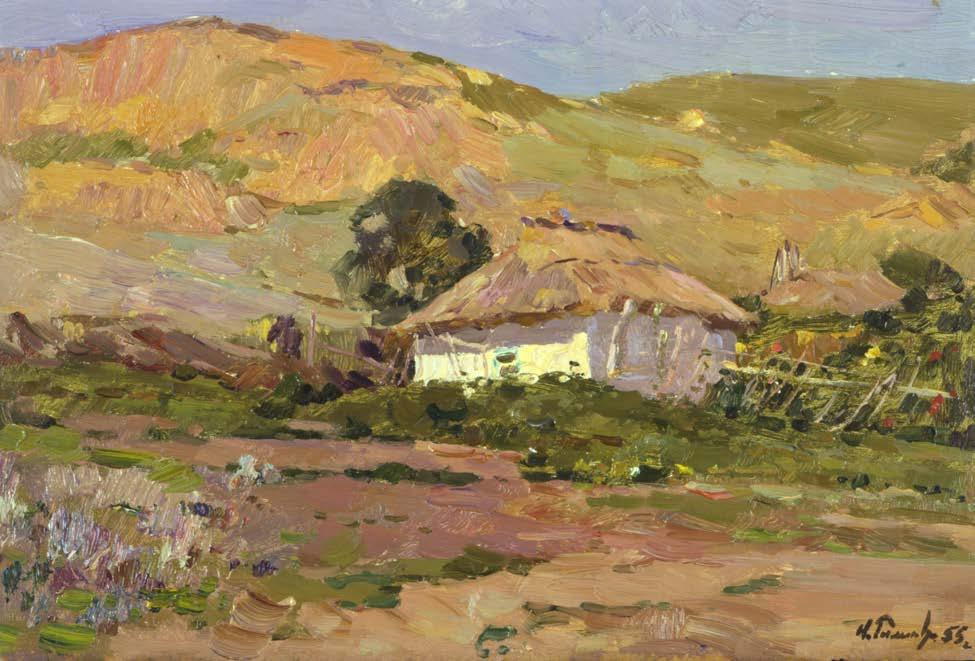
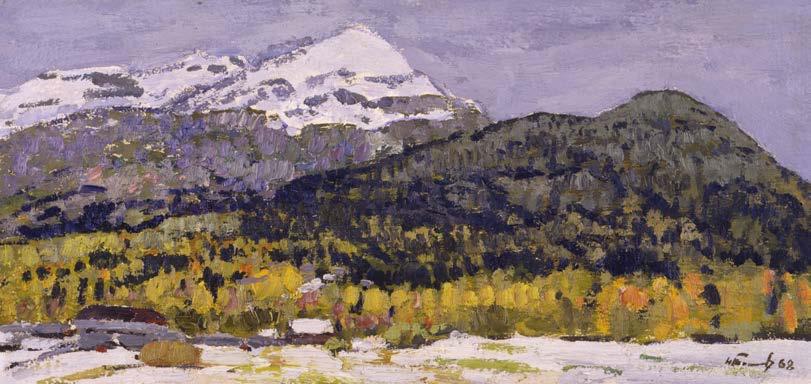
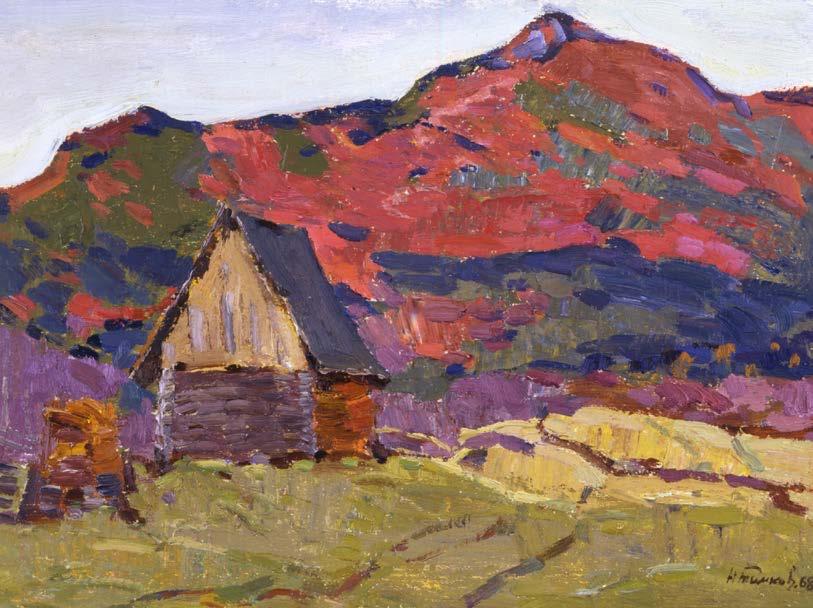 Урал зимой (Urals in Winter) Oil on Panel, 1968, 7 × 14 inches (18 cm × 35 cm)
Деревенский Урал (Rustic Urals) Oil on Panel, 1968, 10 × 13 inches (25 cm × 33 cm)
Урал зимой (Urals in Winter) Oil on Panel, 1968, 7 × 14 inches (18 cm × 35 cm)
Деревенский Урал (Rustic Urals) Oil on Panel, 1968, 10 × 13 inches (25 cm × 33 cm)
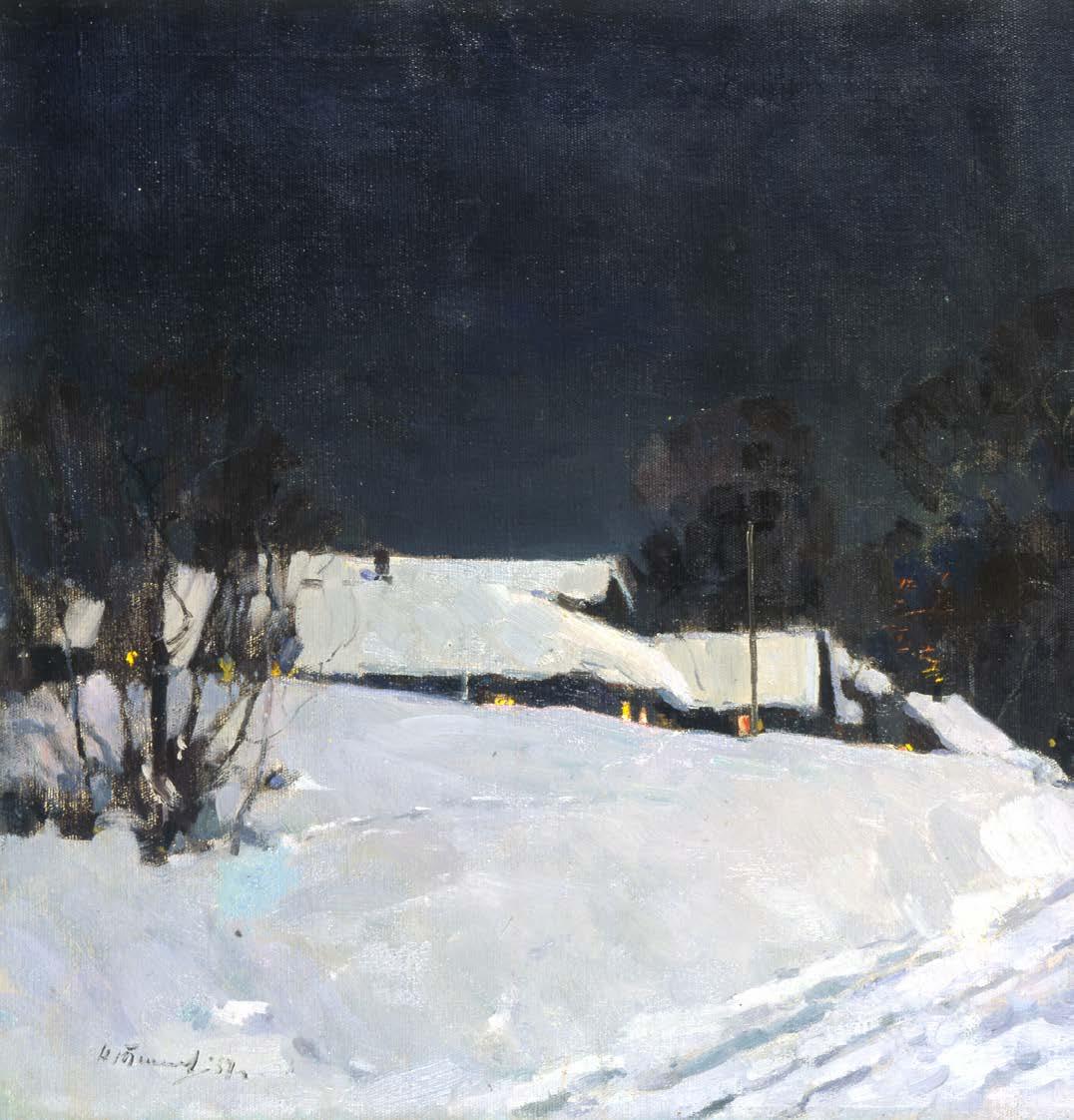
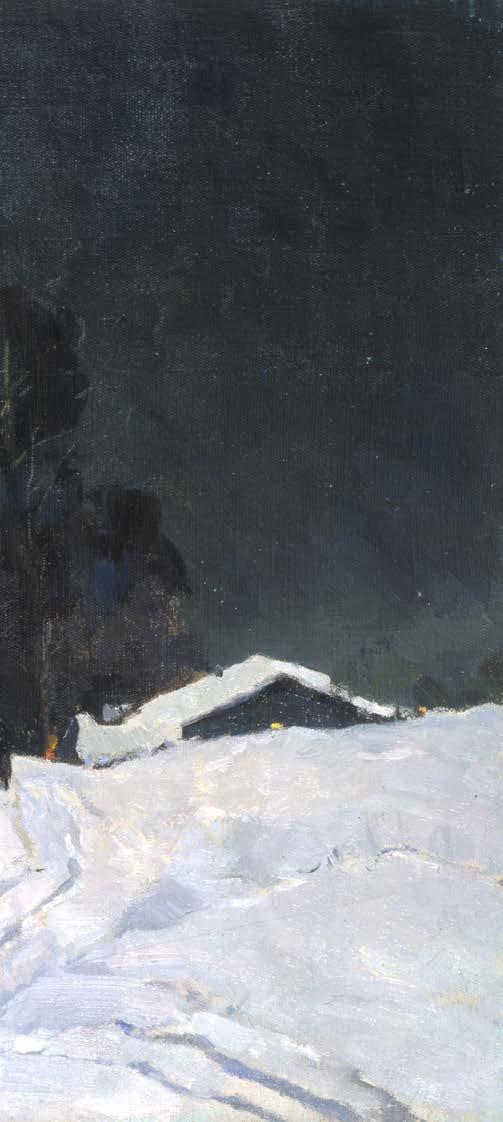
Снежная ночь (Snowy Night)
Oil on Canvas, 1957, 20 × 28 inches (50 cm × 70 cm)
Timkov quietly absorbed the best of what the world’s art, including his own country, could offer, and managed to create an individual view of the world, where everyone would be comfortable living despite the absence of any modernity in his paintings. The tranquility of his scenery is so appealing, so comfortable, that just the simple act of viewing his canvases creates a sense of relaxation.
Dr. Alexander M. Shedrinsky
Fulbright Professor
St. Petersburg Academy of Art
Солнечная дача (Sunlit Dacha)
Oil on Panel, 1961, 21 × 29 inches (53 cm × 73 cm)
For Timkov, depicting the dacha in his landscapes ties him securely to the rich, fertile earth from which he derived his strength. They are ever present, even if only a dot on the horizon. In Sunlit Dacha, he goes further, conferring a dramatic portrait like personality upon the humble structure. Utterly immersed in the painterly elements, a fauvist blow of color and a burst of emotion capture the fleeting moment of this incandescent performance.
Dr. Albert Kostenevich
Keeper of Impressionist Paintings
State Hermitage Museum, St. Petersburg
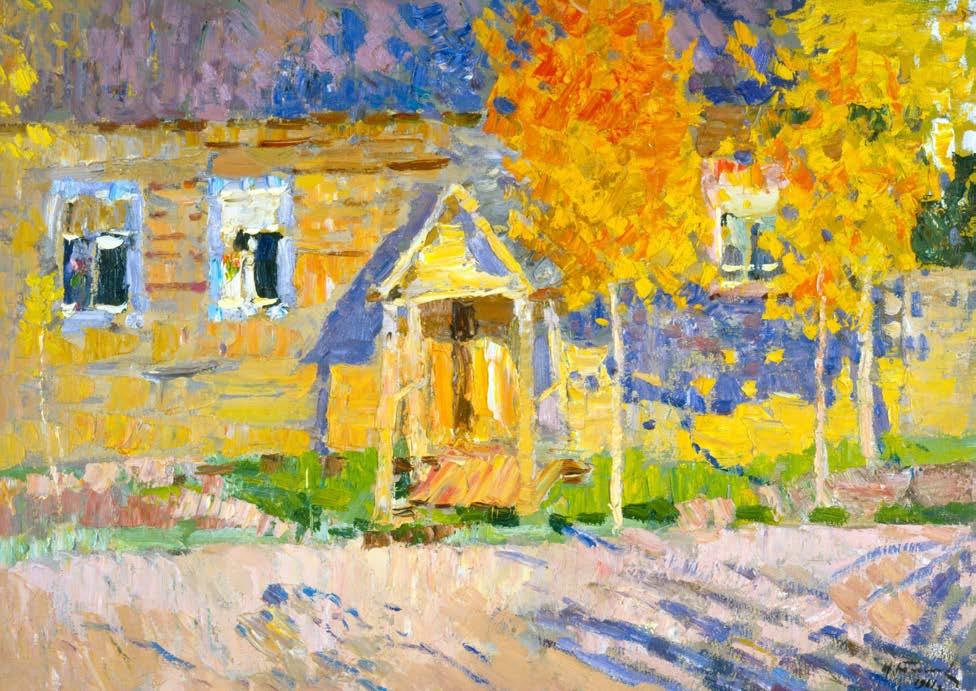
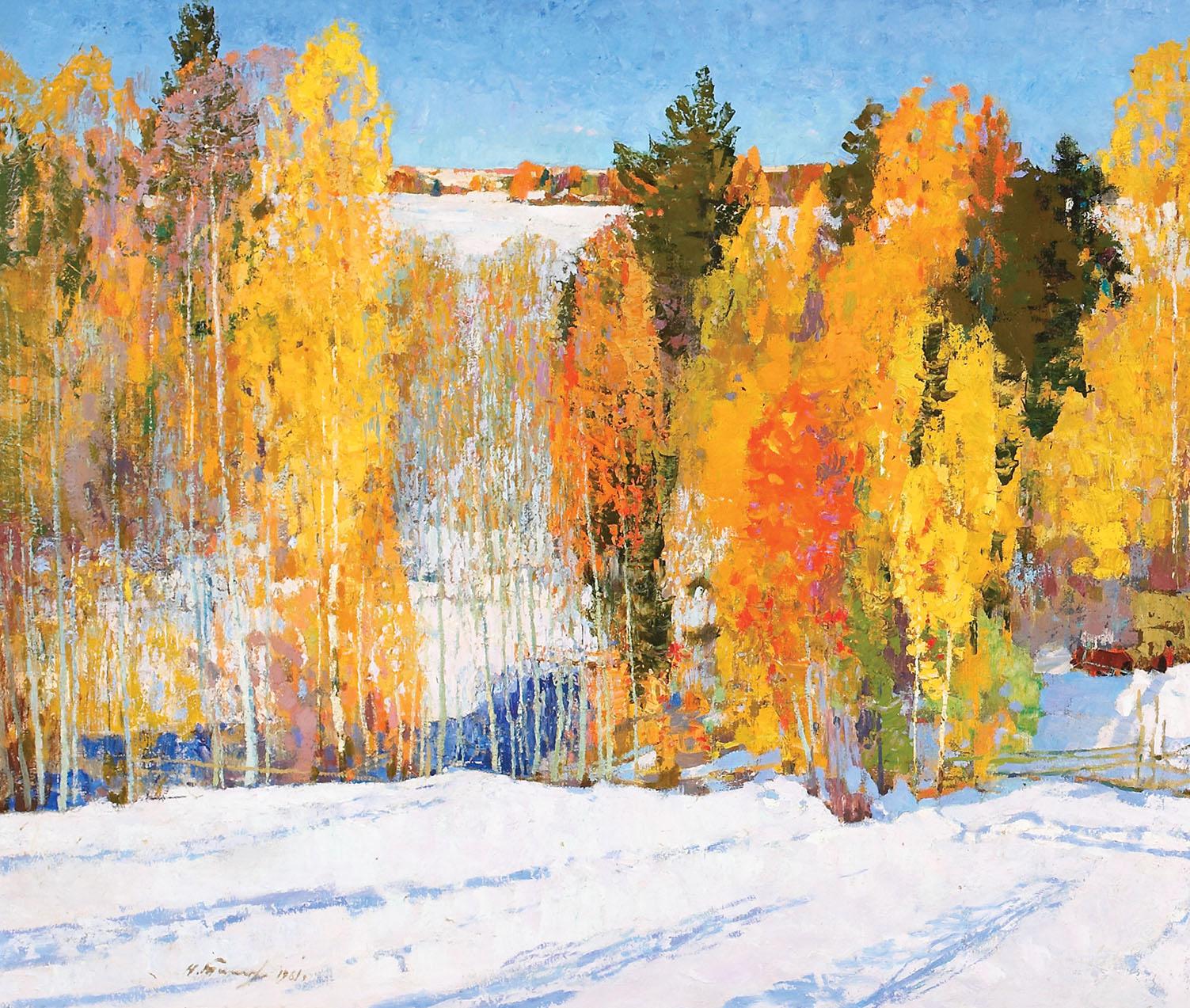
Свежий осенний день (Crisp Autumn Day)
Oil on Panel, 1961, 38 × 80 inches (96 cm × 200 cm)
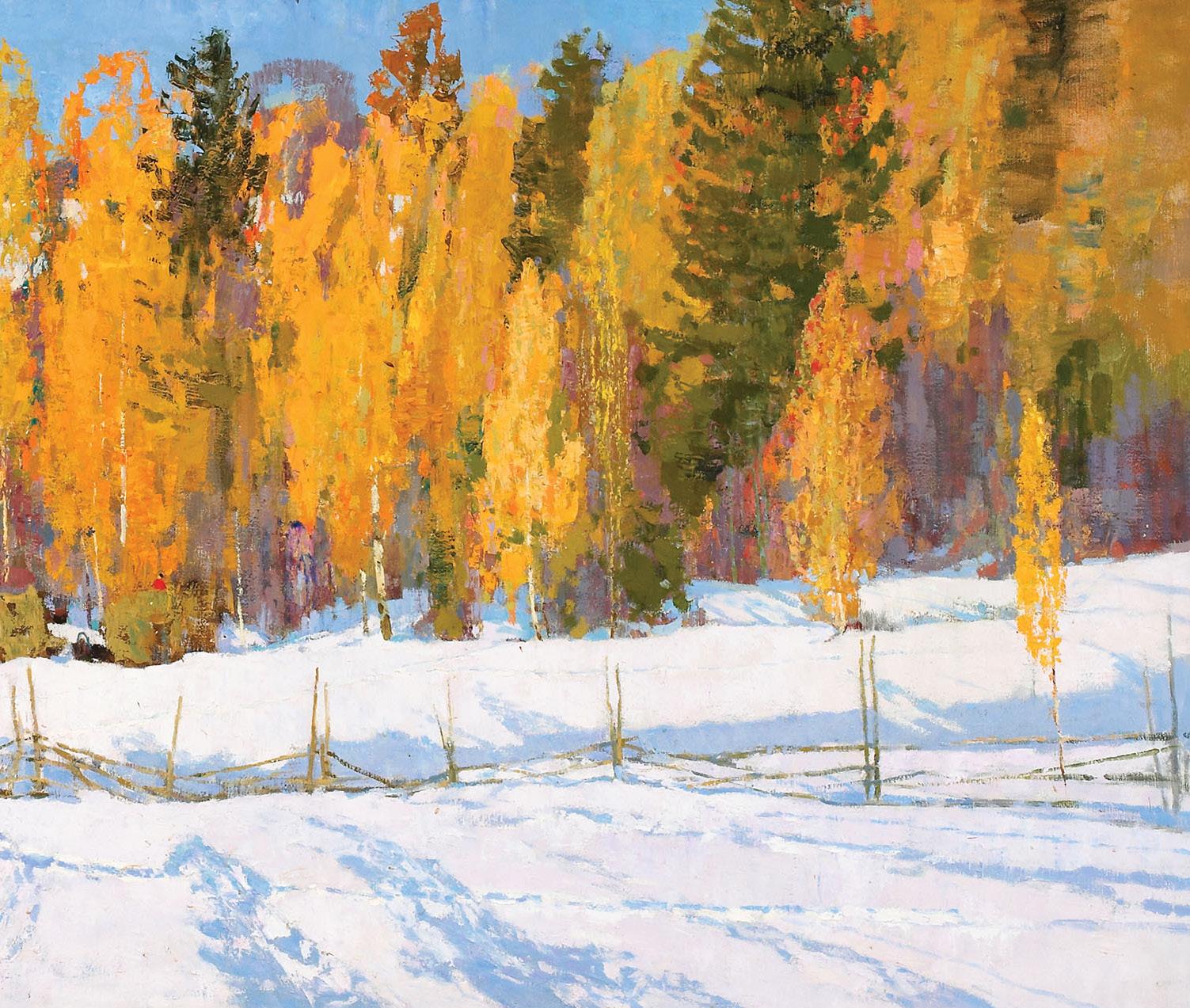
It was here that Soviet era plein air painting was born. Here was found greater tolerance towards ideological ‘neutral’ themes of domesticity, landscapes, and still lifes. The landscape was developed naturally from the rural settings of the artistic dachas. Certainly the lion of all of these creative dachas was the Akademichka Dacha, which could claim Nikolai E. Timkov as its own.
Dr. Vern G. SwansonThe Courtauld Institute of Art, London
Деревенский ручей (Rustic Creek)
Oil on Panel, 1963, 24 × 22 inches (60 cm × 56 cm)
Timkov is never an objective observer. He participated in every landscape he ever painted. The viewer can feel the artist’s presence and his changing moods in each of his canvasses. Sometimes his emotions can burst with color as in Rustic Creek. Spontaneity is conveyed by textured brushstrokes of gold, rust, fuchsia and blue. It is clear that the artist likes the open air and midday sun. This landscape practically quivers with virile color, and invites the viewer to share the artist’s joy.
Dr. Alexander M. Shedrinsky
Fulbright Professor
St. Petersburg Academy of Art
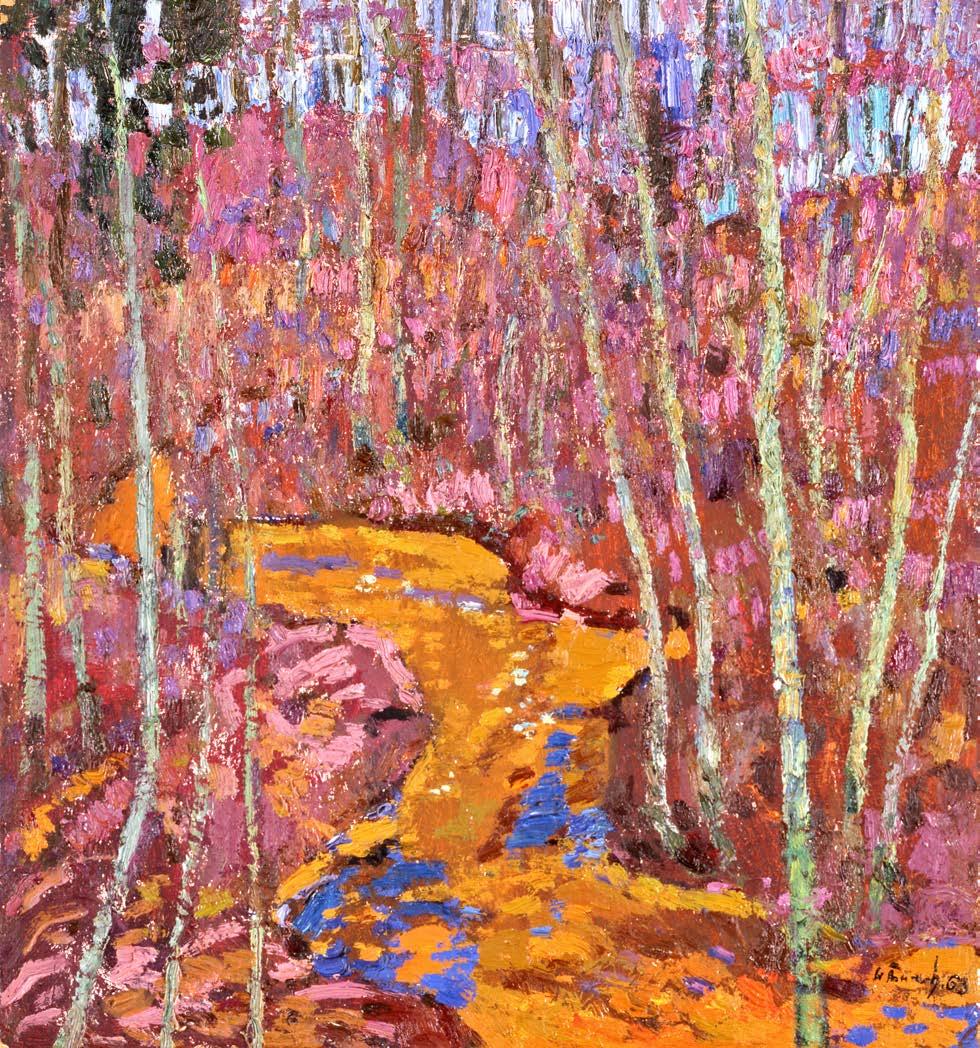
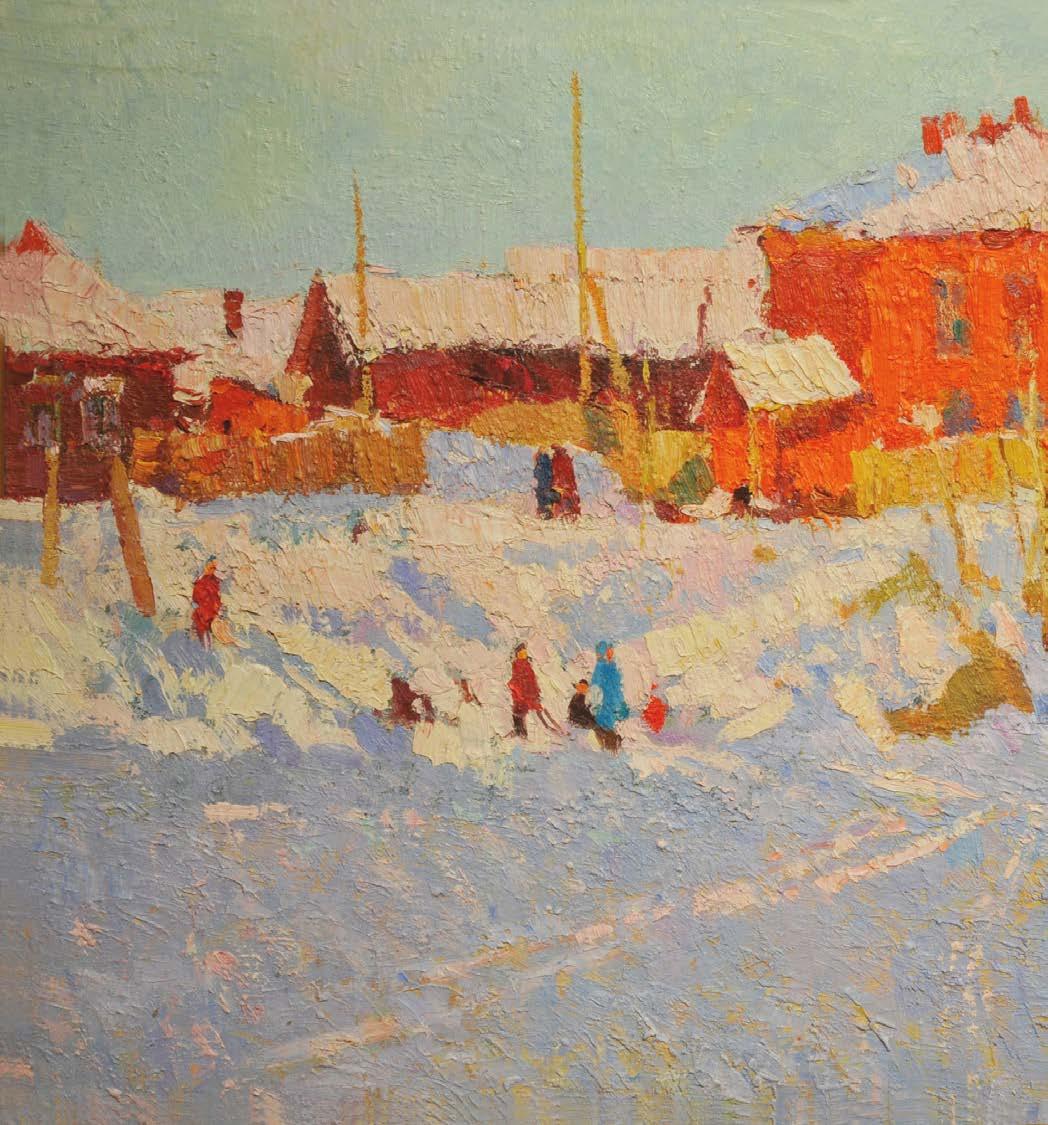

Красный дом (Red House)
Oil on Panel, 1964, 20 × 29 inches (50 cm × 73 cm)
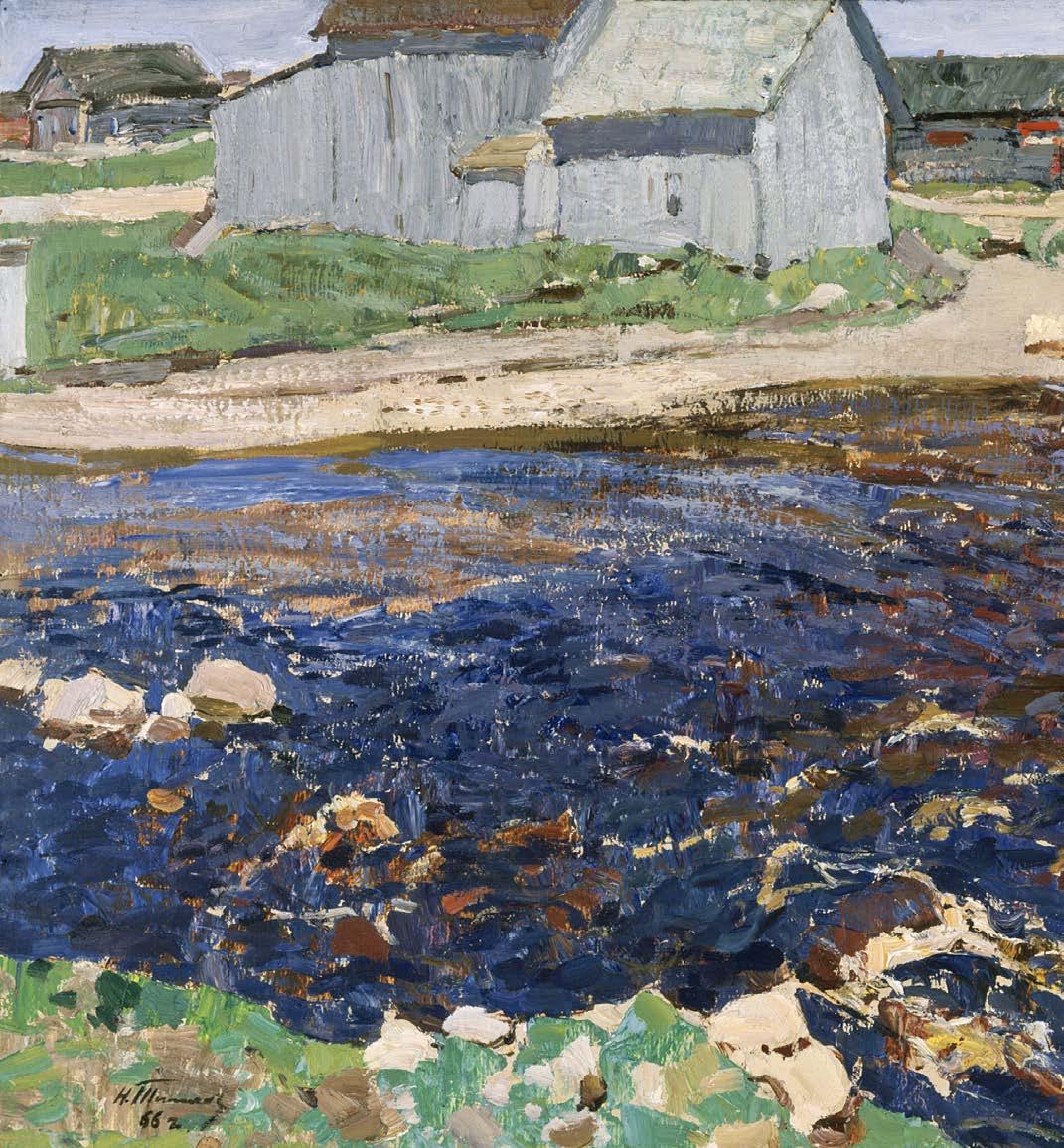
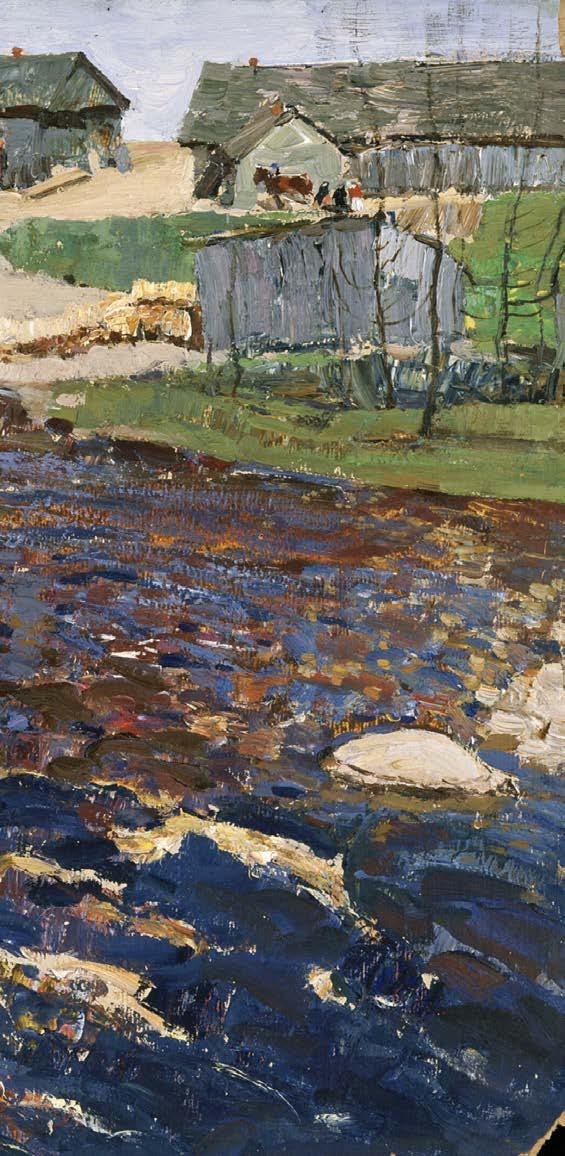
Переправа через реку (The Crossing)
Oil on Panel, 1966, 19.5 × 27.5 inches (49 cm × 69 cm)
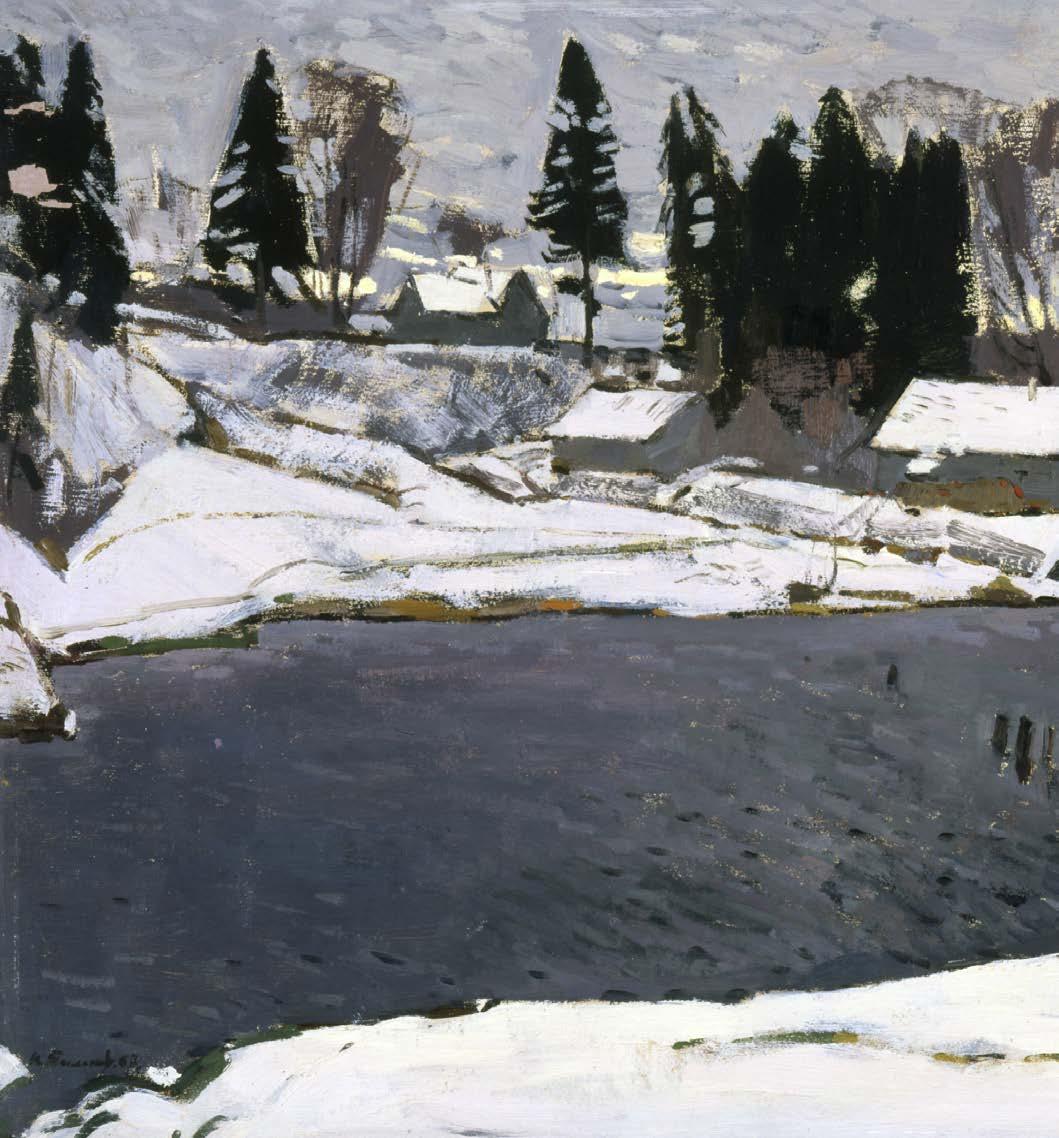
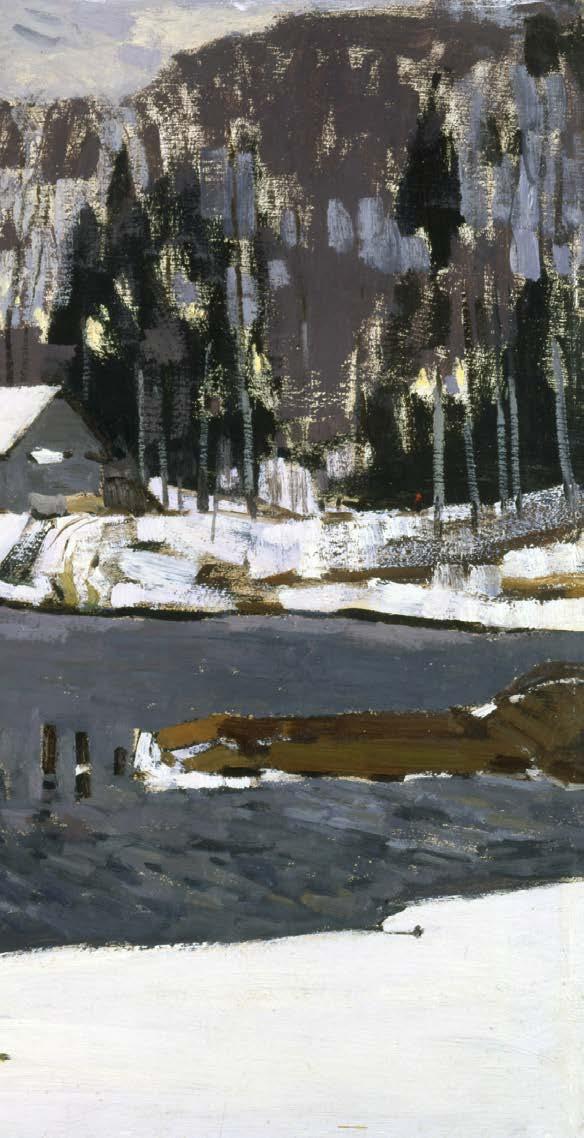
Ноябрьские воды (November Waters)
Oil on Panel, 1967, 20 × 29 inches (50 cm × 73 cm)
One should paint with good sense, not for effects or beautiful brush strokes, but for a deep and sincere expression of human feelings. Art is not just a profession, it is the highest duty of an artist, of a human being. Never try to deceive nature, but approach it with all love of which you are capable, as only then will it open its soul to you.
Mikhail Nesterov (1862 –1942)
Renowned Russian Painter and Mentor of Nikolai Timkov
Бабье лето (Indian Summer)
Oil on Panel, 1969, 21 × 29 inches (53 cm × 73 cm)
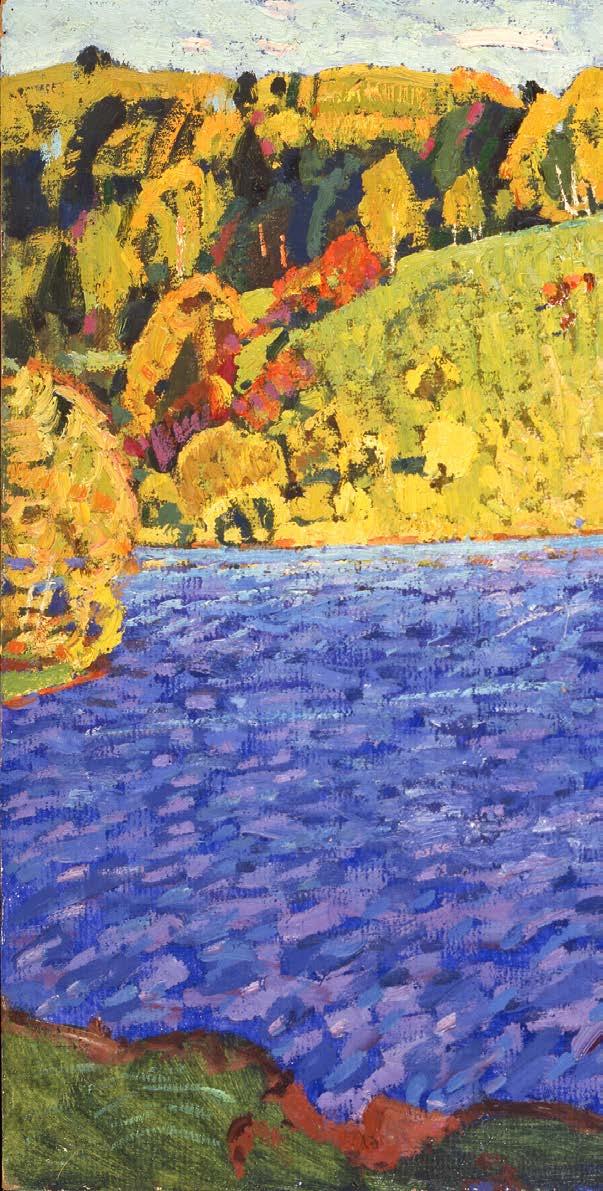
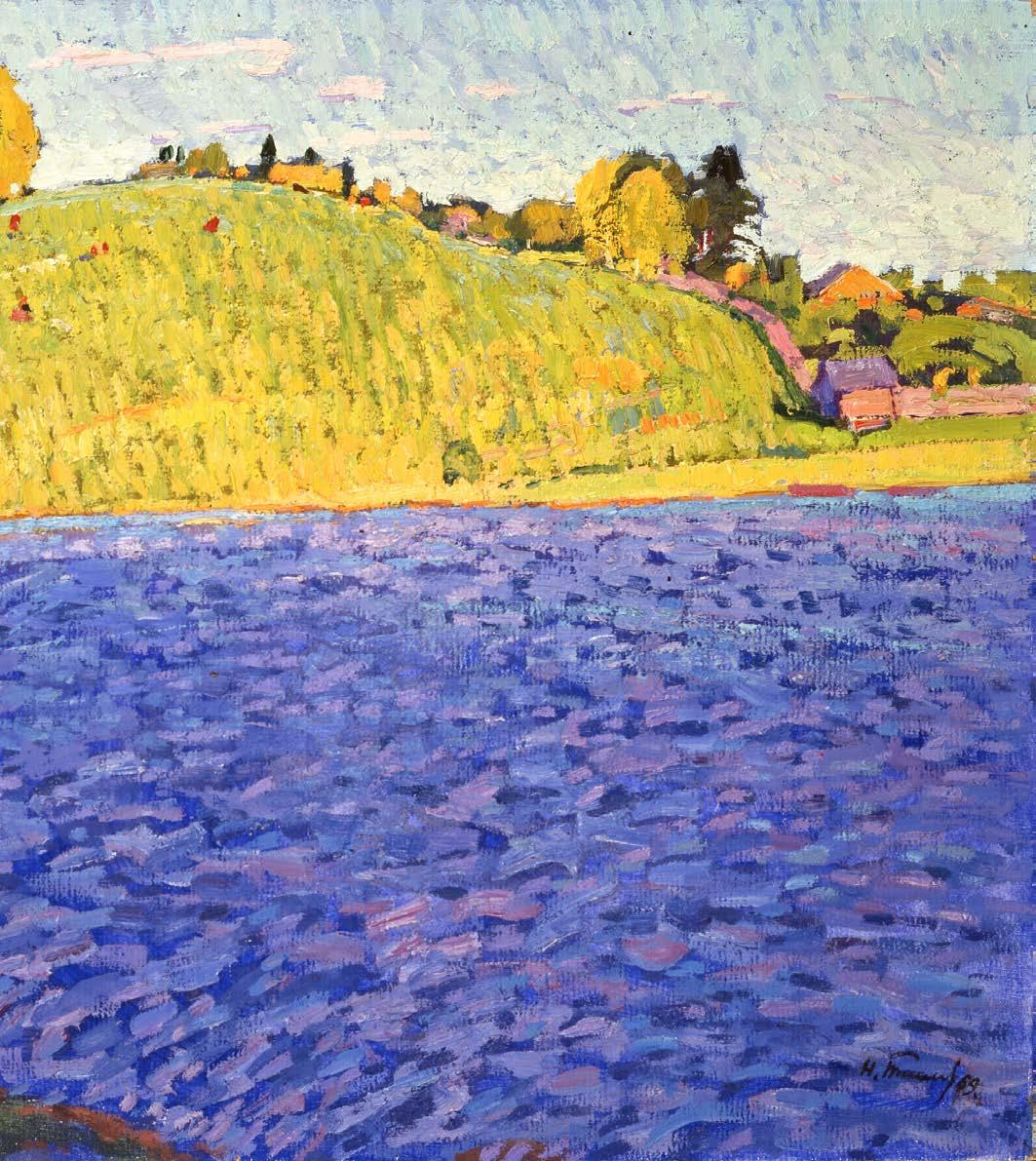
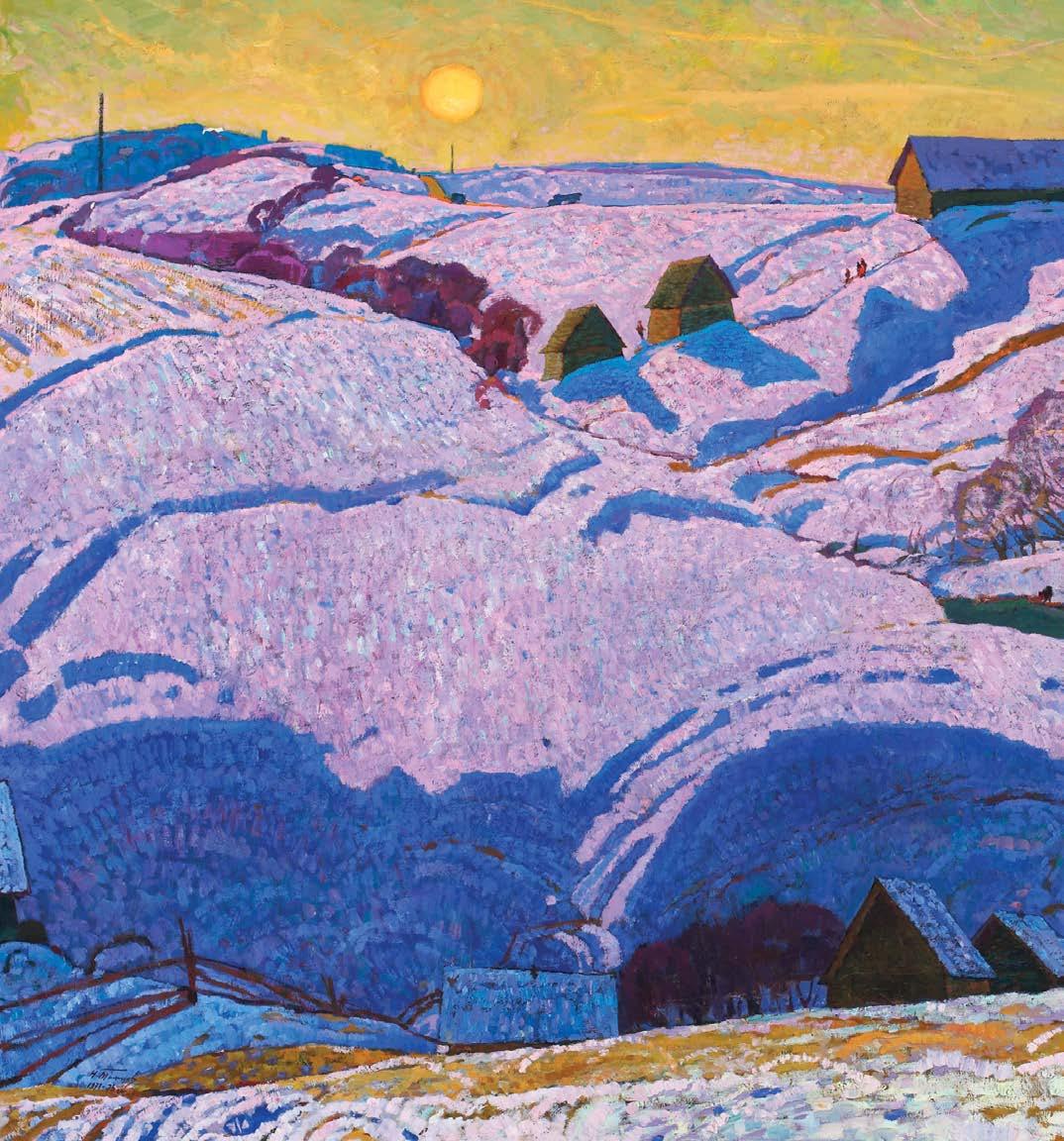
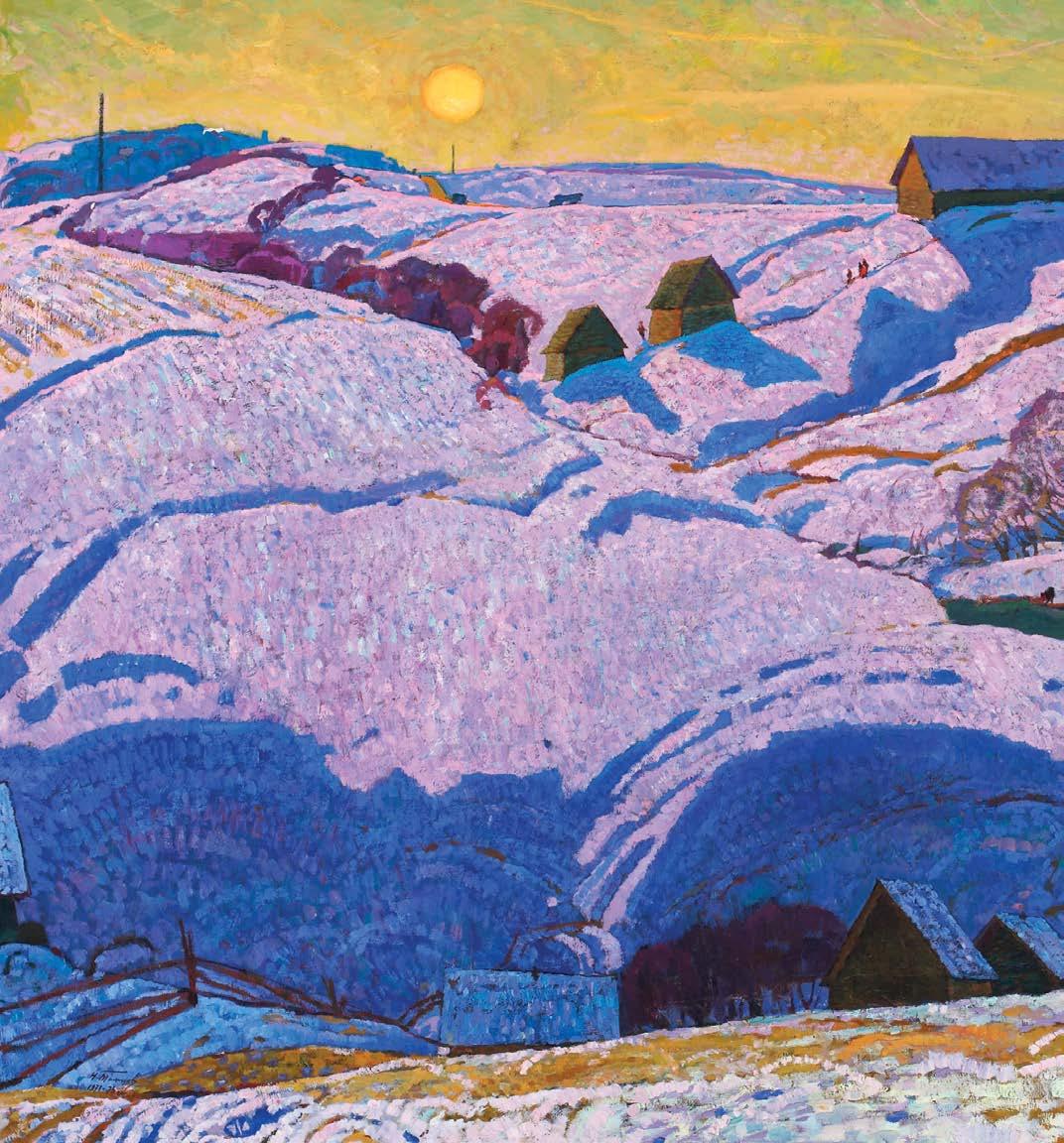
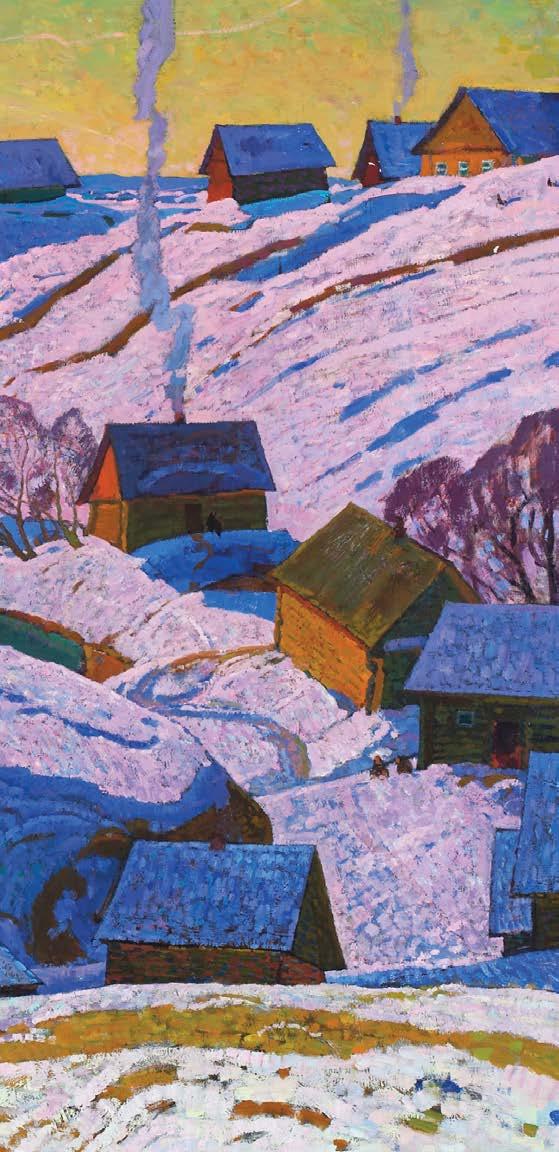
NIKOLAI TIMKOV
Золотое солнце зимы (Winter’s Golden Sun) Oil on Canvas, 1971, 59 × 81inches (148 cm × 204 cm)
Timkov’s landscapes radiate powerful emotions, moving us to wonder not only about the shifting beauty of the earth, but our place upon it. They are distinguished by dynamic compositions, the laconic layering of color, and, always, by the exquisite balance of detail and ornamentation.
Nina A. Dmitriyeva
Preeminent Art Historian The Pushkin State Museum of Fine Arts, Moscow
Усадьба (Farmstead)
Oil on Canvas, 1972, 42 × 56 inches (105 cm × 140 cm)
Timkov sought to re-visualize nature freshly, with more spontaneity. Using faux color and textured impasto to establish forms, he conveys a vivid impression of something actually seen or felt in nature.
Nina A. Dmitriyeva
Preeminent Art Historian
The Pushkin State Museum of Fine Arts, Moscow
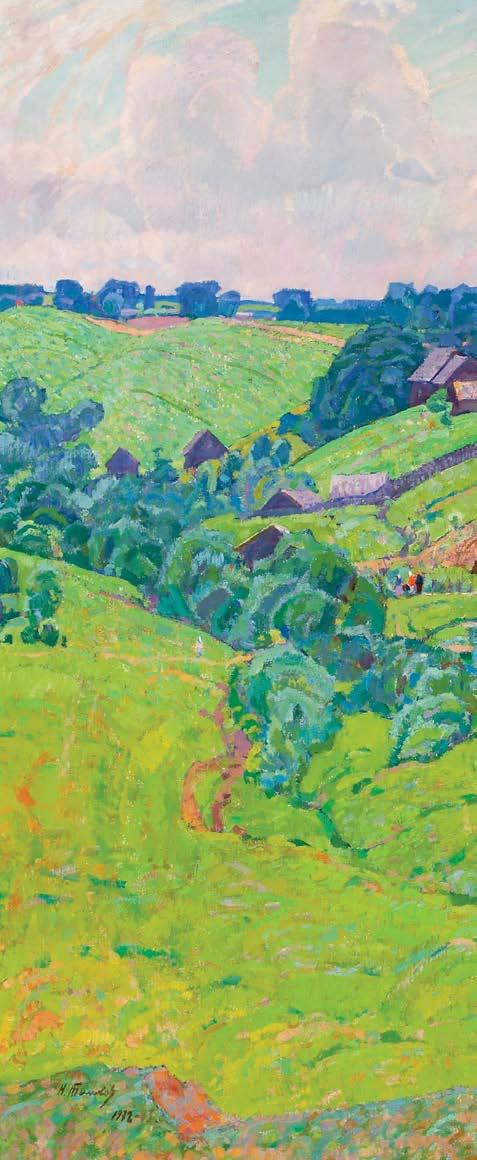
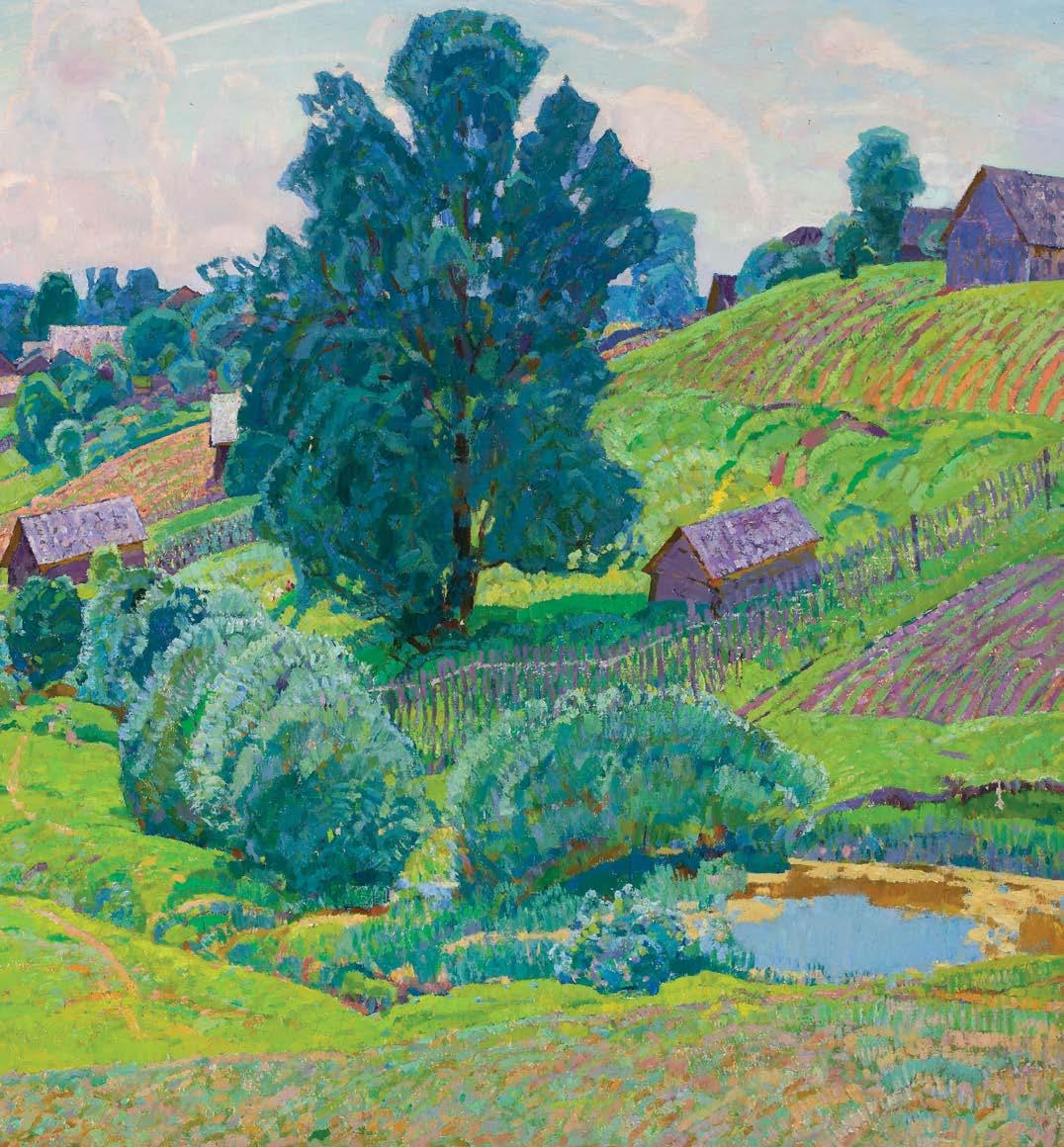
Утреннее отражение (Morning Reflection)
Oil on Panel, 1975, 20 × 24 inches (50 cm × 60 cm)
...and what luminescence of the paint layer: it literally tugged at one’s heart. Nikolai Efimovich shared with me the secrets of how he achieved that effect.”
Rozalia Rozina
Artist and faithful friend and student of Timkov, recollections from the Akademicheskaya Dacha
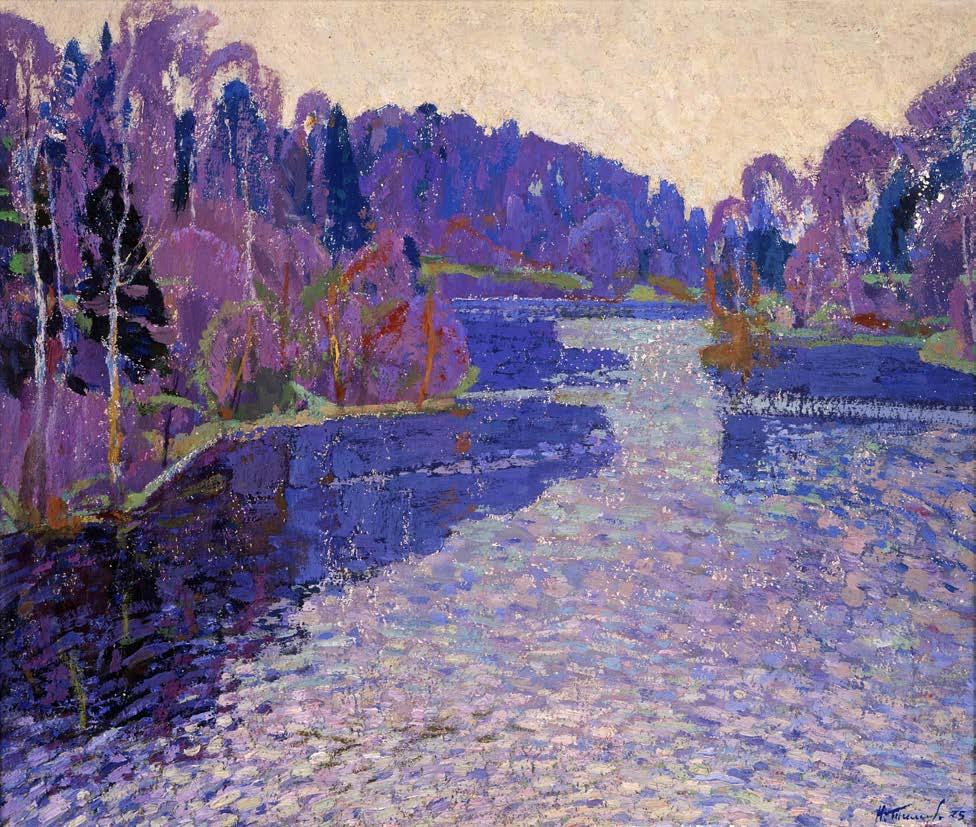
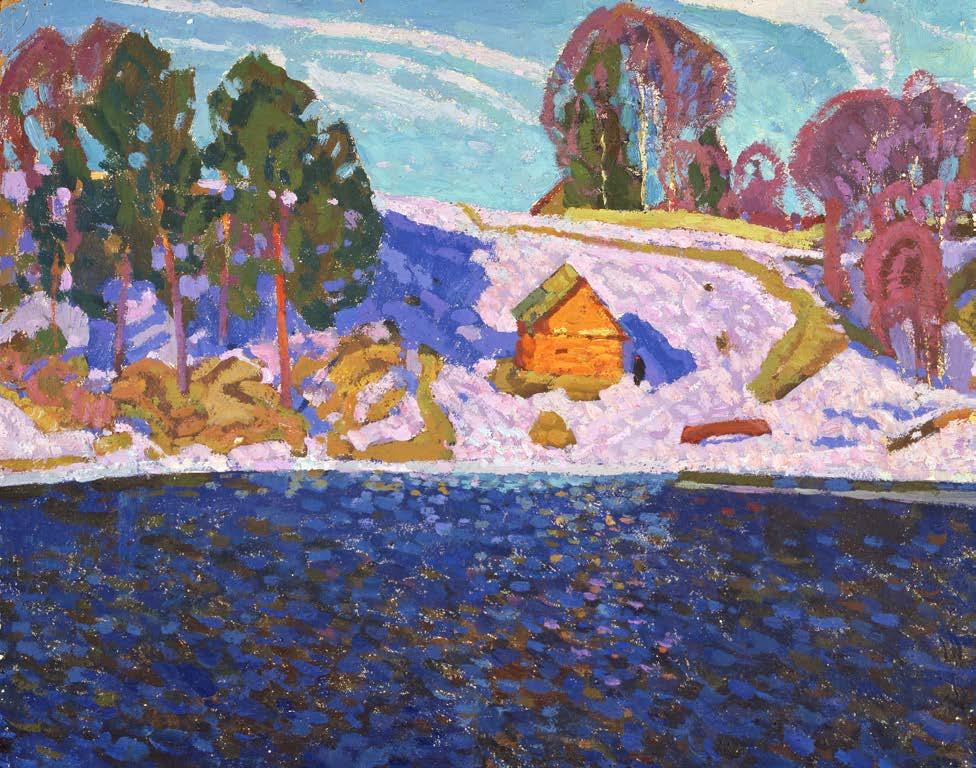
NIKOLAI TIMKOV: MASTER RUSSIAN IMPRESSIONIST
Озеро Мстино (Lake Mstino)
Oil on Panel, 1975, 24 × 30 inches (60 cm × 75 cm)

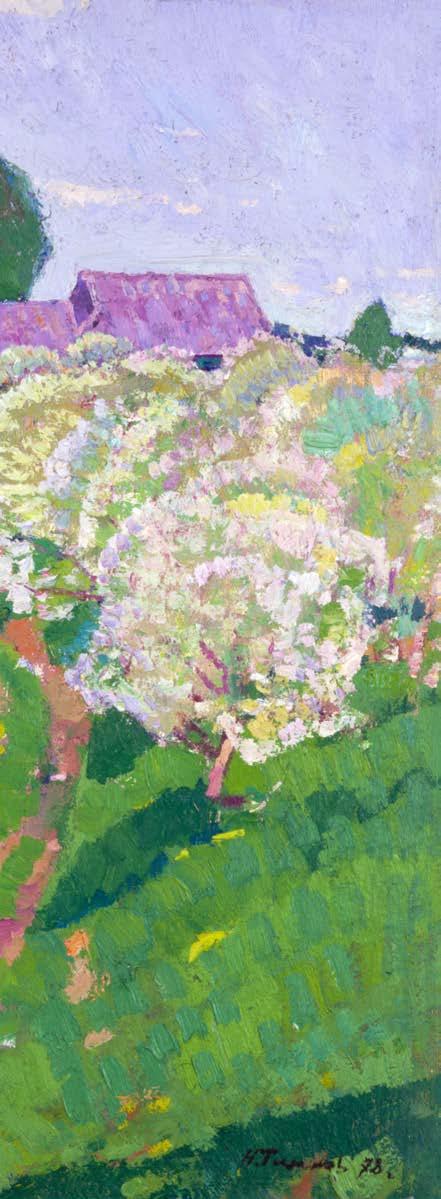
Цветущий яблоневый сад (Flowering Apple Orchard)
Oil on Panel, 1978, 20 × 24 inches (50 cm × 60 cm)
As I entered the room it was as if I had walked into a sunlit meadow. The paints streamed and gleamed and overflowed. There were no subjects in particular: just the edge of some village, little houses, apple trees, banks of snow. But how much joy they threw out, how fine and resonant the color sounded, each moment without repetition.
Rozalia Rozina
Artist and faithful friend and student of Timkov, upon visiting Timkov’s exhibition at the Central Exhibition Hall in Moscow, 1970
Женская голова (Female Head)
Oil on Panel, 1976, 20 × 16 inches (50 cm × 40 cm)
The dream state is transitional, borderline, uniting both shores of life. Images representing this state might be purely abstract, or retain some sense of the depiction of the figure, and accumulations of inner tensions and emotional experiences.
Dr. Alexander Borovsky Chief Curator of Contemporary Art State Russian Museum, St. Petersburg
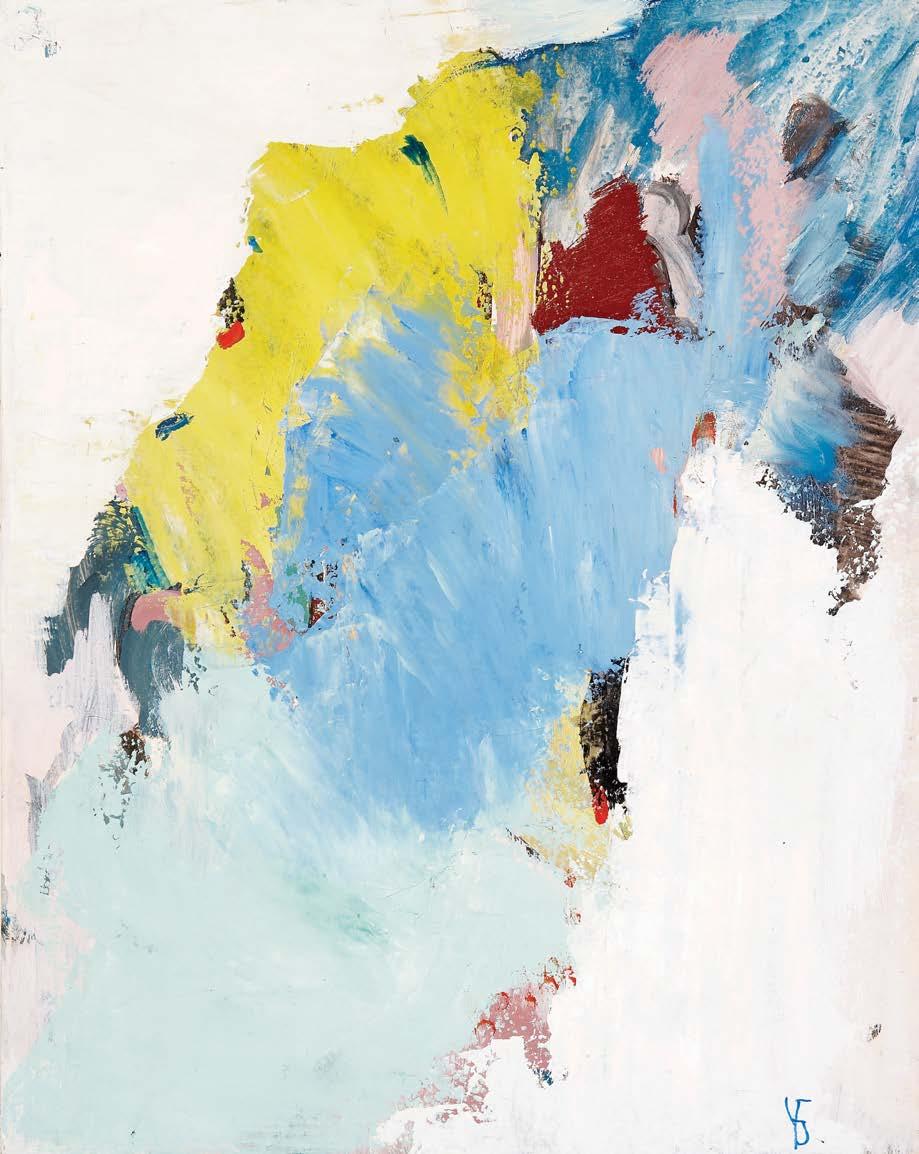
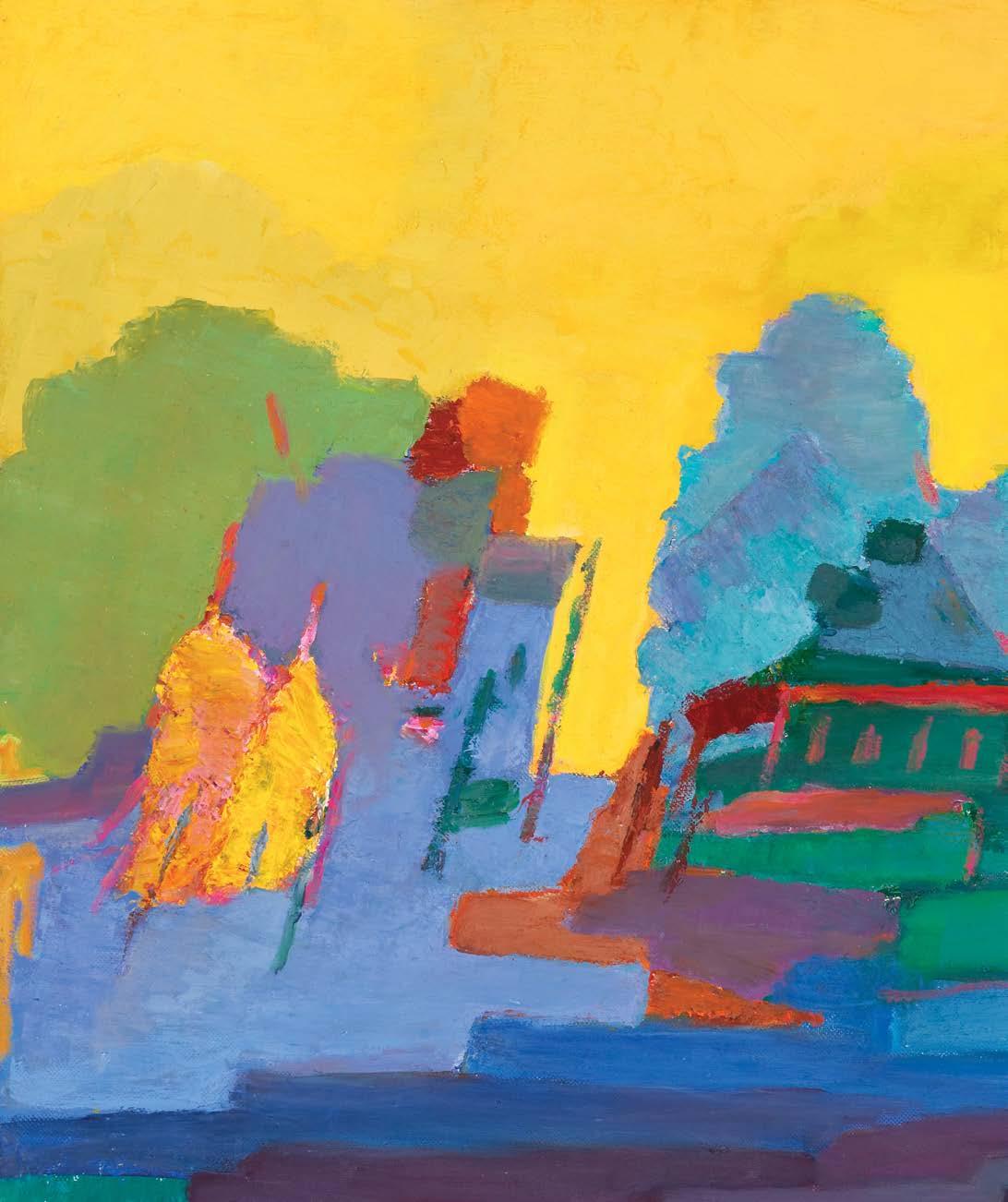

Староладожский туман (Staraya Ladoga Fog)
Acrylic on Canvas, 2002, 28 × 31inches (70 cm × 78 cm)
In the later years of his life Chetkov spent a great deal of time at his dacha nearby the ancient village of Staraya Ladoga. There he painted many iterations of the surrounding environs. These landscape paintings show Chetkov’s attention to mood with an emotional and lyrical intensity. Many of the views were executed in one sitting, recreating the atmosphere of real geographical places through experimentation with color and form.
Dr. Alexander Borovsky
Chief Curator of Contemporary Art State Russian Museum, St. Petersburg
Ладожский пейзаж (Ladoga Landscape)
Acrylic on Panel, 1979, 16 × 20 inches (40 cm × 50 cm)
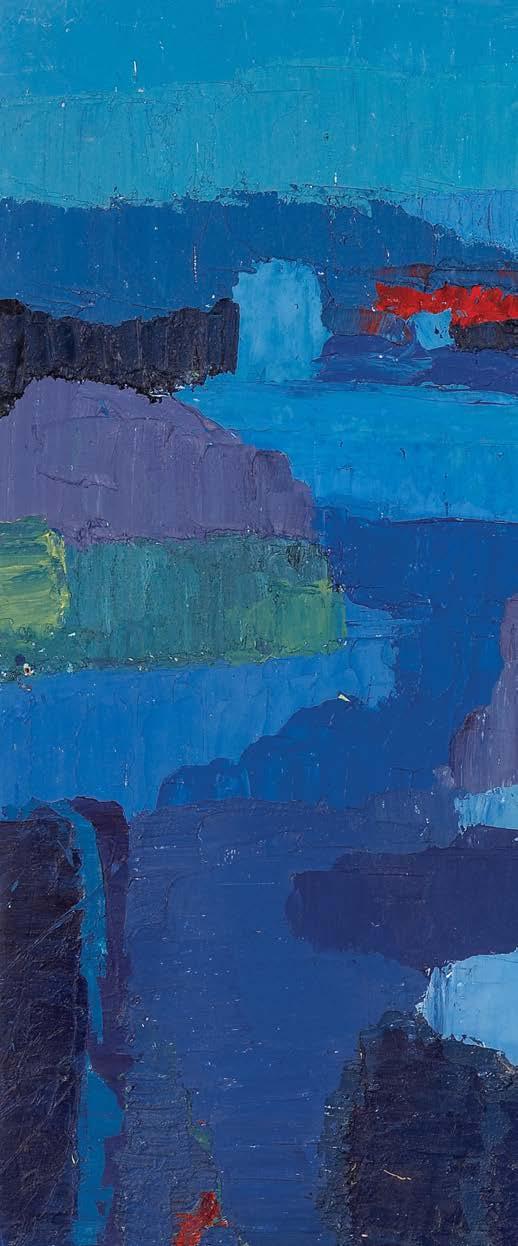
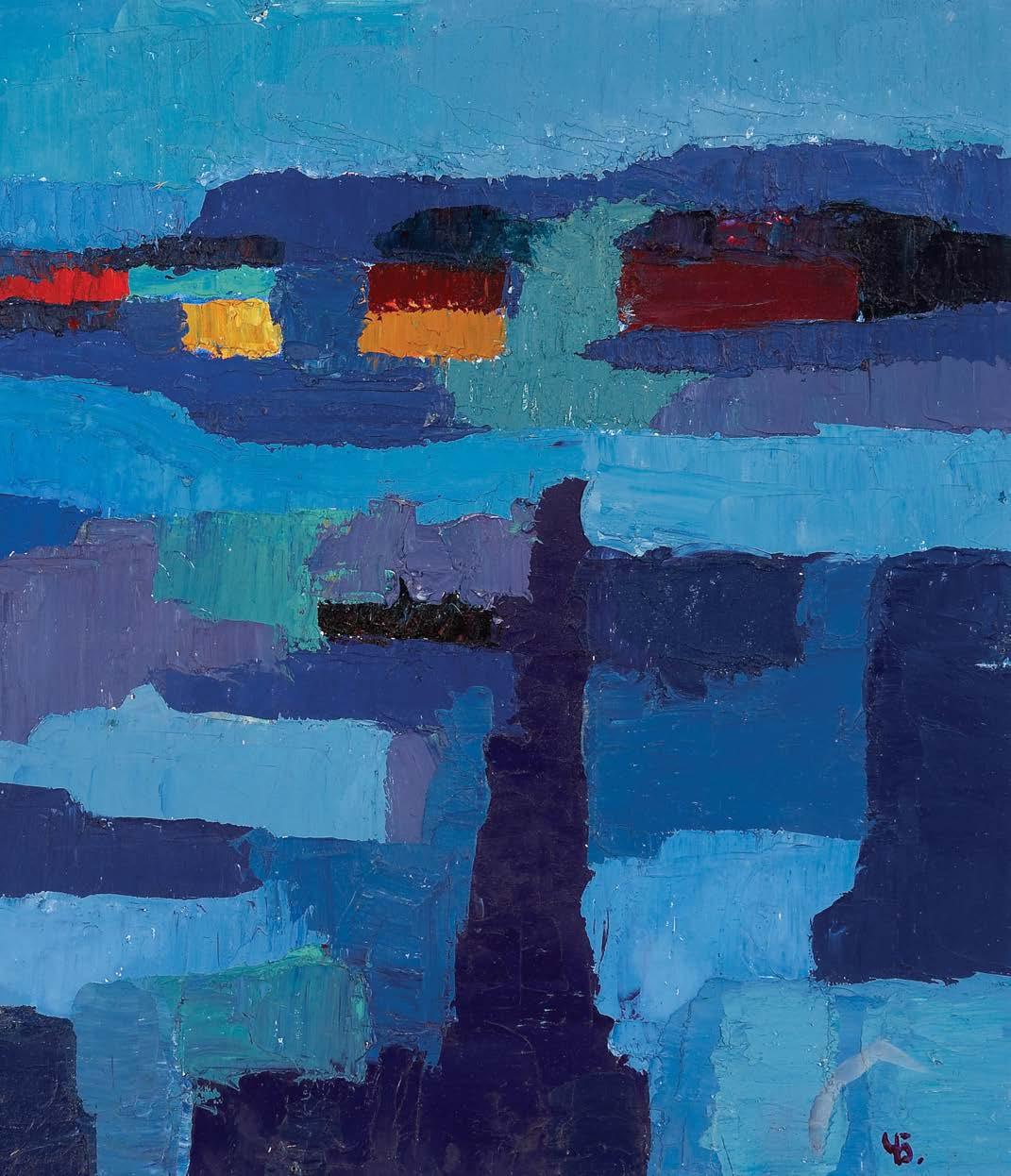
Африканец (African)
Acrylic on Canvas, 1985, 26 × 20 inches (65 cm × 50 cm)
Such tempo, such reactivity of the portrait painting reveals the impulse of penetration into the sitter’s character, and provokes a viewer’s reaction to this call from a human individuality: search for contact, the spark of understanding.
Dr. Alexander Borovsky Chief Curator of Contemporary Art
State Russian Museum, St.Petersburg
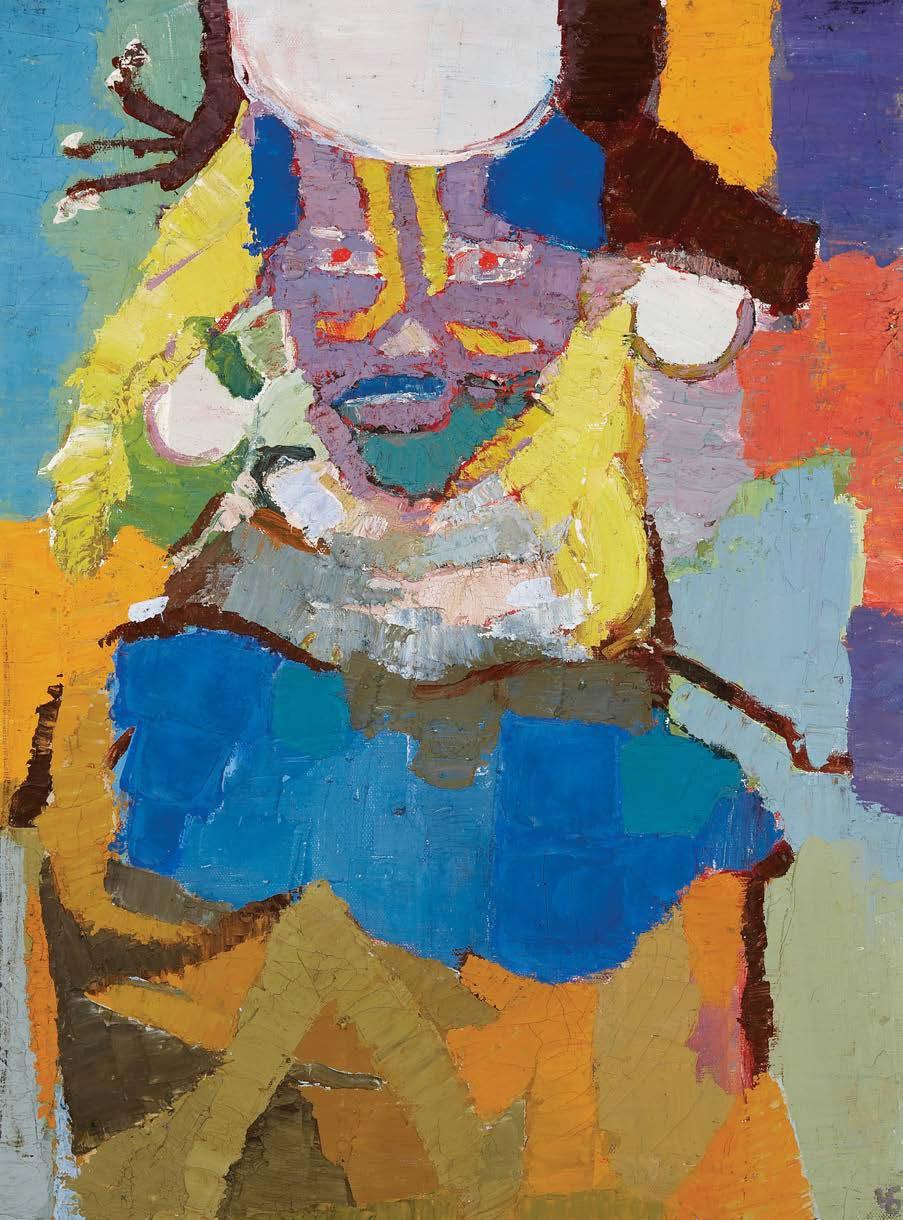
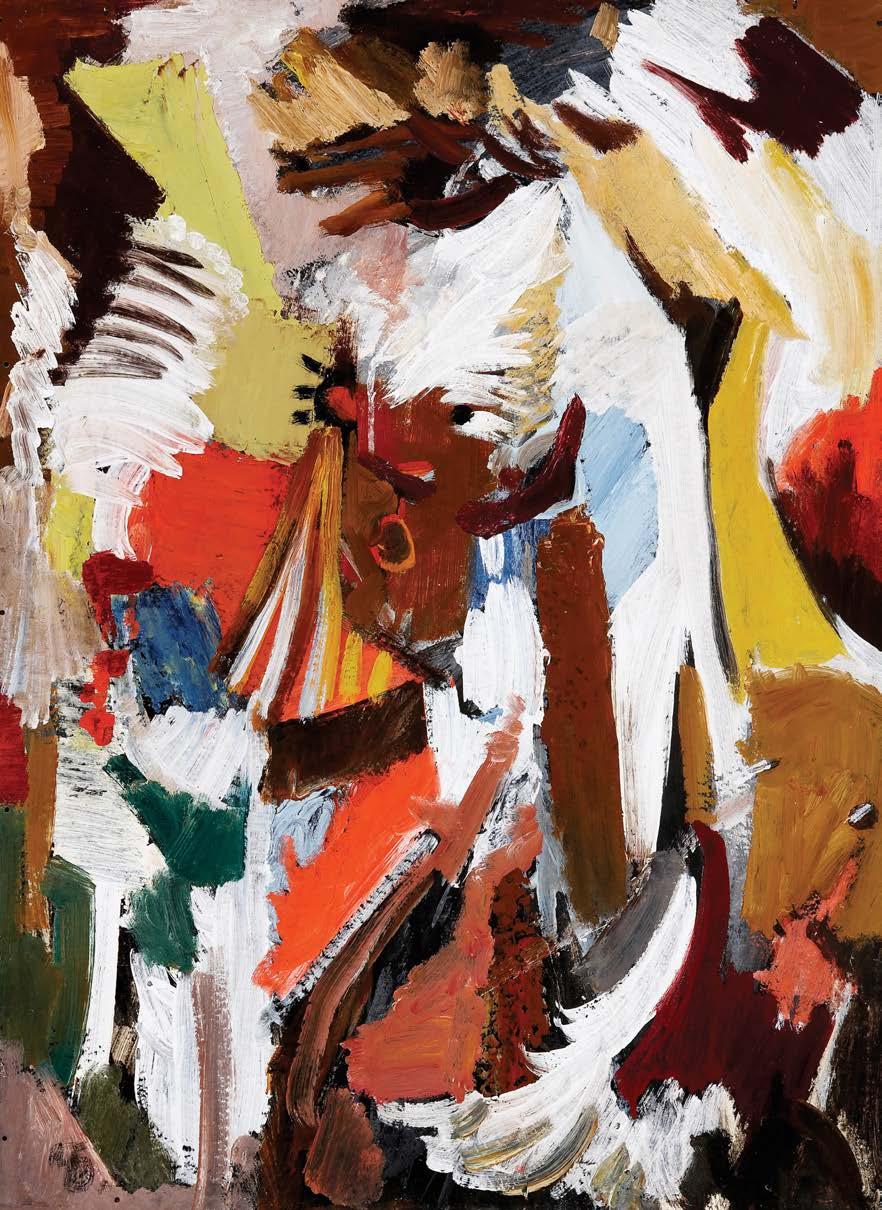
Певица поёт (The Singer Singing)
Acrylic on Panel, 1987, 26 × 20 inches (65 cm × 50 cm)
Chetkov’s portraits can be grouped according to “temperature.” They deal above all with psycho-types, with the psyche as dynamic process. The painting literally sparks forth from this process. The viewer too receives this energy of contact, provoking a reaction, the spark of understanding. Such an approach predetermines the nature of the portrait painting, what might be called its reactivity. The need for just such simultaneous painting, just such action, just such tempo is sensed by the viewer.
Dr. Alexander Borovsky Chief Curator of ContemporaryArt
StateRussian Museum, St. Petersburg
Театр (Theatre)
Acrylic on Canvas, 1987, 27 × 35 inches (68 cm × 88 cm)
There are hints at images of musical instruments and performers within the complex color-rhythmic fabric of the canvas.
Dr. Alexander Borovsky
Chief Curator of Contemporary Art State Russian Museum, St. Petersburg
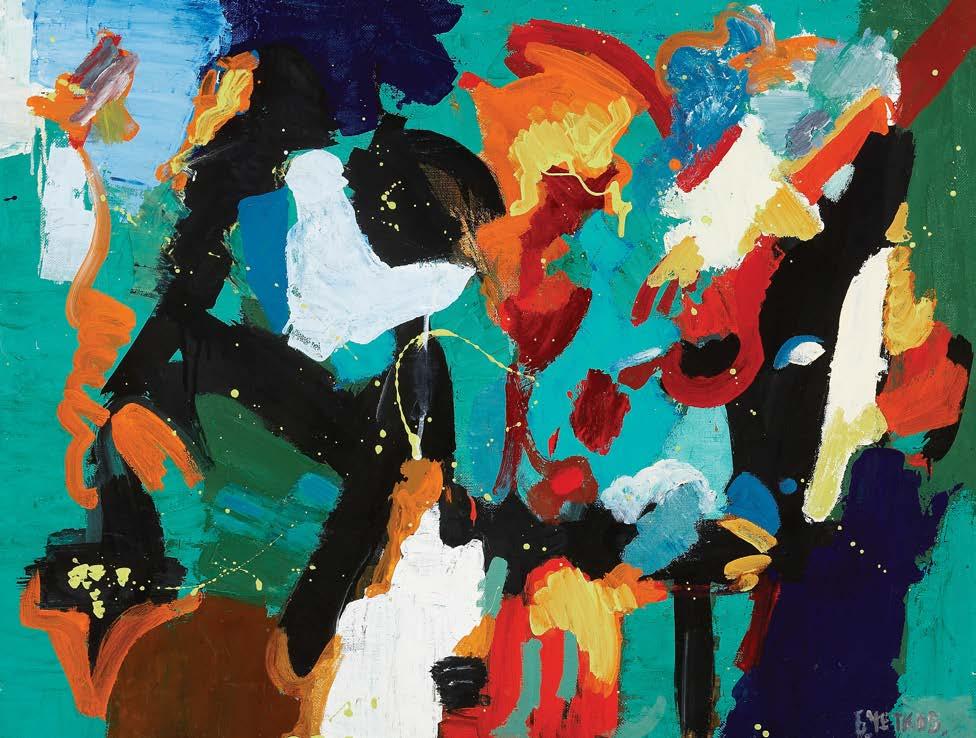
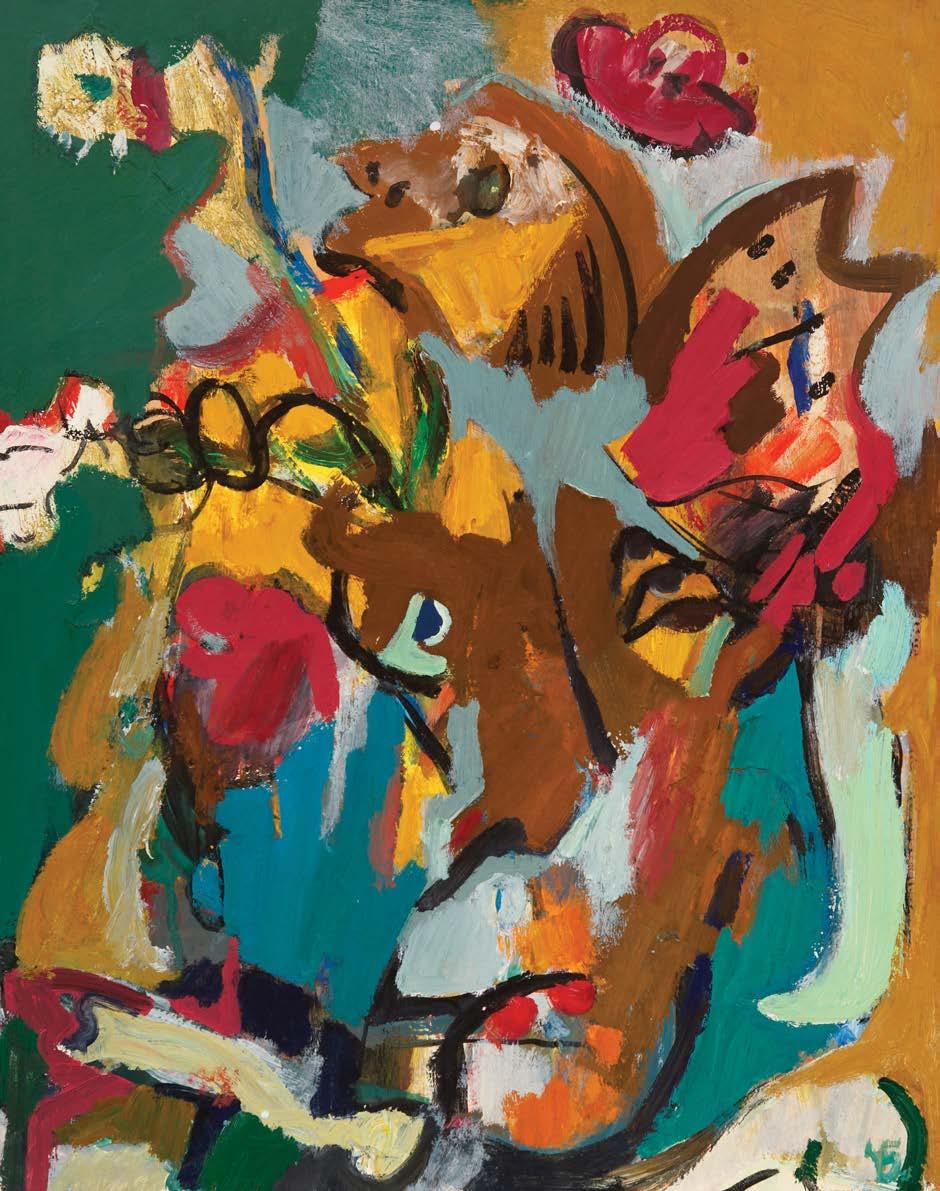
Мужской портрет с цветами (Male Portrait with Flowers)
Oil on Panel, 1987, 20 × 16 inches (50 cm × 40 cm)
The dream state is transitional, borderline, uniting both shores of life. Images representing this state might be purely abstract, or retain some sense of the depiction of the figure, revealing accumulations of inner tensions and emotional experiences.
Dr. Alexander Borovsky
Chief Curator of Contemporary Art State Russian Museum, St. Petersburg
Женщина в колеснице (Woman in a Chariot )
Acrylic on Canvas, 1998, 24 × 28 inches (60 cm × 70 cm)
Chetkov’s works pour out in a passionate, powerful and inspired stream! Biblical stories, classical myths and mysteries, metamorphoses of the totalitarian and individualist consciousness and the basic archetypes of civilization all find color, form and emotion upon his canvas.
Dr. Alexander Borovsky
Chief Curator of Contemporary Art State Russian Museum, St. Petersburg

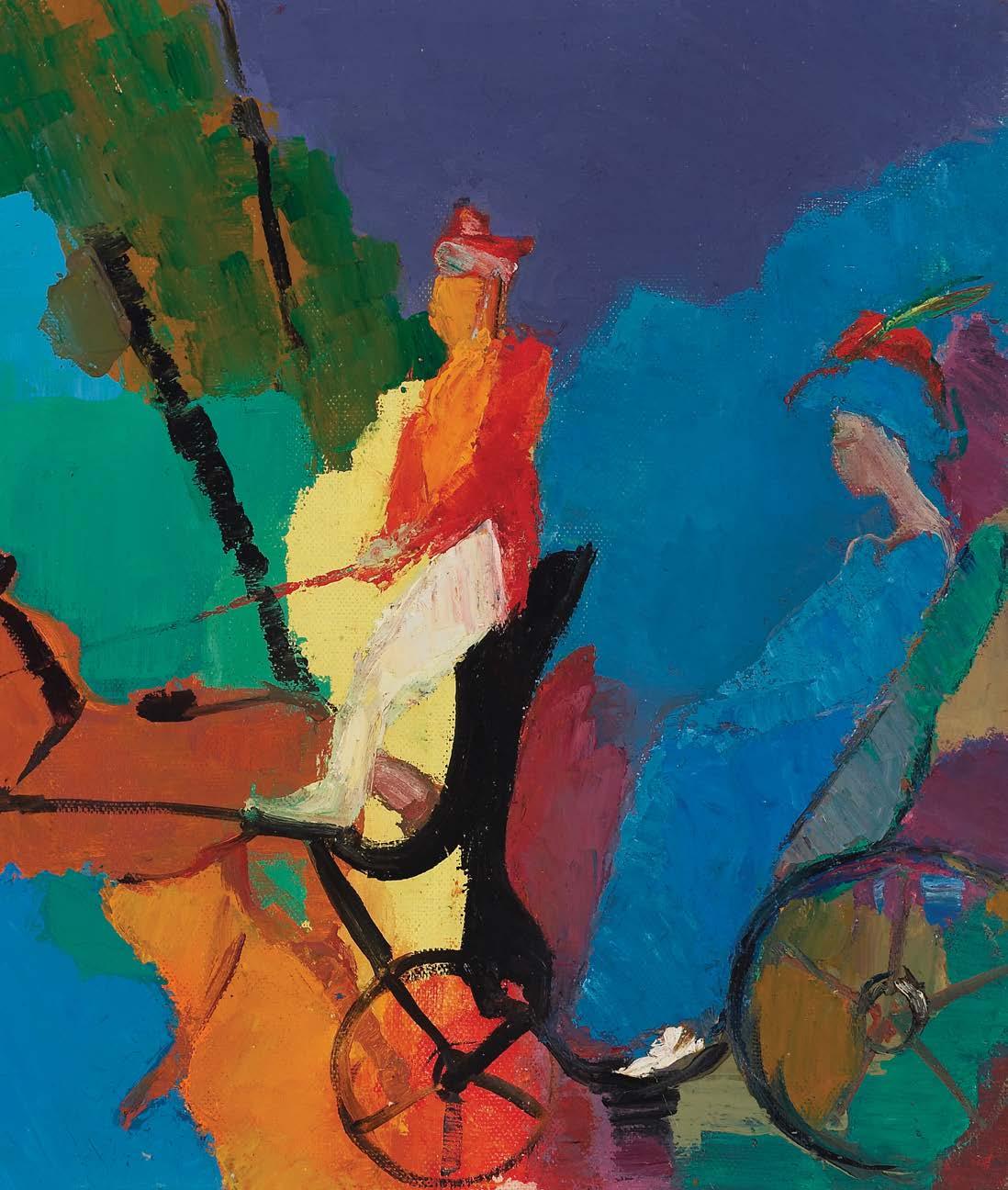
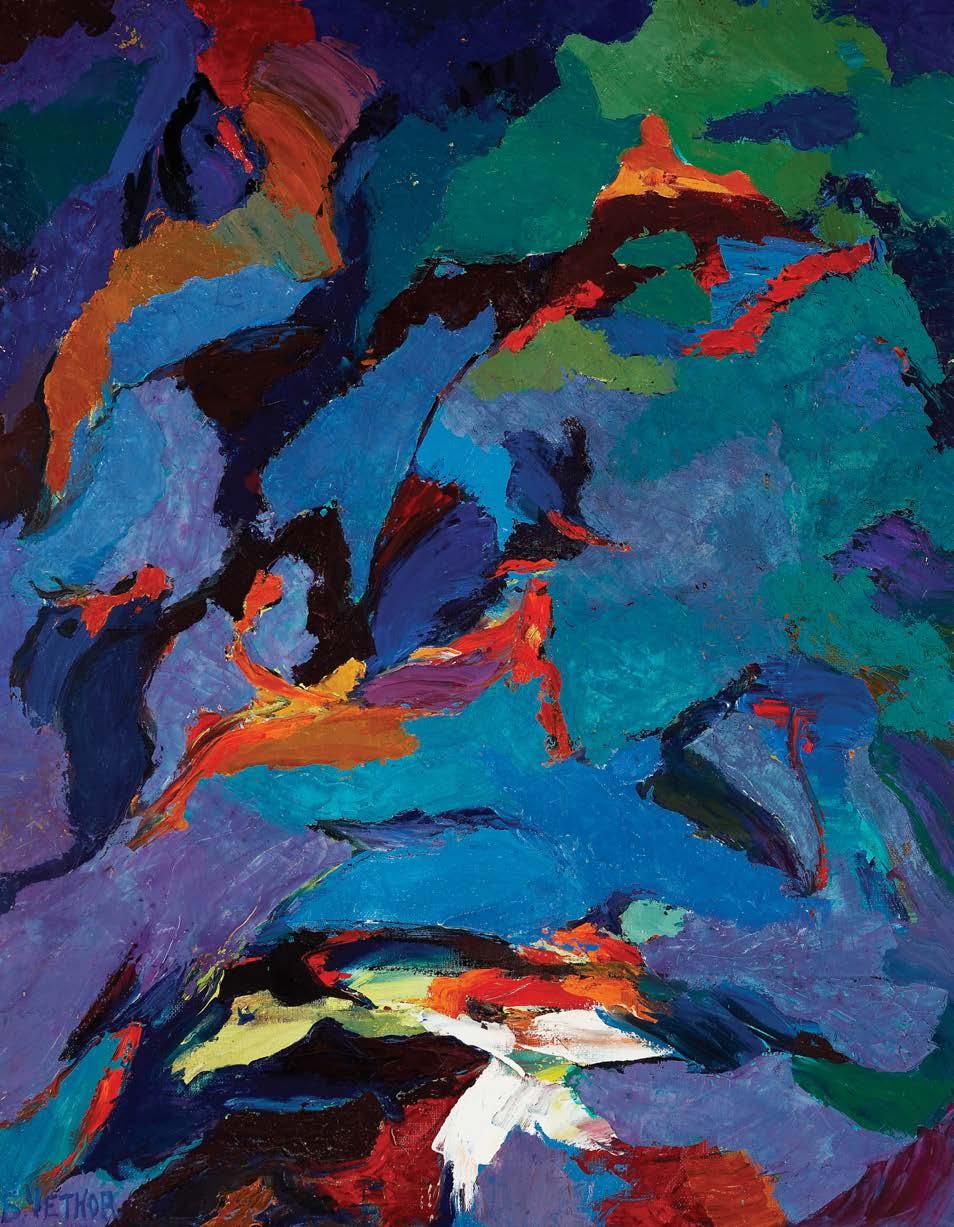
Бег (Run)
Acrylic on Canvas, 2002, 37 × 29 inches (92 cm × 72 cm)
Chetkov strove to explore and communicate the unique colour relationships in the world around him. He once wrote, “I wallow in nature’s colour relationships.” He related closely with Kandinsky who famously noted, “Colour is the keyboard, the eyes are the hammers, the soul is the piano with many strings. The artist is the hand that plays, touching one key or another purposely, to cause vibrations to the soul.
Theodora Clarke
Russian Art Scholar
The Courtauld Institute of Art, London
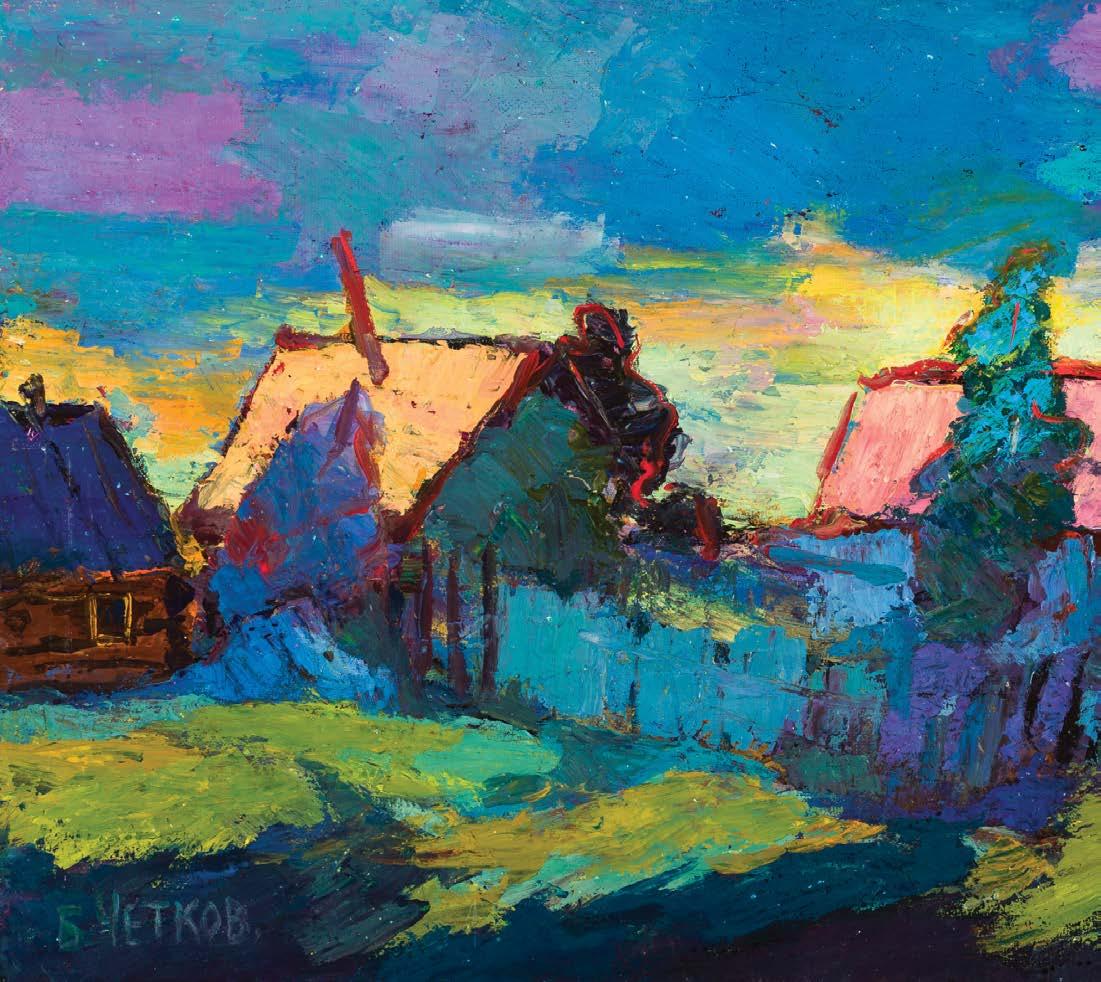
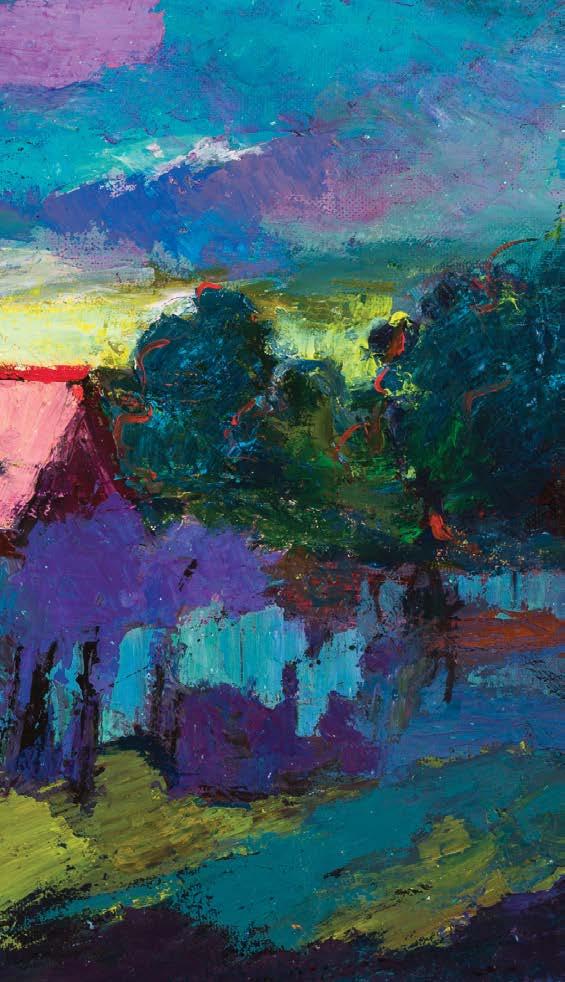
Ностальгия (Nostalgia)
Acrylic on Canvas, 2002, 22 × 37 inches (55 cm × 93 cm)
Chetkov’s landscapes are often far removed from the joyless collective farms of the Soviet Era. Nostalgia embellishes a memory from his happy childhood, before the travails of being torn from his ancestral home and subjected to forced labor during Stalin’s ‘Great Terror’ of the 1930s. Dreamlike and hallucinatory, the painting is exemplary of the strong fauvist tendencies seen in many of Chetkov’s landscapes, portraits and still lifes.
Theodora Clarke
Russian Art Scholar
The Courtauld Institute of Art, London

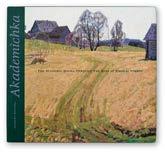

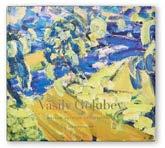
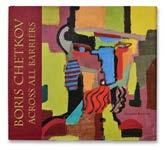
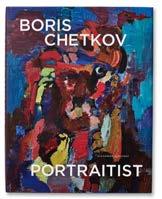
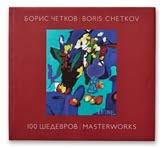
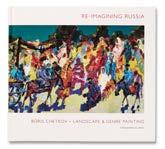
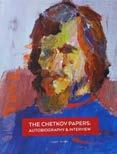
Pushkin Group Publications:
Seasons of Timkov, 1998
Dr. Alexander Borovsky, Dr. Alexander Shedrinsky
Akademichka: The Academic Dacha Through the Eyes of Nikolai Timkov, 1999
Dr. Alexander Borovsky, Dr. Albert Kostenevich
Vasily Golubev, Master Russian Expressionist, 2005
Dr. Alexander Borovsky, Dr. Albert Kostenevich
Boris Chetkov: Across All Barriers, 2006
Dr. Alexander Borovsky, Dr. Albert Kostenevich
Boris Chetkov, Portraitist, 2008
Dr. Alexander Borovsky, Dr. Albert Kostenevich
100 Masterworks, 2012
Dr. Alexander Borovsky
Re-Imagining Russia: Landscape and Genre Paintings of Boris Chetkov, 2013
Theodora Clarke
The Chetkov Papers
Autobiography and Interview, 2009
pushkincollection.com borischetkov.com pushkingallery.com pushkinfund.com
Wikipedia:
https://en.wikipedia.org/wiki/Boris_Chetkov Nikolai Timkov
https://en.wikipedia.org/wiki/Vasily_Golubev_(painter)
https://en.wikipedia.org/wiki/Nikolai_Timkov
Editors Notes:
• The term ‘Panel’ as used herein (Oil on Panel / Acrylic on Panel ) refers to works on archival art board panels or canvas panel board, which have been utilized as a traditional surface for Russian painters over the past 100 years. Each work on panel is reversibly mounted to a 4-ply acid free cotton rag board, then adhered to a 3/4” (1.9 cm) kiln dried basswood strainer — in keeping with museum standards.
• The paintings for each artist in this publication are generally presented in chronological order
• The works presented herein represent only a portion of the full extent of the Pushkin Collection.
Copyright Pushkin Group Ltd, 2024. All Rights Reserved